OK3576-C_User’s Hardware Manual_V1.5
Document classification: □ Top secret □ Secret □ Internal information ■ Open
Copyright
The copyright of this manual belongs to Baoding Folinx Embedded Technology Co., Ltd. Without the written permission of our company, no organizations or individuals have the right to copy, distribute, or reproduce any part of this manual in any form, and violators will be held legally responsible.
Forlinx adheres to copyrights of all graphics and texts used in all publications in original or license-free forms.
The drivers and utilities used for the components are subject to the copyrights of the respective manufacturers. The license conditions of the respective manufacturer are to be adhered to. Related license expenses for the operating system and applications should be calculated/declared separately by the related party or its representatives.
Application Scope
It is only applicable to Forlinx OK3576-C development board..
Revision History
Date |
User Manual Version |
SoM Version |
Carrier Board Version |
Revision History |
|---|---|---|---|---|
01/12/2025 |
V1.5 |
V1.3 |
V1.4 |
Adding SoM power management upgrade solution: |
21/11/2025 |
V1.4 |
V1.3 |
V1.4 |
Adding section 2.8.2: Design Guide for Vibration Resistance of the SoM. |
07/05/2025 |
V1.3 |
V1.3 |
V1.4 |
1. Carrier board design updating: (Refer to the latest schematic for details; |
09/10/2024 |
V1.2 |
V1.1 |
V1.1 |
Updating Linux system power consumption parameter. |
24/07/2024 |
V1.1 |
V1.1 |
V1.1 and above |
1. Correcting the description of the SoM pin functions; |
07/05/2024 |
V1.0 |
V1.0 |
V1.0 |
OK3576-C User’s Hardware Manual Initial Version. |
Overview
This manual is designed to help users quickly familiarize themselves with the product, understand interface functions and configuration, and primarily discusses the interface functions of the development board, interface introductions, product power consumption, and troubleshooting issues that may arise during use. Some commands were commented to make it easier for users to understand (Adequate and practical for the purpose). For issues related to pin function multiplexing, hardware problem troubleshooting methods, etc., please refer to the “FET3576-C Pin Multiplexing Comparison Table” and the “FET3576-C Design Guide” provided by Forlinx.
There are total four chapters:
Chapter 1. is CPU overview, briefly introducing its performance and applications;
Chapter 2. is comprehensive introduction to the SoM, including connector pins explanations and function introductions;
Chapter 3. is comprehensive introduction to the development board, divided into multiple chapters, including both hardware principles and simple design ideas;
Chapter 4. mainly describes the board’s power consumption performance and other considerations.
1. RK3576 Description
It is a high - performance, low - power application processor chip that integrates four Cortex - A72 cores, four Cortex - A53 cores, and an independent NEON coprocessor. It is suitable for ARM PC, edge computing, personal mobile Internet devices, and other multimedia products.
RK3576 incorporates a variety of powerful embedded hardware engines, providing excellent performance for high - end applications. It supports H.265, VP9, AVS2, and AV1 decoders at 4K@120fps and the H.264 decoder at 4K@60fps. It also supports H.264 and H.265 encoders at 4K@60fps, a high - quality JPEG encoder/decoder, and dedicated image pre - processors and post - processors.
It has a built - in 3D GPU that is fully compatible with OpenGL ES1.1/2.0/3.2, OpenCL 2.0, and Vulkan 1.1. A special 2D hardware engine with an MMU maximizes display performance and offers a smooth operating experience.
It introduces a new - generation, fully hardware - based ISP (Image Signal Processor) with a maximum of 16M pixels, implementing a variety of algorithm accelerators such as HDR, 3A, CAC, 3DNR, 2DNR, sharpening, dehazing, enhancement, fisheye correction, and gamma correction.
The embedded NPU supports mixed operations of INT4/INT8/INT16/FP16/BF16/TF32. Moreover, thanks to its strong compatibility, it can easily convert network models based on a series of frameworks like TensorFlow, MXNet, PyTorch, and Caffe.
RK3576 features a high - performance external memory interface (LPDDR4/LPDDR4X/LPDDR5), capable of meeting demanding memory bandwidth requirements (supporting systems with high memory bandwidth demands). It also provides a complete set of peripheral interfaces to flexibly support various applications.
Target Applications:
Information Release Terminals
Intelligent Cabin
Smart Screen
AR/VR
Edge Computing
High-end IPC
Smart NVR
Premium Pad
ARM PC
……
RK3576 Processor Block Diagram
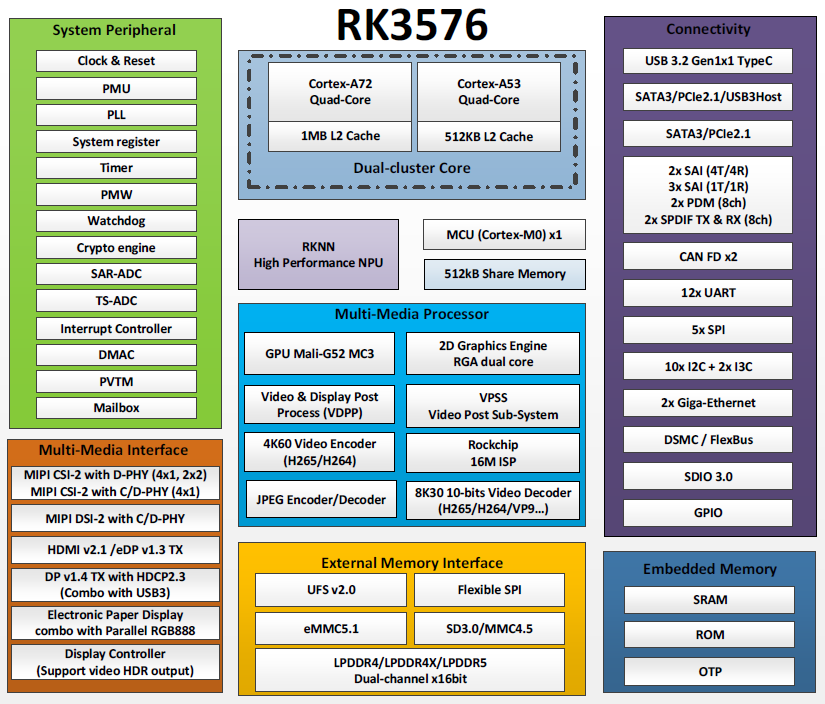
2. FET3588-C SoM Description
2.1 FET3576-C SoM
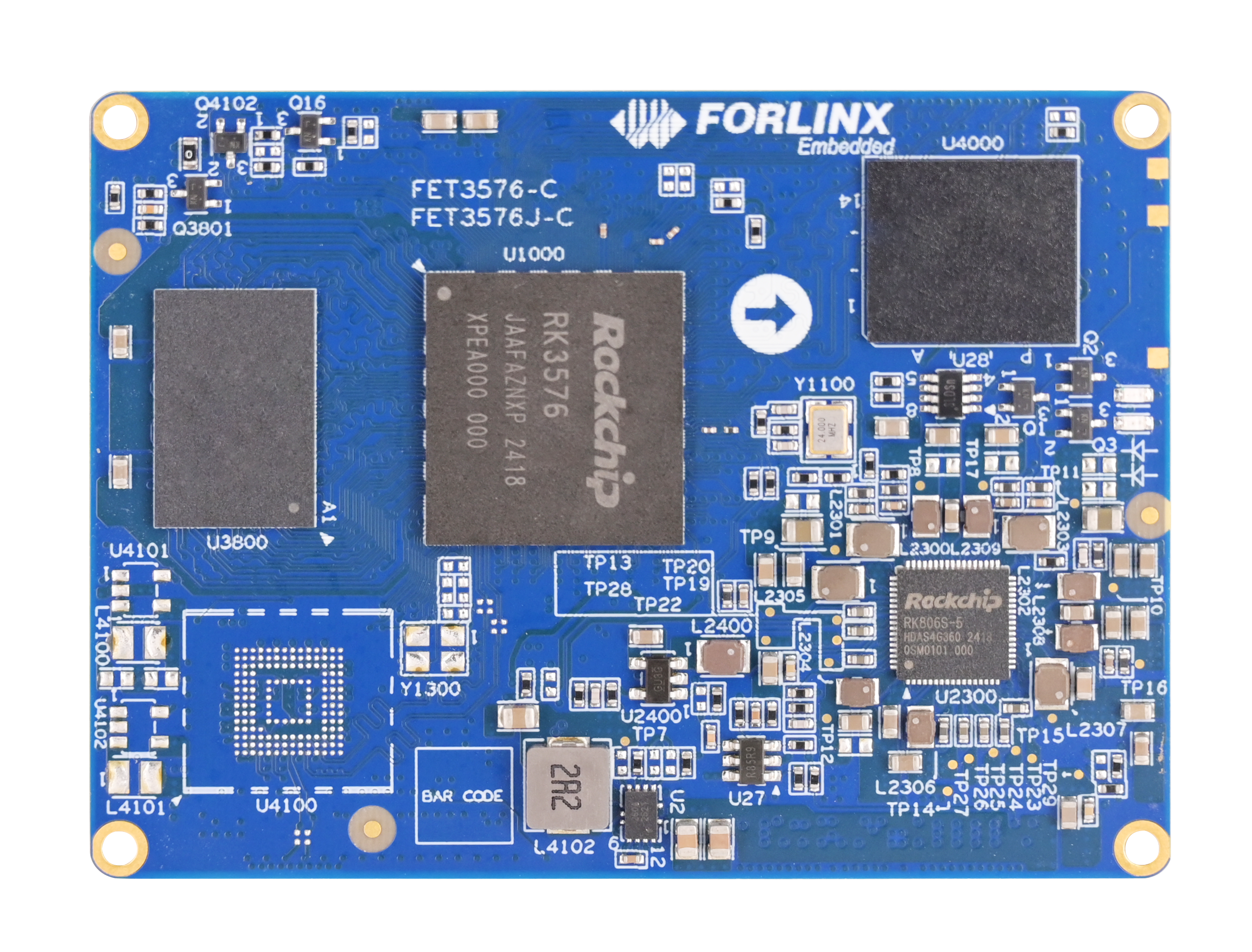
Front
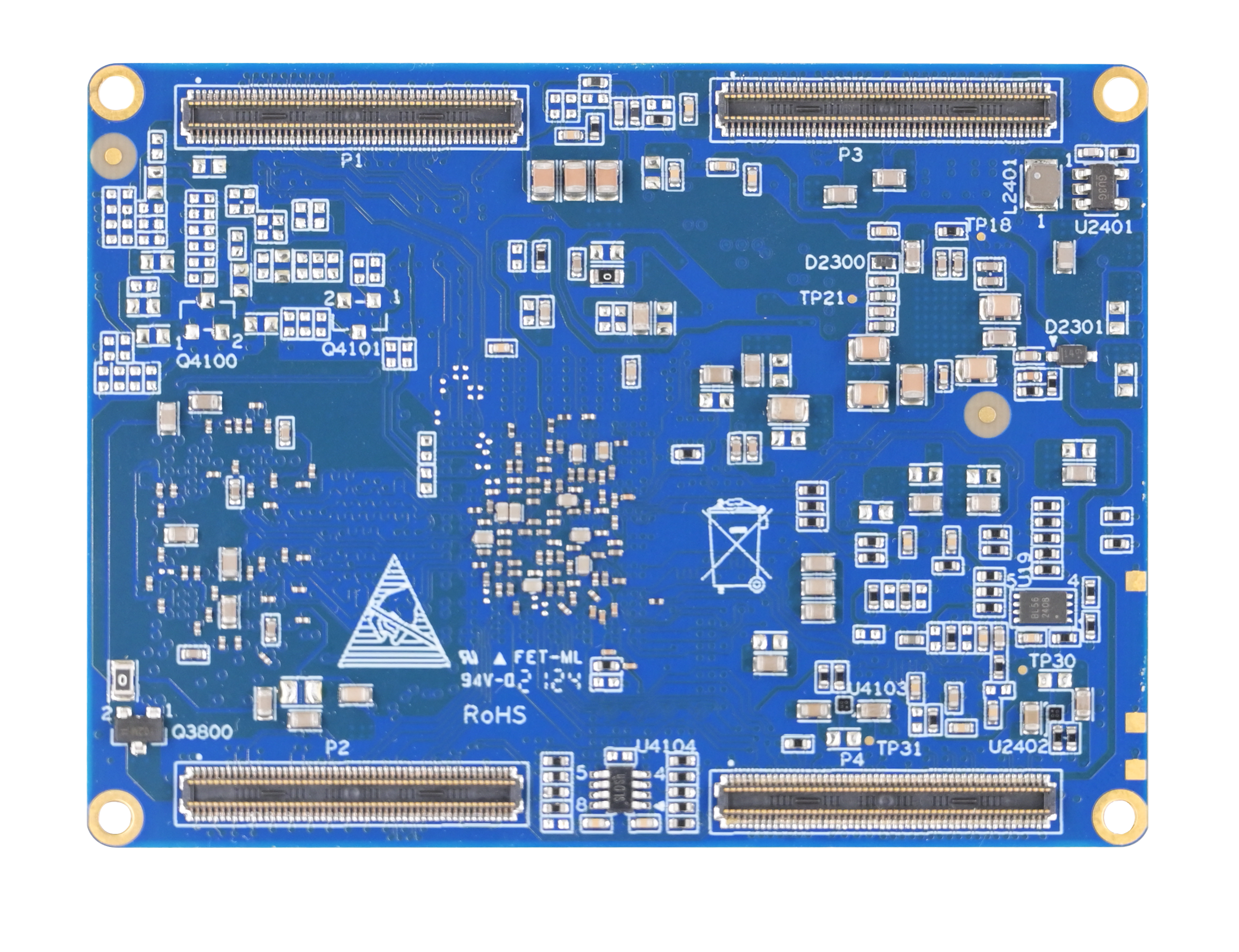
Back
2.2 FET3576-C SoM Dimension Diagram
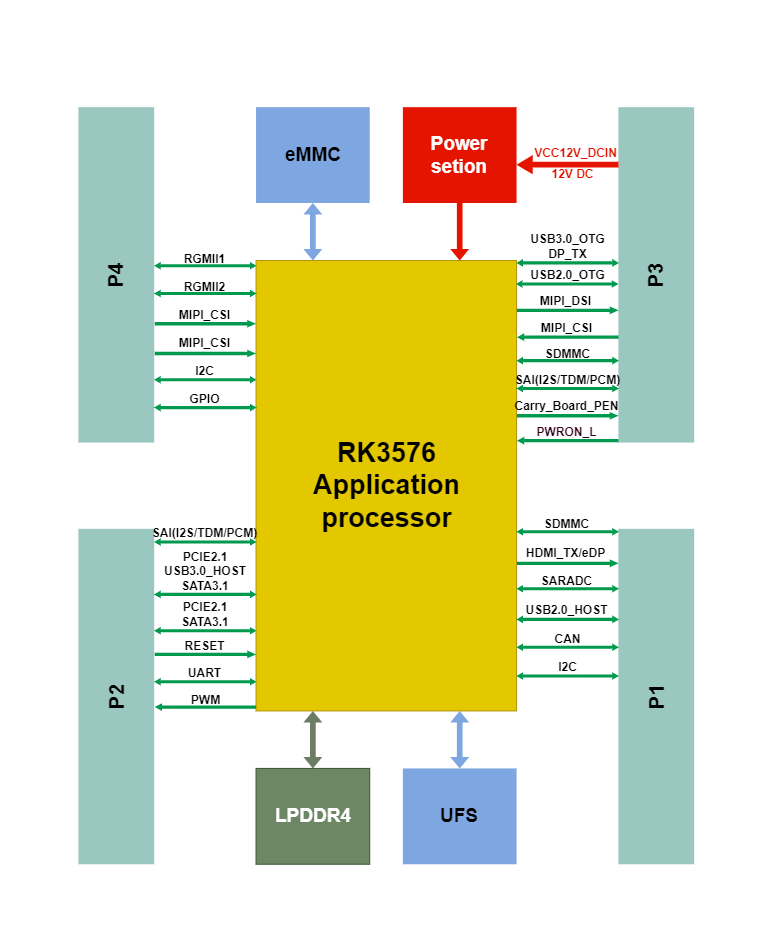
SoM
2.3 FET3576-C SoM Dimension Diagram
FET3576-C SoM Dimension Diagram
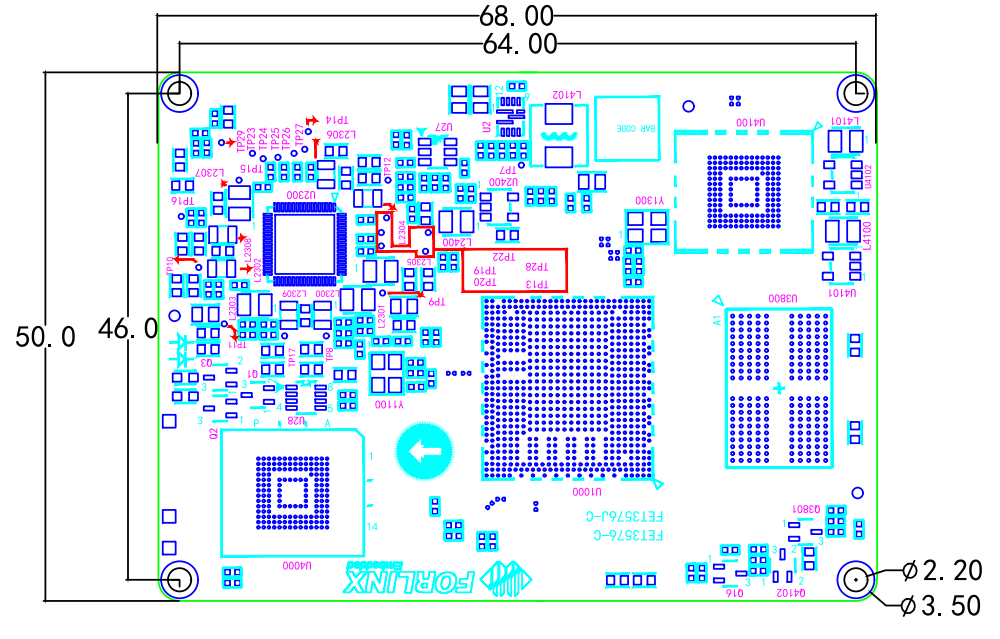
Top Layer Dimension Diagram
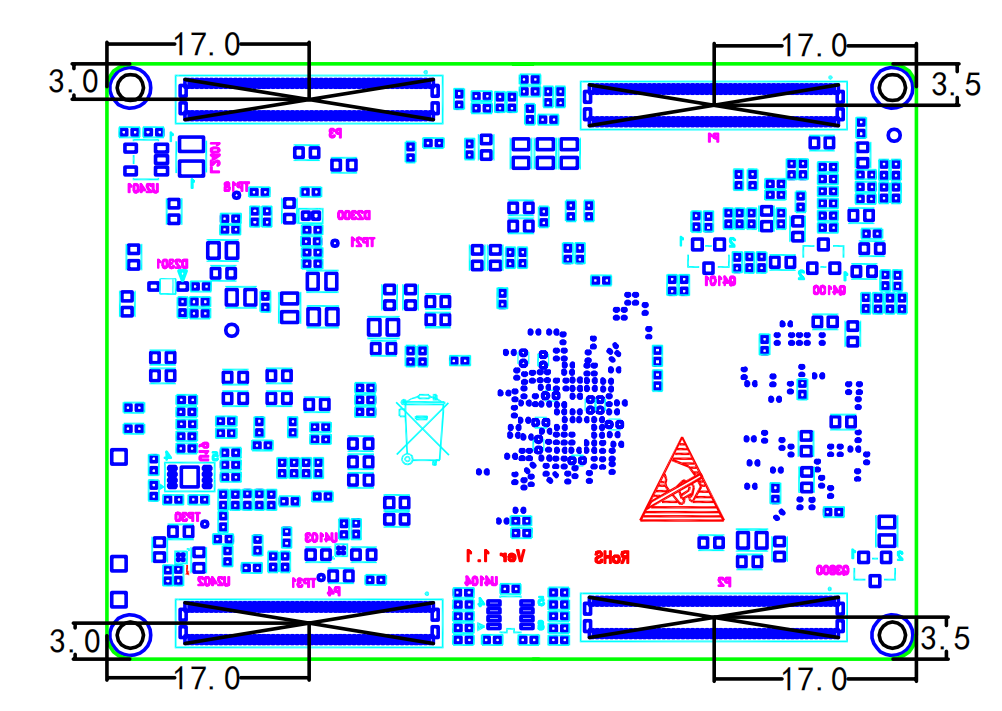
Bottom Layer Dimension Diagram
Unit:mm
Structural dimensions: 68mm × 50mm, dimensional tolerance ± 0.15 mm; for more detailed dimensions, please refer to the user information DXF structural documents.
Plate making process: 1.6mm thickness, 10-layer immersion gold PCB.
Connector: Four 0.4mm pitch, 100pin board-to-board connectors. Refer to Appendix for the connector dimension diagram.
Four mounting holes (2.2mm) are reserved at the four corners of the SoM to facilitate the installation of fixing screws and to improve the reliability of the product connection so that the product can be used in vibration environments.
Please refer to the development board design and use SMT nuts of M2 with a length (L) of 1.5 mm on the carrier board. Please refer to the following figure for the specifications of the SMT nuts.
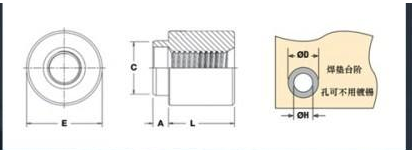

2.4 Performance Parameters
2.4.1 System Main Frequency
Name |
Specification |
Description |
|||
|---|---|---|---|---|---|
Minimum |
Typical |
Maximum |
Unit |
||
System Frequency Arm® Cortex®-A72 |
- |
- |
2300 |
MHz |
- |
System Frequency Arm® Cortex®-A53 |
- |
- |
2200 |
MHz |
|
System Frequency Arm® Cortex®-M0 |
- |
- |
- |
- |
- |
2.4.2 Power Parameter
Parameter |
Pin Number |
Specification |
Description |
|||
|---|---|---|---|---|---|---|
Minimum |
Typical |
Maximum |
Unit |
|||
Main Power Supply Voltage |
12V |
5V |
12 |
13V |
V |
- |
2.4.3 Operating Environment
Parameter |
Specification |
Description |
||||
|---|---|---|---|---|---|---|
Minimum |
Typical |
Maximum |
Unit |
|||
Operating Temperature |
Operating Environment |
0 |
25 |
80 |
℃ |
Commercial level |
Storage Environment |
-40 |
25 |
+125 |
℃ |
||
Humidity |
Operating Environment |
10 |
- |
90 |
%RH |
No condensation |
Storage Environment |
5 |
- |
95 |
%RH |
2.4.4 SoM Interface Speed
Parameter |
Specification |
Description |
|||
|---|---|---|---|---|---|
Minimum |
Typical |
Maximum |
Unit |
||
Serial Port Communication Speed |
- |
115200 |
4M |
bps |
- |
SPI Clock Frequncey |
- |
- |
50 |
MHz |
- |
I2C Communication Speed |
- |
100 |
400 |
Kbps |
- |
USB3.0 Interface Speed |
- |
- |
5 |
Gbps |
- |
USB2.0 Interface Speed |
- |
- |
480 |
Mbps |
- |
CAN Communication Speed |
- |
- |
1 |
Mbps |
- |
PCIe2.1 |
- |
- |
5 |
Gbps |
- |
2.4.5 ESD Features
Parameter |
Specification |
Unit |
Application Scope |
|
|---|---|---|---|---|
Minimum |
Maximum |
|||
ESD HBM(ESDA/JEDEC JS-001-2017) |
-2000 |
2000 |
V |
Signals exported from SoM |
ESD CDM(ESDA/JEDEC JS-002-2018) |
-250 |
250 |
V |
Signals exported from SoM |
Note:
The above data is provided by Rockchip;
As all the signals exported from SoM are electrostatic sensitive signals, the interfaces should be well protected from static electricity in the carrier board design and the SoM transportation, assembling, and use.
2.5 SoM Interface Speed
FET3576-C SoM Interfaces:
Function |
Quantity |
Parameter |
|---|---|---|
MIPI CSI |
5 |
·Supports 5 x CSI - 2 interfaces; |
DVP |
1 |
·8/10/12/16-bit standard DVP interface, up to 150MHz data input; |
HDMI/eDP TX |
1 *1 |
·Supports 1 x combined HDMI/eDP TX interface; |
DP TX |
1 *1 |
·Supports 1 combined USB/DP interface. |
MIPI DSI |
1 *1 |
·Supports 1 x MIPI DSI - 2 TX interface; |
Parallel |
1 *1 |
·Supports 1 x parallel output interface; |
EBC |
1 *1 |
·Supports 1 x EBC output interface; |
SAI |
≤5 |
·Supports 5 x SAI interfaces; |
SPDIF TX |
≤2 |
· Supports 2 x SPDIF TX ports; |
SPDIF RX |
≤2 |
· Supports 2 x SPDIF RX ports; |
PDM |
≤2 |
· Up to 8 channels, audio resolution from 16 to 24 bits, sampling rate up to 192Khz; |
Ethernet |
≤2 |
·2 x GMAC, with led out RGMII / RMII interfaces; |
Combo high speed interface |
2 |
·Supports 1 x PCIe2.1/SATA3.1 interface with one data lane; |
USB 2.0 OTG |
2 |
·Supports 2 x USB2.0 OTG |
SDIO |
≤2 |
·SDIO v3.0,4-bit data bus widths |
SPI |
≤5 |
·Supports two chip-select in each interface; |
I2C |
≤9 |
·Supports both 7 - bit and 10 - bit address modes; |
I3C |
≤2 |
·Supports 2 x I3C master ports; |
UART |
≤12 |
·2 x built - in 64 - bit FIFO, which can be used for TX and RX respectively; |
CAN |
≤2 |
·Complies with CAN and CAN FD specifications; |
DSMC |
≤1 |
·Supports up to select 4 chips; |
FlexBus |
≤1 |
·Supports built-in DMA and ping-pong operation for allocating two address; |
PWM |
≤16 |
·Supports up to 16 on-chip PWM with interrupt-based operation and capture mode; |
ADC |
≤8 |
·Supports 8 x 12bit single-ended input SAR-ADC with sampling rate up to 1MS/s; |
GPIO |
n |
·All GPIO pins can be used to generate interrupts; |
Note:
The parameters in the table are the theoretical values of hardware design or CPU. The interfaces have GPIO multiplexing, and the quantity mentioned is the theoretical maximum.
*1. Video Port ·Video Port0 supports up to 4K@120Hz with 10 bit data
·Video Port1 supports up to 2560x1600@60Hz with 10-bit data
·Video Port2 supports up to 1920x1080@60Hz with 8-bit data
·Each Video Port may connect to any of HDMI/eDP/DP/DSI-2
·Port1 and Port2 may connect to parallel output interface
*2. The maximum clock of a single TDM design is 50MHz. When using the TDM mode, the theoretical number of supported audio channels can be calculated by combining the audio sampling frequency and resolution to see if it meets the project requirements.
2.6 FET3576-C SoM Pins Definition
2.6.1 FET3576-C SoM Pins Schematic
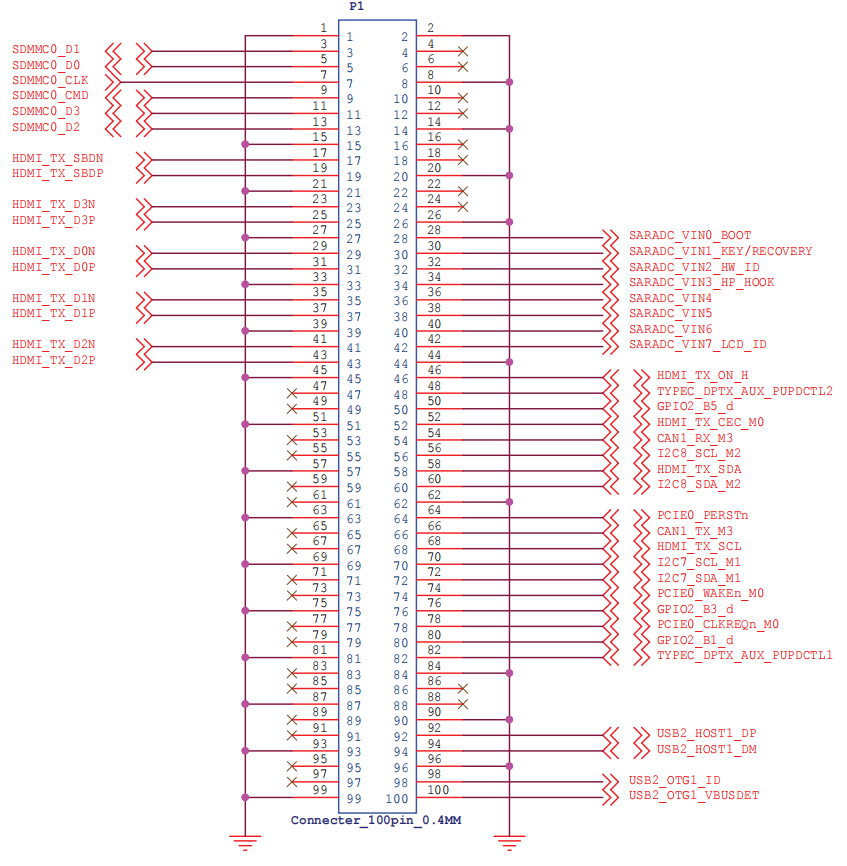
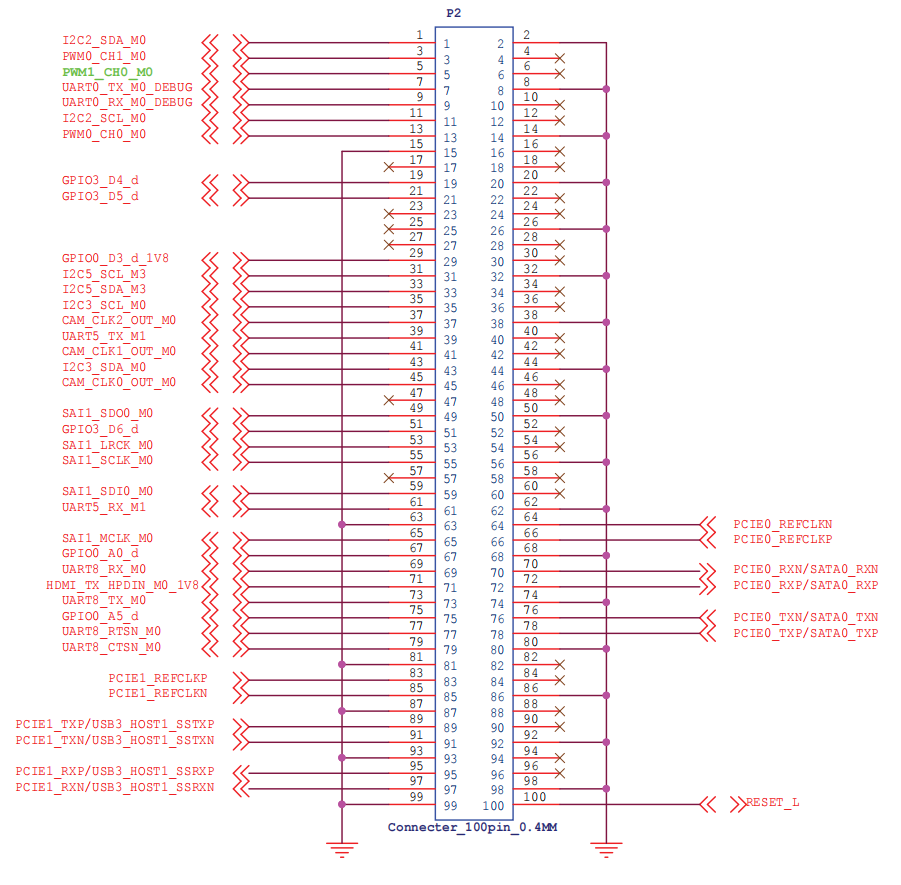
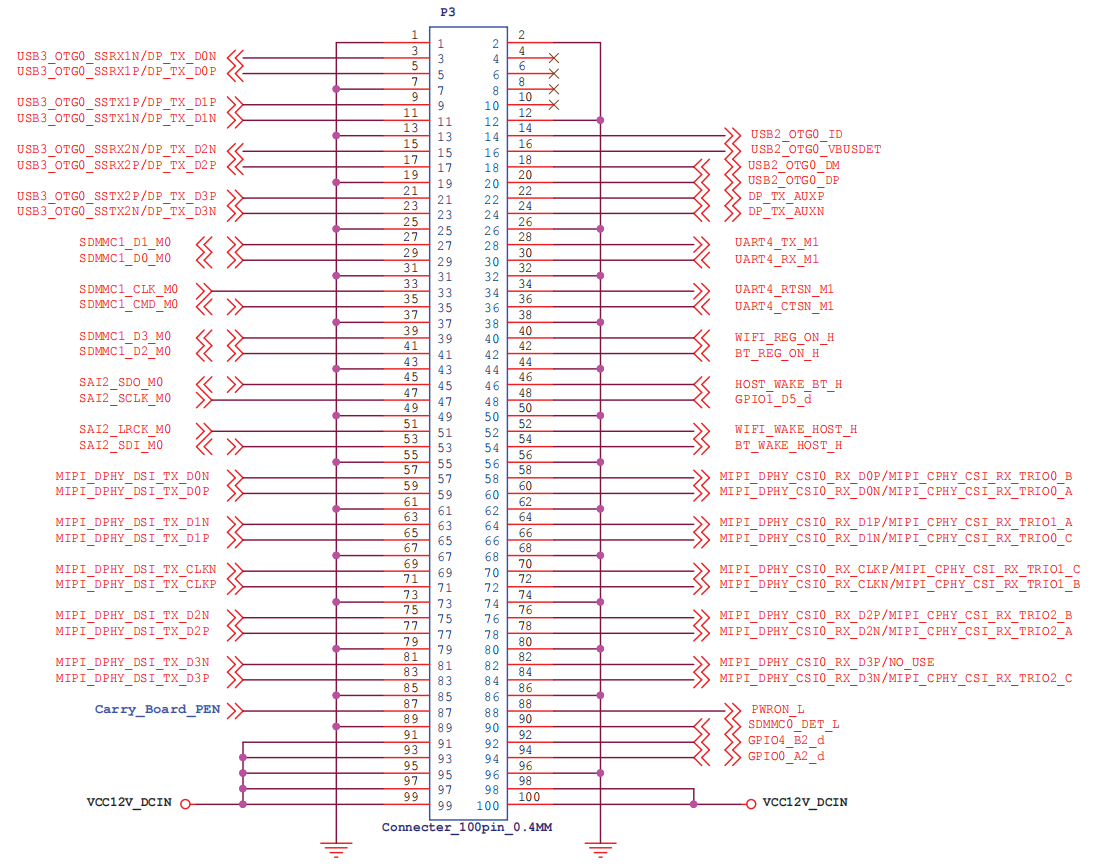
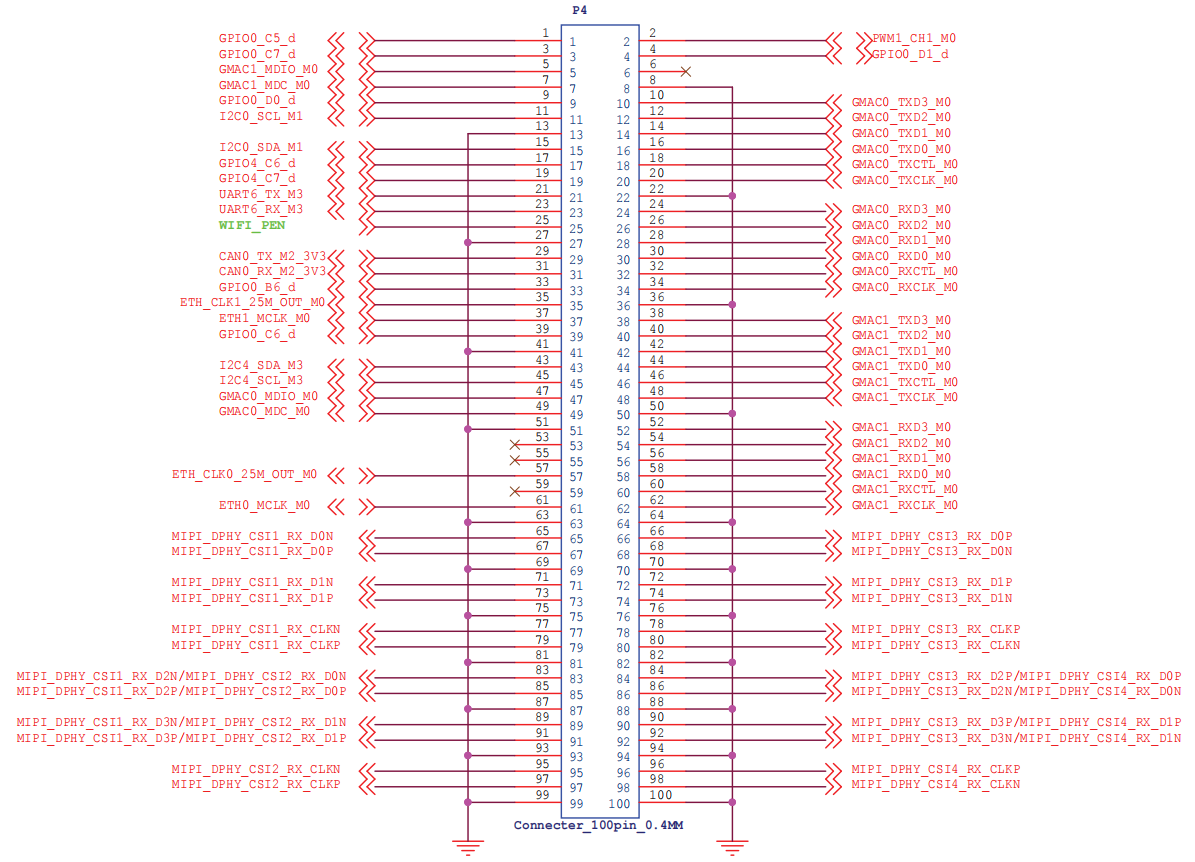
2.6.2 FET3576-C SoM Pins Description
Note1:
Num ——SoM connector pin no.:
Ball —— CPU pin ball no.
GPIO ——CPU pin general I/O port serial number
Vol ——Pin signal level
Note2:
Signal Name——SoM connector network name, the top right corner subscripts’ meaning are as follows:
No. |
Superscript Description |
|---|---|
[1] |
Pins can be configured for interrupt use. |
[2] |
The default pin level is 1.8 V. |
[3] |
Pins are CPU boot-related pins, which are not recommended for IO. |
[4] |
Special-purpose pins and can not be used as IO. |
Pin Description—— SoM Pin Signal Descriptions
Default Function——Please don’t make any modifications for all SoM pin functions regulated in the “default functions” of the following table, otherwise, it may have conflicts with the factory driver. Please contact us with any questions in time.
Note3: The pins marked with “Do not use for carrier board” in the “Pin Description” are those used by the SoM, and should not be used in the carrier board design.
Table 1 P1 Connector Interface (Odd) Pin Definitions
NUM |
BALL |
Signal Name |
GPIO |
VOL |
Pin Description |
Default Function |
|---|---|---|---|---|---|---|
1 |
—— |
GND |
—— |
—— |
Ground |
GND |
3 |
B25 |
SDMMC_D1 |
1.8V/3.3V |
SD/MMC Interface data signal 1 |
SDMMC_D1 |
|
5 |
B24 |
SDMMC_D0 |
1.8V/3.3V |
SD/MMC Interface data signal 0 |
SDMMC_D0 |
|
7 |
1B21 |
SDMMC_CLK |
1.8V/3.3V |
SD/MMC Interface clock signal |
SDMMC_CLK |
|
9 |
1A21 |
SDMMC_CMD |
1.8V/3.3V |
SD/MMC Interface order signal |
SDMMC_CMD |
|
11 |
B23 |
SDMMC_D3 |
1.8V/3.3V |
SD/MMC Interface data signal 3 |
SDMMC_D3 |
|
13 |
A23 |
SDMMC_D2 |
1.8V/3.3V |
SD/MMC Interface data signal 2 |
SDMMC_D2 |
|
15 |
—— |
GND |
—— |
—— |
Ground |
GND |
17 |
2U12 |
HDMI_TX_SBDN |
—— |
—— |
HDMISBD signal- |
HDM0_TX_SBD_N |
19 |
2T12 |
HDMI_TX_SBDP |
—— |
—— |
HDMISBD signal+ |
HDM0_TX_SBD_P |
21 |
—— |
GND |
—— |
—— |
Ground |
GND |
23 |
AK26 |
HDMI_TX_D3N |
—— |
—— |
HDMI differential signal 3- |
HDMI_TX_D3_N |
25 |
AL26 |
HDMI_TX_D3P |
—— |
—— |
HDMI differential signal 3+ |
HDMI_TX_D3_P |
27 |
—— |
GND |
—— |
—— |
Ground |
GND |
29 |
AK27 |
HDMI_TX_D0N |
—— |
—— |
HDMI differential signal 0- |
HDMI_TX_D0_N |
31 |
1AE24 |
HDMI_TX_D0P |
—— |
—— |
HDMI differential signal 0+ |
HDMI_TX_D0_P |
33 |
—— |
GND |
—— |
—— |
Ground |
GND |
35 |
AL28 |
HDMI_TX_D1N |
—— |
—— |
HDMI differential signal 1- |
HDMI_TX_D1_N |
37 |
AK28 |
HDMI_TX_D1P |
—— |
—— |
HDMI differential signal 1+ |
HDMI_TX_D1_P |
39 |
—— |
GND |
—— |
—— |
Ground |
GND |
41 |
AK29 |
HDMI_TX_D2N |
—— |
—— |
HDMI differential signal 2- |
HDMI_TX_D2_N |
43 |
AJ28 |
HDMI_TX_D2P |
—— |
—— |
HDMI differential signal 2+ |
HDMI_TX_D2_P |
45 |
—— |
GND |
—— |
—— |
Ground |
GND |
47 |
—— |
—— |
—— |
—— |
||
49 |
—— |
—— |
—— |
—— |
||
51 |
—— |
GND |
—— |
—— |
Ground |
GND |
53 |
—— |
—— |
—— |
—— |
||
55 |
—— |
—— |
—— |
—— |
||
57 |
—— |
GND |
—— |
—— |
Ground |
GND |
59 |
—— |
—— |
—— |
—— |
||
61 |
—— |
—— |
—— |
—— |
||
63 |
—— |
GND |
—— |
—— |
Ground |
GND |
65 |
—— |
—— |
—— |
—— |
||
67 |
—— |
—— |
—— |
—— |
||
69 |
—— |
GND |
—— |
—— |
Ground |
GND |
71 |
—— |
—— |
—— |
—— |
||
73 |
—— |
—— |
—— |
—— |
||
75 |
—— |
GND |
—— |
—— |
Ground |
GND |
77 |
—— |
—— |
—— |
—— |
||
79 |
—— |
—— |
—— |
—— |
||
81 |
—— |
GND |
—— |
—— |
Ground |
GND |
83 |
—— |
—— |
—— |
—— |
||
85 |
—— |
—— |
—— |
—— |
||
87 |
—— |
GND |
—— |
—— |
Ground |
GND |
89 |
—— |
—— |
—— |
—— |
||
91 |
—— |
—— |
—— |
—— |
||
93 |
—— |
GND |
—— |
—— |
Ground |
GND |
95 |
—— |
—— |
—— |
—— |
||
97 |
—— |
—— |
—— |
—— |
||
99 |
—— |
GND |
—— |
—— |
Ground |
GND |
Table 2 P1 Connector Interface (Even) Pin Definitions
NUM |
BALL |
Signal Name |
GPIO |
VOL |
Pin Description |
Default Function |
|---|---|---|---|---|---|---|
2 |
—— |
GND |
—— |
—— |
Ground |
GND |
4 |
—— |
—— |
—— |
—— |
—— |
—— |
6 |
—— |
—— |
—— |
—— |
—— |
—— |
8 |
—— |
GND |
—— |
—— |
Ground |
GND |
10 |
—— |
—— |
—— |
—— |
—— |
—— |
12 |
—— |
—— |
—— |
—— |
—— |
—— |
14 |
—— |
GND |
—— |
—— |
Ground |
GND |
16 |
—— |
—— |
—— |
—— |
—— |
—— |
18 |
—— |
—— |
—— |
—— |
—— |
—— |
20 |
—— |
GND |
—— |
—— |
Ground |
GND |
22 |
—— |
—— |
—— |
—— |
—— |
—— |
24 |
—— |
—— |
—— |
—— |
—— |
—— |
26 |
—— |
GND |
—— |
—— |
Ground |
GND |
28 |
A25 |
SARADC_VIN0_BOOT |
—— |
1.8V |
BOOT start configuration input |
SARADC_VIN0_BOOT |
30 |
1A22 |
SARADC_VIN1_KEY/RECOVERY |
—— |
1.8V |
General ADC1 |
SARADC_VIN1_KEY/RECOVERY |
32 |
1B19 |
SARADC_VIN2_HW_ID |
—— |
1.8V |
General ADC2 |
SARADC_VIN2_HW_ID |
34 |
1C19 |
SARADC_VIN3_HP_HOOK |
—— |
1.8V |
General ADC3 |
SARADC_VIN3_HP_HOOK |
36 |
1E18 |
SARADC_VIN4 |
—— |
1.8V |
General ADC4 |
SARADC_VIN4 |
38 |
1D19 |
SARADC_VIN5 |
—— |
1.8V |
General ADC5 |
SARADC_VIN5 |
40 |
1D21 |
SARADC_VIN6 |
—— |
1.8V |
General ADC6 |
SARADC_VIN6 |
42 |
1E19 |
SARADC_VIN7_LCD_ID |
—— |
1.8V |
General ADC7 |
SARADC_VIN7_LCD_ID |
44 |
—— |
GND |
—— |
—— |
Ground |
GND |
46 |
B19 |
HDMI_TX_ON_H |
3.3V |
HDMI_TX start signal |
HDMI_TX_ON_H |
|
48 |
B20 |
TYPEC_DPTX_AUX_PUPDCTL2 |
3.3V |
TYPEC_DPTX_AUX_PUPDCTL22 signal |
TYPEC_DPTX_AUX_PUPDCTL2 |
|
50 |
1C18 |
GPIO2_B5_d |
3.3V |
USB_HUB_RST_3V3 reset signal |
USB_HUB_RST_3V3 |
|
52 |
AK3 |
HDMI_TX_CEC_M0 |
3.3V |
HDMICEC signal |
HDMI_TX_CEC_M0 |
|
54 |
1A19 |
CAN1_RX_M3 |
3.3V |
CAN1 data receiving |
CAN1_RX_M3_3V3 |
|
56 |
A21 |
I2C8_SCL_M2 |
3.3V |
I2C8 clock |
I2C8_SCL_M2 |
|
58 |
1AE2 |
HDMI_TX_SDA |
3.3V |
HDMI serial data |
HDMI_TX_SDA |
|
60 |
B21 |
I2C8_SDA_M2 |
3.3V |
I2C8 data |
I2C8_SDA_M2 |
|
62 |
—— |
GND |
—— |
—— |
Ground |
GND |
64 |
A19 |
PCIE0_PERSTn |
3.3V |
PCIE reset signal |
PCIE0_PERSTn |
|
66 |
1A20 |
CAN1_TX_M3 |
3.3V |
CAN1 data sending |
CAN1_TX_M3_3V3 |
|
68 |
AL2 |
HDMI_TX_SCL |
3.3V |
HDMI Serial clock |
HDMI_TX_SCL |
|
70 |
1D16 |
I2C7_SCL_M1 |
3.3V |
I2C7 clock |
I2C7_SCL_M1 |
|
72 |
1B18 |
I2C7_SDA_M1 |
3.3V |
I2C7 data |
I2C7_SDA_M1 |
|
74 |
1Y22 |
PCIE0_WAKEn_M0 |
3.3V |
PCIE wake-up activation signal |
PCIE0_WAKEn_M0 |
|
76 |
1B16 |
GPIO2_B3_d |
3.3V |
4G/5G module reset signal |
4G/5G_PWREN |
|
78 |
1A17 |
PCIE0_CLKREQn_M0 |
3.3V |
PCIE clock request signal |
PCIE0_CLKREQn_M0 |
|
80 |
1A18 |
GPIO2_B1_d |
3.3V |
4G/5G module power control reset signal |
4G/5G_MOD_PWREN |
|
82 |
B22 |
TYPEC_DPTX_AUX_PUPDCTL1 |
3.3V |
TYPEC_DPTX_AUX_PUPDCTL1 signal |
TYPEC_DPTX_AUX_PUPDCTL1 |
|
84 |
—— |
GND |
—— |
—— |
Ground |
GND |
86 |
—— |
—— |
—— |
—— |
—— |
—— |
88 |
—— |
—— |
—— |
—— |
—— |
—— |
90 |
—— |
GND |
—— |
—— |
Ground |
GND |
92 |
2T4 |
USB2_HOST1_DP |
—— |
—— |
USB20_HOST1 data+ |
USB20_HOST1_D_P |
94 |
2T5 |
USB2_HOST1_DM |
—— |
—— |
USB20_HOST1 data- |
USB20_HOST1_D_N |
96 |
—— |
GND |
—— |
—— |
Ground |
GND |
98 |
2T9 |
USB2_OTG1_ID |
—— |
—— |
USB2_OTG1_ID signal |
x |
100 |
2T10 |
USB2_OTG1_VBUSDET |
—— |
—— |
USB2_OTG1_VBUSDET insertion detection |
USB2_OTG1_VBUSDET |
Table 3 P2 Connector Interface (Odd) Pin Definitions
NUM |
BALL |
Signal Name |
GPIO |
VOL |
Pin Description |
Default Function |
|---|---|---|---|---|---|---|
1 |
AB29 |
I2C2_SDA_M0 |
3.3V |
I2C2 data |
I2C2_SDA_M0 |
|
3 |
1W21 |
PWM0_CH1_M0 |
3.3V |
PWM0_CH1_M0 |
x |
|
5 |
AD28 |
PWM1_CH0_M0 |
3.3V |
PWM1_CH0_M0 |
x |
|
7 |
1U24 |
UART0_TX_M0_DEBUG |
3.3V |
UART0 sending |
UART0_TX_M0_DEBUG |
|
9 |
AA28 |
UART0_RX_M0_DEBUG |
3.3V |
UART0 receiving |
UART0_RX_M0_DEBUG |
|
11 |
1W24 |
I2C2_SCL_M0 |
3.3V |
I2C2 clock |
I2C2_SCL_M0 |
|
13 |
1W22 |
PWM0_CH0_M0 |
3.3V |
PWM0_CH0_M0 |
PWM0_CH0_M0(MIPI screen backlight PWM) |
|
15 |
—— |
GND |
—— |
—— |
Ground |
GND |
17 |
—— |
—— |
—— |
—— |
—— |
—— |
19 |
1E21 |
GPIO3_D4_d |
GPIO3_D4_d |
1.8V |
GMAC1_INT Interrupt |
GMAC1_INT |
21 |
1D10 |
GPIO3_D5_d |
GPIO3_D5_d |
1.8V |
GMAC1_RESET Reset |
GMAC1_RESET |
23 |
—— |
—— |
—— |
—— |
—— |
—— |
25 |
—— |
—— |
—— |
—— |
—— |
—— |
27 |
—— |
—— |
—— |
—— |
—— |
—— |
29 |
1AA23 |
GPIO0_D3_d_1V8 |
1.8V |
HP_DET_L headphone insertion detection |
HP_DET_L(headphone) |
|
31 |
1D9 |
I2C5_SCL_M3 |
1.8V |
I2C5 clock |
I2C5_SCL_M3 |
|
33 |
1B10 |
I2C5_SDA_M3 |
1.8V |
I2C5 Data |
I2C5_SDA_M3 |
|
35 |
1A4 |
I2C3_SCL_M0 |
1.8V |
I2C3 clock |
I2C3_SCL_M0 |
|
37 |
1B7 |
CAM_CLK2_OUT_M0 |
1.8V |
CAM_CLK2_OUT_M0 |
x |
|
39 |
1A5 |
UART5_TX_M1 |
1.8V |
UART5 Sending data |
UART5_TX_M1_1V8 |
|
41 |
1B12 |
CAM_CLK1_OUT_M0 |
1.8V |
CAM_CLK1_OUT_M0 |
x |
|
43 |
B8 |
I2C3_SDA_M0 |
1.8V |
I2C3 data |
I2C3_SDA_M0 |
|
45 |
1E7 |
CAM_CLK0_OUT_M0 |
1.8V |
CAM_CLK0_OUT_M0 |
x |
|
47 |
—— |
—— |
—— |
—— |
—— |
—— |
49 |
A7 |
SAI1_SDO0_M0 |
1.8V |
I2S Data output |
SAI1_SDO0_M0 |
|
51 |
1C10 |
GPIO3_D6_d |
1.8V |
4G/5G Reset |
4G/5G_RESET |
|
53 |
1B6 |
SAI1_LRCK_M0 |
1.8V |
I2S Sending frame clock |
SAI1_LRCK_M0 |
|
55 |
1C6 |
SAI1_SCLK_M0 |
1.8V |
I2S bit clock |
SAI1_SCLK_M0 |
|
57 |
—— |
—— |
—— |
—— |
—— |
—— |
59 |
1A6 |
SAI1_SDI0_M0 |
1.8V |
I2S Data input |
SAI1_SDI0_M0 |
|
61 |
B7 |
UART5_RX_M1 |
1.8V |
UART5 receiving data: |
UART5_RX_M1_1V8 |
|
63 |
—— |
GND |
—— |
—— |
Ground |
GND |
65 |
1D6 |
SAI1_MCLK_M0 |
1.8V |
I2S main clock |
SAI1_MCLK_M0 |
|
67 |
V29 |
GPIO0_A0_d |
1.8V |
IIC interrupt |
IIC_GPIO_INT |
|
69 |
1B9 |
UART8_RX_M0 |
1.8V |
UART8 receiving data: |
UART8_RX_M0_1V8 |
|
71 |
AK2 |
HDMI_TX_HPDIN_M0_1V8 |
1.8V |
HDMI Sending link detection |
HDMI_TX_HPDIN_M0_1V8 |
|
73 |
1D7 |
UART8_TX_M0 |
1.8V |
UART8 Sending data |
UART8_TX_M0_1V8 |
|
75 |
Y29 |
GPIO0_A5_d |
1.8V |
TYPEC0 Interrupt |
TYPEC0_INT |
|
77 |
1C7 |
UART8_RTSN_M0 |
1.8V |
UART8 request sending |
UART8_RTSN_M0_1V8 |
|
79 |
1C12 |
UART8_CTSN_M0 |
1.8V |
UART8 clear sending |
UART8_CTSN_M0_1V8 |
|
81 |
—— |
GND |
—— |
—— |
Ground |
GND |
83 |
1L23 |
PCIE1_REFCLKP |
—— |
—— |
PCIE1 clock output/input+ |
x |
85 |
1M23 |
PCIE1_REFCLKN |
—— |
—— |
PCIE1 clock output/input- |
x |
87 |
—— |
GND |
—— |
—— |
Ground |
GND |
89 |
N28 |
PCIE1_TXP/USB3_HOST1_SSTXP |
—— |
—— |
USB3_HOST1 sending differential+ |
USB3_HOST1_SSTXP |
91 |
N29 |
PCIE1_TXN/USB3_HOST1_SSTXN |
—— |
—— |
USB3_HOST1 sending differential- |
USB3_HOST1_SSTXN |
93 |
—— |
GND |
—— |
—— |
Ground |
GND |
95 |
M28 |
PCIE1_RXP/USB3_HOST1_SSRXP |
—— |
—— |
USB3_HOST1 receiving differential+ |
USB3_HOST1_SSRXP |
97 |
M29 |
PCIE1_RXN/USB3_HOST1_SSRXN |
—— |
—— |
USB3_HOST1 receiving differential- |
USB3_HOST1_SSRXN |
99 |
—— |
GND |
—— |
—— |
Ground |
GND |
Table 4 P2 Connector Interface (Even) Pin Definitions
NUM |
BALL |
Signal Name |
GPIO |
VOL |
Pin Description |
Default Function |
|---|---|---|---|---|---|---|
2 |
—— |
GND |
—— |
—— |
Ground |
GND |
4 |
—— |
—— |
—— |
—— |
—— |
—— |
6 |
—— |
—— |
—— |
—— |
—— |
—— |
8 |
—— |
GND |
—— |
—— |
Ground |
GND |
10 |
—— |
—— |
—— |
—— |
—— |
—— |
12 |
—— |
—— |
—— |
—— |
—— |
—— |
14 |
—— |
GND |
—— |
—— |
Ground |
GND |
16 |
—— |
—— |
—— |
—— |
—— |
—— |
18 |
—— |
—— |
—— |
—— |
—— |
—— |
20 |
—— |
GND |
—— |
—— |
Ground |
GND |
22 |
—— |
—— |
—— |
—— |
—— |
—— |
24 |
—— |
—— |
—— |
—— |
—— |
—— |
26 |
—— |
GND |
—— |
—— |
Ground |
GND |
28 |
—— |
—— |
—— |
—— |
—— |
—— |
30 |
—— |
—— |
—— |
—— |
—— |
—— |
32 |
—— |
GND |
—— |
—— |
Ground |
GND |
34 |
—— |
—— |
—— |
—— |
—— |
—— |
36 |
—— |
—— |
—— |
—— |
—— |
—— |
38 |
—— |
GND |
—— |
—— |
Ground |
GND |
40 |
—— |
—— |
—— |
—— |
—— |
—— |
42 |
—— |
—— |
—— |
—— |
—— |
—— |
44 |
—— |
GND |
—— |
—— |
Ground |
GND |
46 |
—— |
—— |
—— |
—— |
—— |
—— |
48 |
—— |
—— |
—— |
—— |
—— |
—— |
50 |
—— |
GND |
—— |
—— |
Ground |
GND |
52 |
—— |
—— |
—— |
—— |
—— |
—— |
54 |
—— |
—— |
—— |
—— |
—— |
—— |
56 |
—— |
GND |
—— |
—— |
Ground |
GND |
58 |
—— |
—— |
—— |
—— |
—— |
—— |
60 |
—— |
—— |
—— |
—— |
—— |
—— |
62 |
—— |
GND |
—— |
—— |
Ground |
GND |
64 |
1N23 |
PCIE0_REFCLKN |
—— |
—— |
PCIE0 clock output/input- |
PCIE0_REFCLKN |
66 |
1N22 |
PCIE0_REFCLKP |
—— |
—— |
PCIE0 clock output/input+ |
PCIE0_REFCLKP |
68 |
—— |
GND |
—— |
—— |
Ground |
GND |
70 |
R29 |
PCIE0_RXN/SATA0_RXN |
—— |
—— |
PCIE0 data receiving- |
PCIE0_RXN |
72 |
R28 |
PCIE0_RXP/SATA0_RXP |
—— |
—— |
PCIE0 data receiving+ |
PCIE0_RXP |
74 |
—— |
GND |
—— |
—— |
Ground |
GND |
76 |
P28 |
PCIE0_TXN/SATA0_TXN |
—— |
—— |
PCIE0 data sending- |
PCIE0_TXN |
78 |
P29 |
PCIE0_TXP/SATA0_TXP |
—— |
—— |
PCIE0 data sending+ |
PCIE0_TXP |
80 |
—— |
GND |
—— |
—— |
Ground |
GND |
82 |
—— |
—— |
—— |
—— |
—— |
—— |
84 |
—— |
—— |
—— |
—— |
—— |
—— |
86 |
—— |
GND |
—— |
—— |
Ground |
GND |
88 |
—— |
—— |
—— |
—— |
—— |
—— |
90 |
—— |
—— |
—— |
—— |
—— |
—— |
92 |
—— |
GND |
—— |
—— |
Ground |
GND |
94 |
—— |
—— |
—— |
—— |
—— |
—— |
96 |
—— |
—— |
—— |
—— |
—— |
—— |
98 |
—— |
GND |
—— |
—— |
Ground |
GND |
100 |
—— |
RESET_L |
—— |
—— |
Reset |
RESET_L |
Table 5 P3 Connector Interface (Odd) Pin Definitions
NUM |
BALL |
Signal Name |
GPIO |
VOL |
Pin Description |
Default Function |
|---|---|---|---|---|---|---|
1 |
—— |
GND |
—— |
—— |
Ground |
GND |
3 |
AL10 |
USB3_OTG0_SSRX1N/DP_TX_D0N |
—— |
—— |
USB3_OTG0_SSRX1N Receiving differential signal 1- |
USB3_OTG0_SSRX1N |
5 |
AK10 |
USB3_OTG0_SSRX1P/DP_TX_D0P |
—— |
—— |
USB3_OTG0_SSRX1P Receiving differential signals 1+ |
USB3_OTG0_SSRX1P |
7 |
—— |
GND |
—— |
—— |
Ground |
GND |
9 |
AL11 |
USB3_OTG0_SSTX1P/DP_TX_D1P |
—— |
—— |
USB3_OTG0_SSTX1P Sending differential signals 1+ |
USB3_OTG0_SSTX1P |
11 |
AK11 |
USB3_OTG0_SSTX1N/DP_TX_D1N |
—— |
—— |
USB3_OTG0_SSTX1N Sending differential signals 1- |
USB3_OTG0_SSTX1N |
13 |
—— |
GND |
—— |
—— |
Ground |
GND |
15 |
AL12 |
USB3_OTG0_SSRX2N/DP_TX_D2N |
—— |
—— |
USB3_OTG0_SSRX2N Receiving differential signal 2- |
USB3_OTG0_SSRX2N |
17 |
AK12 |
USB3_OTG0_SSRX2P/DP_TX_D2P |
—— |
—— |
USB3_OTG0_SSRX2P Receiving differential signal 2+ |
USB3_OTG0_SSRX2P |
19 |
—— |
GND |
—— |
—— |
Ground |
GND |
21 |
AL13 |
USB3_OTG0_SSTX2P/DP_TX_D3P |
—— |
—— |
USB3_OTG0_SSTX2P Sending differential signal 2+ |
USB3_OTG0_SSTX2P |
23 |
AK13 |
USB3_OTG0_SSTX2N/DP_TX_D3N |
—— |
—— |
USB3_OTG0_SSTX2N Sending differential signal 2- |
USB3_OTG0_SSTX2N |
25 |
—— |
GND |
—— |
—— |
Ground |
GND |
27 |
B27 |
SDMMC1_D1_M0 |
1.8V |
SD/MMC Interface data signal 1 |
SDMMC1_D1_M0 |
|
29 |
A28 |
SDMMC1_D0_M0 |
1.8V |
SD/MMC Interface data signal 0 |
SDMMC1_D0_M0 |
|
31 |
—— |
GND |
—— |
—— |
Ground |
GND |
33 |
1B22 |
SDMMC1_CLK_M0 |
1.8V |
SD/MMC Interface clock signal |
SDMMC1_CLK_M0 |
|
35 |
B26 |
SDMMC1_CMD_M0 |
1.8V |
SD/MMC Interface order signal |
SDMMC1_CMD_M0 |
|
37 |
—— |
GND |
—— |
—— |
Ground |
GND |
39 |
A27 |
SDMMC1_D3_M0 |
1.8V |
SD/MMC Interface data signal 3 |
SDMMC1_D3_M0 |
|
41 |
1A23 |
SDMMC1_D2_M0 |
1.8V |
SD/MMC Interface data signal 2 |
SDMMC1_D2_M0 |
|
43 |
—— |
GND |
—— |
—— |
Ground |
GND |
45 |
C29 |
SAI2_SDO_M0 |
1.8V |
I2S Data output |
SAI2_SDO_M0 |
|
47 |
1D22 |
SAI2_SCLK_M0 |
1.8V |
I2S Bit clock |
SAI2_SCLK_M0 |
|
49 |
—— |
GND |
—— |
—— |
Ground |
GND |
51 |
1A24 |
SAI2_LRCK_M0 |
1.8V |
I2S Sending frame clock |
SAI2_LRCK_M0 |
|
53 |
C28 |
SAI2_SDI_M0 |
1.8V |
I2S Data input |
SAI2_SDI_M0 |
|
55 |
—— |
GND |
—— |
—— |
Ground |
GND |
57 |
AK15 |
MIPI_DPHY_DSI_TX_D0N |
—— |
—— |
MIPI_DPHY_DSI Sending data 0- |
MIPI_DPHY_DSI_TX_D0N |
59 |
AL15 |
MIPI_DPHY_DSI_TX_D0P |
—— |
—— |
MIPI_DPHY_DSI send data 0+ |
MIPI_DPHY_DSI_TX_D0P |
61 |
—— |
GND |
—— |
—— |
Ground |
GND |
63 |
AK16 |
MIPI_DPHY_DSI_TX_D1N |
—— |
—— |
MIPI_DPHY_DSI Sending data1- |
MIPI_DPHY_DSI_TX_D1N |
65 |
AL16 |
MIPI_DPHY_DSI_TX_D1P |
—— |
—— |
MIPI_DPHY_DSI send data 1+ |
MIPI_DPHY_DSI_TX_D1P |
67 |
—— |
GND |
—— |
—— |
Ground |
GND |
69 |
AL17 |
MIPI_DPHY_DSI_TX_CLKN |
—— |
—— |
MIPI_DPHY_DSI Sending clock- |
MIPI_DPHY_DSI_TX_CLKN |
71 |
AL17 |
MIPI_DPHY_DSI_TX_CLKP |
—— |
—— |
MIPI_DPHY_DSI Sending clock+ |
MIPI_DPHY_DSI_TX_CLKP |
73 |
—— |
GND |
—— |
—— |
Ground |
GND |
75 |
AK18 |
MIPI_DPHY_DSI_TX_D2N |
—— |
—— |
MIPI_DPHY_DSI Sending data 2- |
MIPI_DPHY_DSI_TX_D2N |
77 |
AL18 |
MIPI_DPHY_DSI_TX_D2P |
—— |
—— |
MIPI_DPHY_DSI send data 2+ |
MIPI_DPHY_DSI_TX_D2P |
79 |
—— |
GND |
—— |
—— |
Ground |
GND |
81 |
AK19 |
MIPI_DPHY_DSI_TX_D3N |
—— |
—— |
MIPI_DPHY_DSI Sending data 3- |
MIPI_DPHY_DSI_TX_D3N |
83 |
AL19 |
MIPI_DPHY_DSI_TX_D3P |
—— |
—— |
MIPI_DPHY_DSI send data 3+ |
MIPI_DPHY_DSI_TX_D3P |
85 |
—— |
GND |
—— |
—— |
Ground |
GND |
87 |
CARRIER_BOARD_EN |
—— |
—— |
CARRIER enable |
CARRIER_BOARD_EN |
|
89 |
—— |
GND |
—— |
—— |
Ground |
GND |
91 |
VCC_DCIN |
—— |
—— |
5V-13V power input |
VCC_DCIN |
|
93 |
VCC_DCIN |
—— |
—— |
5V-13V power input |
VCC_DCIN |
|
95 |
VCC_DCIN |
—— |
—— |
5V-13V power input |
VCC_DCIN |
|
97 |
VCC_DCIN |
—— |
—— |
5V-13V power input |
VCC_DCIN |
|
99 |
VCC_DCIN |
—— |
—— |
5V-13V power input |
VCC_DCIN |
Table 6 P3 Connector Interface (Even) Pin Definitions
NUM |
BALL |
Signal Name |
GPIO |
VOL |
Pin Description |
Default Function |
|---|---|---|---|---|---|---|
2 |
—— |
GND |
—— |
—— |
Ground |
GND |
4 |
—— |
—— |
—— |
—— |
—— |
—— |
6 |
—— |
—— |
—— |
—— |
—— |
—— |
8 |
—— |
—— |
—— |
—— |
—— |
—— |
10 |
—— |
—— |
—— |
—— |
—— |
—— |
12 |
—— |
GND |
—— |
—— |
Ground |
GND |
14 |
2R6 |
USB2_OTG0_ID |
—— |
—— |
USB2_OTG0_ID signal |
X |
16 |
2P3 |
USB2_OTG0_VBUSDET |
—— |
—— |
USB2_OTG0_VBUSDET insertion detection |
USB2_OTG0_VBUSDET |
18 |
AL9 |
USB2_OTG0_DM |
—— |
—— |
USB2_OTG0_DM data- |
USB2_OTG0_DM |
20 |
AK9 |
USB2_OTG0_DP |
—— |
—— |
USB2_OTG0_DP data+ |
USB2_OTG0_DP |
22 |
2T2 |
DP_TX_AUXP |
—— |
—— |
DP_TX_AUXP signal |
DP_TX_AUXP |
24 |
2T3 |
DP_TX_AUXN |
—— |
—— |
DP_TX_AUXN signal |
DP_TX_AUXN |
26 |
—— |
GND |
—— |
—— |
Ground |
GND |
28 |
1B23 |
UART4_TX_M1 |
—— |
1.8V |
UART4 Sending data |
UART4_TX_M1 |
30 |
B28 |
UART4_RX_M1 |
—— |
1.8V |
UART4 receiving data: |
UART4_RX_M1 |
32 |
—— |
GND |
—— |
—— |
Ground |
GND |
34 |
B29 |
UART4_RTSN_M1 |
—— |
1.8V |
UART4 request sending |
UART4_RTSN_M1 |
36 |
1C23 |
UART4_CTSN_M1 |
—— |
1.8V |
UART4 clear sending |
UART4_CTSN_M1 |
38 |
—— |
GND |
—— |
—— |
Ground |
GND |
40 |
A26 |
WIFI_REG_ON_H |
—— |
1.8V |
WIFI_REG_ON_H signal |
WIFI_REG_ON_H |
42 |
1C22 |
BT_REG_ON_H |
—— |
1.8V |
BT_REG_ON_H signal |
BT_REG_ON_H |
44 |
—— |
GND |
—— |
—— |
Ground |
GND |
46 |
1E21 |
HOST_WAKE_BT_H |
—— |
1.8V |
HOST_WAKE_BT_H signal |
HOST_WAKE_BT_H |
48 |
1E22 |
GPIO1_D5_d |
—— |
1.8V |
GPIO_D5_d_1V8 signal |
GPIO_D5_d_1V8 |
50 |
—— |
GND |
—— |
—— |
Ground |
GND |
52 |
1U22 |
WIFI_WAKE_HOST_H |
—— |
1.8V |
WIFI_WAKE_HOST_H signal |
WIFI_WAKE_HOST_H |
54 |
1P23 |
BT_WAKE_HOST_H |
—— |
1.8V |
BT_WAKE_HOST_H signal |
BT_WAKE_HOST_H |
56 |
—— |
GND |
—— |
—— |
Ground |
GND |
58 |
AK20 |
MIPI_DPHY_CSI0_RX_D0P/MIPI_CPHY_CSI_RX_TRIO0_B |
—— |
—— |
MIPI_DPHY_CSI0_RX_D0P Receiving data 0+ |
MIPI_DPHY_CSI0_RX_D0P |
60 |
AL20 |
MIPI_DPHY_CSI0_RX_D0N/MIPI_CPHY_CSI_RX_TRIO0_A |
—— |
—— |
MIPI_DPHY_CSI0_RX_D0N Receiving data 0- |
MIPI_DPHY_CSI0_RX_D0N |
62 |
—— |
GND |
—— |
—— |
Ground |
GND |
64 |
AK21 |
MIPI_DPHY_CSI0_RX_D1P/MIPI_CPHY_CSI_RX_TRIO1_A |
—— |
—— |
MIPI_DPHY_CSI0_RX_D1P Receiving data1+ |
MIPI_DPHY_CSI0_RX_D1P |
66 |
AL21 |
MIPI_DPHY_CSI0_RX_D1N/MIPI_CPHY_CSI_RX_TRIO0_C |
—— |
—— |
MIPI_DPHY_CSI0_RX_D1N Receiving data1- |
MIPI_DPHY_CSI0_RX_D1N |
68 |
—— |
GND |
—— |
—— |
Ground |
GND |
70 |
AK22 |
MIPI_DPHY_CSI0_RX_CLKP/MIPI_CPHY_CSI_RX_TRIO1_C |
—— |
—— |
MIPI_DPHY_CSI0_RX_CLKP Receiving clock+ |
MIPI_DPHY_CSI0_RX_CLKP |
72 |
AL22 |
MIPI_DPHY_CSI0_RX_CLKN/MIPI_CPHY_CSI_RX_TRIO1_B |
—— |
—— |
MIPI_DPHY_CSI0_RX_CLKN Receiving clock- |
MIPI_DPHY_CSI0_RX_CLKN |
74 |
—— |
GND |
—— |
—— |
Ground |
GND |
76 |
AK23 |
MIPI_DPHY_CSI0_RX_D2P/MIPI_CPHY_CSI_RX_TRIO2_B |
—— |
—— |
MIPI_DPHY_CSI0_RX_D2P Receiving data 2+ |
MIPI_DPHY_CSI0_RX_D2P |
78 |
AL23 |
MIPI_DPHY_CSI0_RX_D2N/MIPI_CPHY_CSI_RX_TRIO2_A |
—— |
—— |
MIPI_DPHY_CSI0_RX_D2N Receiving data 2- |
MIPI_DPHY_CSI0_RX_D2N |
80 |
—— |
GND |
—— |
—— |
Ground |
GND |
82 |
AK24 |
MIPI_DPHY_CSI0_RX_D3P/NO_USE |
—— |
—— |
MIPI_DPHY_CSI0_RX_D3P Receiving data 3+ |
MIPI_DPHY_CSI0_RX_D3P |
84 |
AL24 |
MIPI_DPHY_CSI0_RX_D3N/MIPI_CPHY_CSI_RX_TRIO2_C |
—— |
—— |
MIPI_DPHY_CSI0_RX_D3N Receiving data 3- |
MIPI_DPHY_CSI0_RX_D3N |
86 |
—— |
GND |
—— |
—— |
Ground |
GND |
88 |
—— |
PWRON_L |
—— |
—— |
Power on control |
PWRON_L |
90 |
1U21 |
SDMMC0_DET_L |
1.8V |
SDMMC card detection signal |
SDMMC_DET_L |
|
92 |
B6 |
GPIO4_B2_d |
GPIO4_B2_d |
1.8V |
GMAC0 Reset |
GMAC0_RESET |
94 |
1U23 |
GPIO0_A2_d |
GPIO0_A2_d |
1.8V |
GMAC0 Interrupt |
GMAC0_INT |
96 |
—— |
GND |
—— |
—— |
Ground |
GND |
98 |
—— |
VCC_DCIN |
—— |
—— |
5V-13V power input |
VCC_DCIN |
100 |
—— |
VCC_DCIN |
—— |
—— |
5V-13V power input |
VCC_DCIN |
Table 7 P4 Connector Interface (Odd) Pin Definitions
NUM |
BALL |
Signal Name |
GPIO |
VOL |
Pin Description |
Default Function |
|---|---|---|---|---|---|---|
1 |
1AA22 |
GPIO0_C5_d |
GPIO0_C5_d |
3.3V |
MIPI_DSI1 Interrupt |
MIPI_DSI1_INT |
3 |
1Y23 |
GPIO0_C7_d |
GPIO0_C7_d |
3.3V |
PCIE0_PRSN2_3V3 Hot-plug detection |
PCIE0_PRSN2_3V3 |
5 |
1B15 |
GMAC1_MDIO_M0 |
3.3V |
GMAC1 Serial Management Data |
GMAC1_MDIO_M0 |
|
7 |
1B13 |
GMAC1_MDC_M0 |
3.3V |
GMAC1 Serial Management Clock |
GMAC1_MDC_M0 |
|
9 |
1W23 |
GPIO0_D0_d |
GPIO0_D0_d |
3.3V |
MIPI_DSI1 Reset |
MIPI_DSI1_RESET |
11 |
AB28 |
I2C0_SCL_M1 |
3.3V |
I2C0 clock |
I2C0_SCL_M1 |
|
13 |
—— |
GND |
—— |
—— |
Ground |
GND |
15 |
1V24 |
I2C0_SDA_M1 |
3.3V |
I2C0 data |
I2C0_SDA_M1 |
|
17 |
1AE1 |
GPIO4_C6_d |
GPIO4_C6_d |
3.3V |
GPIO4_C6_d |
GPIO4_C6_d |
19 |
AJ1 |
GPIO4_C7_d |
GPIO4_C7_d |
3.3V |
MIPI_DSI2 reset signal |
PCIE_PWR_EN_3V3 |
21 |
AL3 |
UART6_TX_M3 |
3.3V |
UART6 Sending data |
UART6_TX_M3_3V3 |
|
23 |
ALK1 |
UART6_RX_M3 |
3.3V |
UART6 receiving data: |
UART6_RX_M3_3V3 |
|
25 |
WIFI_PEN_3V3 |
3.3V |
WIFI_PEN_3V3 enable signal (3.3V pull up,no connection with GPIO) |
WIFI_PEN_3V3 |
||
27 |
—— |
GND |
—— |
—— |
Ground |
GND |
29 |
1C5 |
CAN0_TX_M2_3V3 |
3.3V |
CAN0 data sending |
CAN0_TX_M2_3V3 |
|
31 |
1B5 |
CAN0_RX_M2_3V3 |
3.3V |
CAN0 data receiving |
CAN0_RX_M2_3V3 |
|
33 |
1Y24 |
GPIO0_B6_d |
GPIO0_B6_d |
3.3V |
TF_PWR_EN_3V3 enable signal |
TF_PWR_EN_3V3 |
35 |
1D18 |
ETH_CLK1_25M_OUT_M0 |
3.3V |
PHY 25MHz reference clock output |
ETH_CLK1_25M_OUT_M0 |
|
37 |
1E15 |
ETH1_MCLK_M0 |
3.3V |
PHY 125MHz Sync Clock Input |
ETH1_MCLK_M0 |
|
39 |
1Y21 |
GPIO0_C6_d |
GPIO0_C6_d |
3.3V |
MIPI_DSI1 enable signal |
MIPI_DSI1_EN |
41 |
—— |
GND |
—— |
—— |
Ground |
GND |
43 |
1D12 |
I2C4_SDA_M3 |
1.8V |
I2C4 data |
I2C4_SDA_M3 |
|
45 |
1E9 |
I2C4_SCL_M3 |
1.8V |
I2C4 clock |
I2C4_SCL_M3 |
|
47 |
A9 |
GMAC0_MDIO_M0 |
1.8V |
GMAC0 Serial Management Data |
GMAC0_MDIO_M0 |
|
49 |
1A7 |
GMAC0_MDC_M0 |
1.8V |
GMAC0 Serial Management Clock |
GMAC0_MDC_M0 |
|
51 |
—— |
GND |
—— |
—— |
Ground |
GND |
53 |
—— |
—— |
—— |
—— |
—— |
—— |
55 |
—— |
—— |
—— |
—— |
—— |
—— |
57 |
1D13 |
ETH_CLK0_25M_OUT_M0 |
1.8V |
PHY 25MHz reference clock output |
ETH_CLK0_25M_OUT_M0 |
|
59 |
—— |
—— |
—— |
—— |
—— |
—— |
61 |
B14 |
ETH0_MCLK_M0 |
1.8V |
PHY 125MHz Sync Clock Input |
ETH0_MCLK_M0 |
|
63 |
—— |
GND |
—— |
—— |
Ground |
GND |
65 |
AE28 |
MIPI_DPHY_CSI1_RX_D0N |
—— |
—— |
MIPI_DPHY_CSI1_RX_D0N data receiving 0- |
MIPI_DPHY_CSI1_RX_D0N |
67 |
AE29 |
MIPI_DPHY_CSI1_RX_D0P |
—— |
—— |
MIPI_DPHY_CSI1_RX_D0P data receiving 0+ |
MIPI_DPHY_CSI1_RX_D0P |
69 |
—— |
GND |
—— |
—— |
Ground |
GND |
71 |
AF28 |
MIPI_DPHY_CSI1_RX_D1N |
—— |
—— |
MIPI_DPHY_CSI1_RX_D1N data receiving 1- |
MIPI_DPHY_CSI1_RX_D1N |
73 |
AF29 |
MIPI_DPHY_CSI1_RX_D1P |
—— |
—— |
MIPI_DPHY_CSI1_RX_D1P data receiving 1+ |
MIPI_DPHY_CSI1_RX_D1P |
75 |
—— |
GND |
—— |
—— |
Ground |
GND |
77 |
1AC23 |
MIPI_DPHY_CSI1_RX_CLKN |
—— |
—— |
MIPI_DPHY_CSI1_RX_CLKN clock- |
MIPI_DPHY_CSI1_RX_CLKN |
79 |
1AC22 |
MIPI_DPHY_CSI1_RX_CLKP |
—— |
—— |
MIPI_DPHY_CSI1_RX_CLKP clock+ |
MIPI_DPHY_CSI1_RX_CLKP |
81 |
—— |
GND |
—— |
—— |
Ground |
GND |
83 |
AG28 |
MIPI_DPHY_CSI1_RX_D2N/ MIPI_DPHY_CSI2_RX_D0N |
—— |
—— |
MIPI_DPHY_CSI2_RX_D0N data receiving 0- |
MIPI_DPHY_CSI2_RX_D0N |
85 |
AG29 |
MIPI_DPHY_CSI1_RX_D2P/ MIPI_DPHY_CSI2_RX_D0P |
—— |
—— |
MIPI_DPHY_CSI2_RX_D0P data receiving 0+ |
MIPI_DPHY_CSI2_RX_D0P |
87 |
—— |
GND |
—— |
—— |
Ground |
GND |
89 |
AH28 |
MIPI_DPHY_CSI1_RX_D3N/ MIPI_DPHY_CSI2_RX_D1N |
—— |
—— |
MIPI_DPHY_CSI2_RX_D1N data receiving 1- |
MIPI_DPHY_CSI2_RX_D1N |
91 |
AH29 |
MIPI_DPHY_CSI1_RX_D3P/ MIPI_DPHY_CSI2_RX_D1P |
—— |
—— |
MIPI_DPHY_CSI2_RX_D1P data receiving 1+ |
MIPI_DPHY_CSI2_RX_D1P |
93 |
—— |
GND |
—— |
—— |
Ground |
GND |
95 |
1AD22 |
MIPI_DPHY_CSI2_RX_CLKN |
—— |
—— |
MIPI_DPHY_CSI2_RX_CLKN clock- |
MIPI_DPHY_CSI2_RX_CLKN |
97 |
1AD21 |
MIPI_DPHY_CSI2_RX_CLKN |
—— |
—— |
MIPI_DPHY_CSI2_RX_CLKN clock+ |
MIPI_DPHY_CSI2_RX_CLKN |
99 |
—— |
GND |
—— |
—— |
Ground |
GND |
Table 8 P4 Connector Interface (Even) Pin Definitions
NUM |
BALL |
Signal Name |
GPIO |
VOL |
Pin Description |
Default Function |
|---|---|---|---|---|---|---|
2 |
AD29 |
PWM1_CH1_M0 |
3.3V |
PWM1 |
x |
|
4 |
AC28 |
GPIO0_D1_d |
3.3V |
TYPEC Enable |
TYPEC0_PWREN |
|
6 |
—— |
—— |
—— |
—— |
—— |
—— |
8 |
—— |
GND |
—— |
—— |
Ground |
GND |
10 |
B9 |
GMAC0_TXD3_M0 |
1.8V |
GMAC0 data sending 3 |
GMAC0_TXD3_M0 |
|
12 |
1A8 |
GMAC0_TXD2_M0 |
1.8V |
GMAC0 data sending 2 |
GMAC0_TXD2_M0 |
|
14 |
B10 |
GMAC0_TXD1_M0 |
1.8V |
GMAC0 data sending 1 |
GMAC0_TXD1_M0 |
|
16 |
1A9 |
GMAC0_TXD0_M0 |
1.8V |
GMAC0 data sending 0 |
GMAC0_TXD0_M0 |
|
18 |
A11 |
GMAC0_TXCTL_M0 |
1.8V |
GMAC0 sending control |
GMAC0_TXCTL_M0 |
|
20 |
B11 |
GMAC0_TXCLK_M0 |
1.8V |
GMAC0 clock sending |
GMAC0_TXCLK_M0 |
|
22 |
—— |
GND |
—— |
—— |
Ground |
GND |
24 |
1A10 |
GMAC0_RXD3_M0 |
1.8V |
GMAC0 data receiving 3 |
GMAC0_RXD3_M0 |
|
26 |
B12 |
GMAC0_RXD2_M0 |
1.8V |
GMAC0 data receiving 2 |
GMAC0_RXD2_M0 |
|
28 |
1A11 |
GMAC0_RXD1_M0 |
1.8V |
GMAC0 data receiving 1 |
GMAC0_RXD1_M0 |
|
30 |
A13 |
GMAC0_RXD0_M0 |
1.8V |
GMAC0 data receiving 0 |
GMAC0_RXD0_M0 |
|
32 |
B13 |
GMAC0_RXCTL_M0 |
1.8V |
GMAC0 receiving control |
GMAC0_RXCTL_M0 |
|
34 |
1A12 |
GMAC0_RXCLK_M0 |
1.8V |
GMAC0 clock receiving |
GMAC0_RXCLK_M0 |
|
36 |
—— |
GND |
—— |
—— |
Ground |
GND |
38 |
1A13 |
GMAC1_TXD3_M0 |
3.3V |
GMAC1 data sending 3 |
GMAC1_TXD3_M0 |
|
40 |
A15 |
GMAC1_TXD2_M0 |
3.3V |
GMAC1 data sending 2 |
GMAC1_TXD2_M0 |
|
42 |
B15 |
GMAC1_TXD1_M0 |
3.3V |
GMAC1 data sending 1 |
GMAC1_TXD1_M0 |
|
44 |
1A14 |
GMAC1_TXD0_M0 |
3.3V |
GMAC1 data sending 0 |
GMAC1_TXD0_M0 |
|
46 |
B16 |
GMAC1_TXCTL_M0 |
3.3V |
GMAC1 sending control |
GMAC1_TXCTL_M0 |
|
48 |
1C15 |
GMAC1_TXCLK_M0 |
3.3V |
GMAC1 clock sending |
GMAC1_TXCLK_M0 |
|
50 |
—— |
GND |
—— |
—— |
Ground |
GND |
52 |
1A15 |
GMAC1_RXD3_M0 |
3.3V |
GMAC1 data receiving 3 |
GMAC1_RXD3_M0 |
|
54 |
A17 |
GMAC1_RXD2_M0 |
3.3V |
GMAC1 data receiving 2 |
GMAC1_RXD2_M0 |
|
56 |
B17 |
GMAC1_RXD1_M0 |
3.3V |
GMAC1 data receiving 1 |
GMAC1_RXD1_M0 |
|
58 |
1A16 |
GMAC1_RXD0_M0 |
3.3V |
GMAC1 data receiving 0 |
GMAC1_RXD0_M0 |
|
60 |
B18 |
GMAC1_RXCTL_M0 |
3.3V |
GMAC1 receiving control |
GMAC1_RXCTL_M0 |
|
62 |
1D15 |
GMAC1_RXCLK_M0 |
3.3V |
GMAC1 clock receiving |
GMAC1_RXCLK_M0 |
|
64 |
—— |
GND |
—— |
—— |
Ground |
GND |
66 |
H28 |
MIPI_DPHY_CSI3_RX_D0P |
—— |
—— |
MIPI_DPHY_CSI3_RX_D0P data receiving 0+ |
MIPI_DPHY_CSI3_RX_D0P |
68 |
H29 |
MIPI_DPHY_CSI3_RX_D0N |
—— |
—— |
MIPI_DPHY_CSI3_RX_D0N data receiving 0- |
MIPI_DPHY_CSI3_RX_D0N |
70 |
—— |
GND |
—— |
—— |
Ground |
GND |
72 |
J28 |
MIPI_DPHY_CSI3_RX_D1P |
—— |
—— |
MIPI_DPHY_CSI3_RX_D1P data receiving 1+ |
MIPI_DPHY_CSI3_RX_D1P |
74 |
J29 |
MIPI_DPHY_CSI3_RX_D1N |
—— |
—— |
MIPI_DPHY_CSI3_RX_D1N data |
receiving 1- |
76 |
—— |
GND |
—— |
—— |
Ground |
GND |
78 |
1H22 |
MIPI_DPHY_CSI3_RX_CLKP |
—— |
—— |
MIPI_DPHY_CSI3_RX_CLKP clock+ |
MIPI_DPHY_CSI3_RX_CLKP |
80 |
1H23 |
MIPI_DPHY_CSI3_RX_CLKN |
—— |
—— |
MIPI_DPHY_CSI3_RX_CLKN clock- |
MIPI_DPHY_CSI3_RX_CLKN |
82 |
—— |
GND |
—— |
—— |
Ground |
GND |
84 |
K28 |
MIPI_DPHY_CSI3_RX_D2P/ MIPI_DPHY_CSI4_RX_D0P |
—— |
—— |
MIPI_DPHY_CSI4_RX_D0P data receiving 0+ |
MIPI_DPHY_CSI4_RX_D0P |
86 |
K29 |
MIPI_DPHY_CSI3_RX_D2N/ MIPI_DPHY_CSI4_RX_D0N |
—— |
—— |
MIPI_DPHY_CSI4_RX_D0N data receiving 0- |
MIPI_DPHY_CSI4_RX_D0N |
88 |
—— |
GND |
—— |
—— |
Ground |
GND |
90 |
L28 |
MIPI_DPHY_CSI3_RX_D3P/ MIPI_DPHY_CSI4_RX_D1P |
—— |
—— |
MIPI_DPHY_CSI4_RX_D1P data receiving 1+ |
MIPI_DPHY_CSI4_RX_D1P |
92 |
L29 |
MIPI_DPHY_CSI3_RX_D3N/ MIPI_DPHY_CSI4_RX_D1N |
—— |
—— |
MIPI_DPHY_CSI4_RX_D1N data receiving 1- |
MIPI_DPHY_CSI4_RX_D1N |
94 |
—— |
GND |
—— |
—— |
Ground |
GND |
96 |
1K22 |
MIPI_DPHY_CSI4_RX_CLKP |
—— |
—— |
MIPI_DPHY_CSI4_RX_CLKP clock+ |
MIPI_DPHY_CSI4_RX_CLKP |
98 |
1K23 |
MIPI_DPHY_CSI4_RX_CLKN |
—— |
—— |
MIPI_DPHY_CSI4_RX_CLKN clock- |
MIPI_DPHY_CSI4_RX_CLKN |
100 |
—— |
GND |
—— |
—— |
Ground |
GND |
2.7 FET3576-C SoM Pin Description (Divided by Function)
Note: All the pin functions of the SoM are specified according to the “Default Functions” in the following table, please do not modify them, otherwise, they may conflict with the factory driver. Please contact us with any questions in time. When you have requirements for multiple function expansions, please refer to the “FET3576 - C Pin Multiplexing Comparison Table” in the reference materials. However, if you need more detailed information, please consult relevant documentation, the chip data sheet, and the reference manual. In the “Signal Name” column, the names are, by default, the names of the pins on the carrier board corresponding to those on the SoM.
2.7.1 Power Pin
Function |
Signal Name |
I/O |
Default Function |
Pin Number |
|---|---|---|---|---|
Power |
VCC_DCIN |
Power Input |
SoM power supply pin, 5V-13V |
P3_91 |
P3_93 |
||||
P3_95 |
||||
P3_97 |
||||
P3_99 |
||||
P3_98 |
||||
P3_100 |
||||
Carry_Board_PEN |
Power enable |
Peripheral power enable for carrier board |
P3_87 |
|
GND |
Ground |
SoM power ground, all GND pins need to be connected |
—— |
2.7.2 Reset Control Pin
Function |
Signal Name |
I/O |
Default Function |
Pin Number |
|---|---|---|---|---|
SoM reset |
RESET_L |
I |
SoM power-off reset, low level active. |
P2_100 |
2.7.3 Flashing Control Pin
Function |
Signal Name |
I/O |
Default Function |
Pin Number |
|---|---|---|---|---|
Maskrom Mode |
SARADC_VIN0_BOOT |
I |
Pull low before powering on and enter Maskrom mode. |
P1_28 |
Recovery Mode |
SARADC_VIN1_KEY/RECOVERY |
I |
Pull low before powering on and enter Recovery mode. |
P1_30 |
2.7.4 Function Key Control Pin
Function |
Signal Name |
I/O |
Default Function |
Pin Number |
|---|---|---|---|---|
Maskrom Key |
SARADC_VIN0_BOOT |
I |
Pull low before powering on and enter Maskrom mode. |
P1_28 |
Power On/Off |
PWRON_L |
I |
SoM power supply switch, low level shutdown |
P3_88 |
V+/RECOVERY Key |
SARADC_VIN1_KEY/RECOVERY |
I |
VOL+/Recovery Key |
P1_30 |
V- Key |
I |
VOL- Key |
P1_30 |
|
MENU Key |
I |
MENU Key |
P1_30 |
|
ESC Menue |
I |
Exit Key |
P1_30 |
2.7.5 USB Data/Control Pin
Function |
Signal Name |
I/O |
Default Function |
Pin Number |
|---|---|---|---|---|
USB |
TYPEC_DPTX_AUX_PUPDCTL2 |
O |
DP_AUX pull up/down |
P1_48 |
USB_HUB_RST_3V3 |
O |
USB_HUB Reset |
P1_50 |
|
TYPEC_DPTX_AUX_PUPDCTL1 |
O |
DP_AUX pull up/down |
P1_82 |
|
USB2_HOST1_D_P |
I/O |
USB2.0_HOST data+ |
P1_92 |
|
USB2_HOST1_D_N |
I/O |
USB2.0_HOST data- |
P1_94 |
|
USB2_OTG1_ID |
I |
USB2_OTG1_ID pin |
P1_98 |
|
USB2_OTG1_VBUSDET |
I |
USB2_OTG1_VBUSDET pin |
P1_100 |
|
TYPEC0_INT |
I |
CC chip interrupt of Type-C interface |
P2_75 |
|
USB3_HOST1_SSTX_P |
O |
USB3.0_HOST1 Sending + |
P2_89 |
|
USB3_HOST1_SSTX_N |
O |
USB3.0_HOST1 Sending- |
P2_91 |
|
USB3_HOST1_SSRX_P |
I |
USB3.0_HOST1 Receiving+ |
P2_95 |
|
USB3_HOST1_SSRX_N |
I |
USB3.0_HOST1 Receiving- |
P2_97 |
|
USB3_OTG0_SSRX1_N |
I |
USB3.0_OTG0 Receiving1- |
P3_3 |
|
USB3_OTG0_SSRX1_P |
I |
USB3.0_OTG0 Receiving1+ |
P3_5 |
|
USB3_OTG0_SSTX1_P |
O |
USB3.0_OTG0 Sending 1+ |
P3_9 |
|
USB3_OTG0_SSTX1_N |
O |
USB3.0_OTG0 Sending 1- |
P3_11 |
|
USB3_OTG0_SSRX2_N |
I |
USB3.0_OTG Receiving 2- |
P3_15 |
|
USB3_OTG0_SSRX2_P |
I |
USB3.0_OTG Receiving 2+ |
P3_17 |
|
USB3_OTG0_SSTX2_P |
O |
USB3.0_OTG0 Sending 2+ |
P3_21 |
|
USB3_OTG0_SSTX2_N |
O |
USB3.0_OTG0 Sending 2- |
P3_23 |
|
USB2_OTG0_ID |
I |
USB2_OTG0_ID pin |
P3_14 |
|
USB2_OTG0_VBUSDET |
I |
USB2_OTG0_VBUSDET pin |
P3_16 |
|
USB2_OTG0_D_N |
I/O |
USB2.0_OTG Data- |
P3_18 |
|
USB2_OTG0_D_P |
I/O |
USB2.0_OTG Data+ |
P3_20 |
|
DP_TX_AUX_P |
I/O |
DP_TX_AUX data+ |
P3_22 |
|
DP_TX_AUX_N |
I/O |
DP_TX_AUX data- |
P3_24 |
|
TYPEC0_PWREN |
O |
Type-C Power enable |
P4_4 |
2.7.6 SD Interface Control Pin
Function |
Signal Name |
I/O |
Default Function |
Pin Number |
|---|---|---|---|---|
SDIO |
SDMMC0_D0 |
I/O |
SDIO data bit 0 |
P1_5 |
SDMMC0_D1 |
I/O |
SDIO data bit 1 |
P1_3 |
|
SDMMC0_D2 |
I/O |
SDIO data bit 2 |
P1_13 |
|
SDMMC0_D3 |
I/O |
SDIO data bit 3 |
P1_11 |
|
SDMMC0_CLK |
O |
SDIO clock |
P1_7 |
|
SDMMC0_CMD |
I/O |
SDIO command signal |
P1_9 |
|
SDMMC0_DET_L |
I |
SD card plug detection |
P3_90 |
|
TF_PWR_EN_3V3 |
O |
SD card power supply |
P4_33 |
2.7.7 WIFI Interface Control Pin
Function |
Signal Name |
I/O |
Default Function |
Pin Number |
|---|---|---|---|---|
Control Pin |
WIFI_REG_ON_H |
O |
WIFI Power enable |
P3_40 |
WIFI_WAKE_HOST_H |
I/O |
The wireless network wakes up the host. |
P3_52 |
|
BT_WAKE_HOST_H |
I/O |
The bluetooth wakes up the host. |
P3_54 |
|
HOST_WAKE_BT_H |
I/O |
The host wakes up the host. |
P3_46 |
|
BT_REG_ON_H |
O |
Bluetooth power enable |
P3_42 |
|
WIFI_PEN_3V3 |
O |
WIFI module power enable |
P4_25 |
|
SDIO |
SDMMC1_D0_M0 |
I/O |
SDIO data bit 0 |
P3_29 |
SDMMC1_D1_M0 |
I/O |
SDIO data bit 1 |
P3_27 |
|
SDMMC1_D2_M0 |
I/O |
SDIO data bit 2 |
P3_41 |
|
SDMMC1_D3_M0 |
I/O |
SDIO data bit 3 |
P3_39 |
|
SDMMC1_CLK_M0 |
O |
SDIO clock |
P3_33 |
|
SDMMC1_CMD_M0 |
I/O |
SDIO command signal |
P3_35 |
|
PCM |
SAI2_SDI_M0 |
I |
PCM data input |
P3_53 |
SAI2_SDO_M0 |
O |
PCM data output |
P3_45 |
|
SAI2_LRCK_M0 |
O |
PCM synchronous control signal |
P3_51 |
|
SAI2_SCLK_M0 |
O |
PCM clock signal |
P3_47 |
|
UART |
UART4_TX_M1 |
O |
UART4 data sending |
P3_28 |
UART4_RX_M1 |
I |
UART4 data receiving |
P3_30 |
|
UART4_RTSN_M1 |
O |
UART4 sending request |
P3_34 |
|
UART4_CTSN_M1 |
I |
UART4 sending permission |
P3_36 |
2.7.8 UART Interface Control Pin
Default Function |
Signal Name |
I/O |
Default Function |
Pin Number |
|---|---|---|---|---|
UART0 |
UART0_TX_M0_DEBUG |
O |
UART0 data sending |
P2_7 |
UART0_RX_M0_DEBUG |
I |
UART0 data receiving |
P2_9 |
|
UART5 |
UART5_TX_M1 |
O |
UART5 data sending |
P2_39 |
UART5_RX_M1 |
I |
UART5 data receiving |
P2_61 |
|
UART6 |
UART6_TX_M3 |
O |
UART6 data sending |
P4_21 |
UART6_RX_M3 |
I |
UART6 data receiving |
P4_23 |
|
UART8 |
UART8_TX_M0 |
O |
UART8 data sending |
P2_73 |
UART8_RX_M0 |
I |
UART8 data receiving |
P2_69 |
|
UART8_RTSN_M0 |
O |
UART8 sending request |
P2_77 |
|
UART8_CTSN_M0 |
I |
UART8 sending permission |
P2_79 |
2.7.9 IIC Interface Control Pin
Default Function |
Signal Name |
I/O |
Default Function |
Pin Number |
|---|---|---|---|---|
I2C0 |
I2C0_SCL_M1 |
O |
I2C clock |
P4_11 |
I2C0_SDA_M1 |
I/O |
I2C data |
P4_15 |
|
I2C2 |
I2C2_SCL_M0 |
O |
I2C clock |
P2_11 |
I2C2_SDA_M0 |
I/O |
I2C data |
P2_1 |
|
I2C3 |
I2C3_SCL_M0 |
O |
I2C clock |
P2_35 |
I2C3_SDA_M0 |
I/O |
I2C data |
P2_43 |
|
I2C4 |
I2C4_SCL_M3 |
O |
I2C clock |
P4_45 |
I2C4_SDA_M3 |
I/O |
I2C data |
P4_43 |
|
I2C5 |
I2C5_SCL_M3 |
O |
I2C clock |
P5_31 |
I2C5_SDA_M3 |
I/O |
I2C data |
P5_33 |
|
I2C7 |
I2C7_SCL_M1 |
O |
I2C clock |
P1_70 |
I2C7_SDA_M1 |
I/O |
I2C data |
P1_72 |
|
I2C8 |
I2C8_SCL_M2 |
O |
I2C clock |
P1_56 |
I2C8_SDA_M2 |
I/O |
I2C data |
P1_60 |
|
HDMI_I2C |
HDMI_TX_SCL |
O |
I2C clock |
P1_68 |
HDMI_TX_SDA |
I/O |
I2C data |
P1_58 |
2.7.10 Ethernet Interface Control Pin
Function |
Signal Name |
I/O |
Default Function |
Pin Number |
|---|---|---|---|---|
GMAC0 |
ETH_CLK0_25M_OUT_M0 |
O |
PHY 25MHz reference clock output |
P4_57 |
ETH0_MCLK_M0 |
I |
PHY 125MHz Sync Clock Input |
P4_61 |
|
GMAC0_INT |
I |
RGMII interrupt |
P3_94 |
|
GMAC0_RESET |
O |
RGMII reset |
P3_92 |
|
GMAC0_MDC_M0 |
O |
Serial management clock |
P4_49 |
|
GMAC0_MDIO_M0 |
I/O |
Serial management data |
P4_47 |
|
GMAC0_TXD3_M0 |
O |
RGMII data send 3 |
P4_10 |
|
GMAC0_TXD2_M0 |
O |
RGMII data send 2 |
P4_12 |
|
GMAC0_TXD1_M0 |
O |
RGMII data send 1 |
P4_14 |
|
GMAC0_TXD0_M0 |
O |
RGMII data send 0 |
P4_16 |
|
GMAC0_TXCTL_M0 |
O |
RGMII send control |
P4_18 |
|
GMAC0_TXCLK_M0 |
O |
RGMII send clock |
P4_20 |
|
GMAC0_RXD3_M0 |
I |
RGMII receive data 3 |
P4_24 |
|
GMAC0_RXD2_M0 |
I |
RGMII receive data 2 |
P4_26 |
|
GMAC0_RXD1_M0 |
I |
RGMII receive data 1 |
P4_28 |
|
GMAC0_RXD0_M0 |
I |
RGMII receive data 0 |
P4_30 |
|
GMAC0_RXCTL_M0 |
I |
RGMII receives control |
P4_32 |
|
GMAC0_RXCLK_M0 |
I |
RGMII receive clock |
P4_34 |
|
GMAC1 |
ETH_CLK1_25M_OUT_M0 |
O |
PHY 25MHz reference clock output |
P4_35 |
ETH1_MCLK_M0 |
I |
PHY 125MHz Sync Clock Input |
P4_37 |
|
GMAC1_INT |
I |
RGMII interrupt |
P2_19 |
|
GMAC1_RESET |
O |
RGMII reset |
P2_21 |
|
GMAC1_MDC_M0 |
O |
Serial management clock |
P4_7 |
|
GMAC1_MDIO_M0 |
I/O |
Serial management data |
P4_5 |
|
GMAC1_TXD3_M0 |
O |
RGMII data send 3 |
P4_38 |
|
GMAC1_TXD2_M0 |
O |
RGMII data send 2 |
P4_40 |
|
GMAC1_TXD1_M0 |
O |
RGMII data send 1 |
P4_42 |
|
GMAC1_TXD0_M0 |
O |
RGMII data send 0 |
P4_44 |
|
GMAC1_TXCTL_M0 |
O |
RGMII send control |
P4_46 |
|
GMAC1_TXCLK_M0 |
O |
RGMII send clock |
P4_48 |
|
GMAC1_RXD3_M0 |
I |
RGMII receive data 3 |
P4_52 |
|
GMAC1_RXD2_M0 |
I |
RGMII receive data 2 |
P4_54 |
|
GMAC1_RXD1_M0 |
I |
RGMII receive data 1 |
P4_56 |
|
GMAC1_RXD0_M0 |
I |
RGMII receive data 0 |
P4_58 |
|
GMAC1_RXCTL_M0 |
I |
RGMII receives control |
P4_60 |
|
GMAC1_RXCLK_M0 |
I |
RGMII receive clock |
P4_62 |
2.7.11 MIPI_CSI Interface Control Pin
Function |
Signal Name |
I/O |
Default Function |
Pin Number |
|---|---|---|---|---|
MIPI_CSI0 |
MIPI_DPHY_CSI0_RX_D0_P |
I |
CSI Data 0+ |
P3_58 |
MIPI_DPHY_CSI0_RX_D0_N |
I |
CSI Data 0- |
P3_60 |
|
MIPI_DPHY_CSI0_RX_D1_P |
I |
CSI Data 1+ |
P3_64 |
|
MIPI_DPHY_CSI0_RX_D1_N |
I |
CSI Data 1- |
P3_66 |
|
MIPI_DPHY_CSI0_RX_CLK_P |
I |
CSI clock+ |
P3_70 |
|
MIPI_DPHY_CSI0_RX_CLK_N |
I |
CSI clock- |
P3_72 |
|
MIPI_DPHY_CSI0_RX_D2_P |
I |
CSI Data 2+ |
P3_76 |
|
MIPI_DPHY_CSI0_RX_D2_N |
I |
CSI Data 2- |
P3_78 |
|
MIPI_DPHY_CSI0_RX_D3_P |
I |
CSI Data 3+ |
P3_82 |
|
MIPI_DPHY_CSI0_RX_D3_N |
I |
CSI Data 3- |
P3_84 |
|
MIPI_CSI1 |
MIPI_DPHY_CSI1_RX_D0_P |
I |
CSI Data 0+ |
P4_67 |
MIPI_DPHY_CSI1_RX_D0_N |
I |
CSI Data 0- |
P4_65 |
|
MIPI_DPHY_CSI1_RX_D1_P |
I |
CSI Data 1+ |
P4_73 |
|
MIPI_DPHY_CSI1_RX_D1_N |
I |
CSI Data 1- |
P4_71 |
|
MIPI_DPHY_CSI1_RX_CLK_P |
I |
CSI clock+ |
P4_79 |
|
MIPI_DPHY_CSI1_RX_CLK_N |
I |
CSI clock- |
P4_77 |
|
MIPI_CSI2 |
MIPI_DPHY_CSI2_RX_D0_P |
I |
CSI Data 0+ |
P4_85 |
MIPI_DPHY_CSI2_RX_D0_N |
I |
CSI Data 0- |
P4_83 |
|
MIPI_DPHY_CSI2_RX_D1_P |
I |
CSI Data 1+ |
P4_91 |
|
MIPI_DPHY_CSI2_RX_D1_N |
I |
CSI Data 1- |
P4_89 |
|
MIPI_DPHY_CSI2_RX_CLK_P |
I |
CSI clock+ |
P4_97 |
|
MIPI_DPHY_CSI2_RX_CLK_N |
I |
CSI clock- |
P4_95 |
|
MIPI_CSI3 |
MIPI_DPHY_CSI3_RX_D0_P |
I |
CSI Data 0+ |
P4_66 |
MIPI_DPHY_CSI3_RX_D0_N |
I |
CSI Data 0- |
P4_68 |
|
MIPI_DPHY_CSI3_RX_D1_P |
I |
CSI Data 1+ |
P4_72 |
|
MIPI_DPHY_CSI3_RX_D1_N |
I |
CSI Data 1- |
P4_74 |
|
MIPI_DPHY_CSI3_RX_CLK_P |
I |
CSI clock+ |
P4_78 |
|
MIPI_DPHY_CSI3_RX_CLK_N |
I |
CSI clock- |
P4_80 |
|
MIPI_CSI4 |
MIPI_DPHY_CSI4_RX_D0_P |
I |
CSI Data 0+ |
P4_84 |
MIPI_DPHY_CSI4_RX_D0_N |
I |
CSI Data 0- |
P4_86 |
|
MIPI_DPHY_CSI4_RX_D1_P |
I |
CSI Data 1+ |
P4_90 |
|
MIPI_DPHY_CSI4_RX_D1_N |
I |
CSI Data 1- |
P4_92 |
|
MIPI_DPHY_CSI4_RX_CLK_P |
I |
CSI clock+ |
P4_96 |
|
MIPI_DPHY_CSI4_RX_CLK_N |
I |
CSI clock- |
P4_98 |
2.7.12 MIPI_DSI Interface Control Pin
Function |
Signal Name |
I/O |
Default Function |
Pin Number |
|---|---|---|---|---|
MIPI_DSI |
MIPI_DPHY_DSI_TX_D0_P |
O |
DSI Data 0+ |
P3_59 |
MIPI_DPHY_DSI_TX_D0_N |
O |
DSI Data 0- |
P3_57 |
|
MIPI_DPHY_DSI_TX_D1_P |
O |
DSI Data 1+ |
P3_65 |
|
MIPI_DPHY_DSI_TX_D1_N |
O |
DSI Data 1- |
P3_63 |
|
MIPI_DPHY_DSI_TX_CLK_P |
O |
DSI clock+ |
P3_71 |
|
MIPI_DPHY_DSI_TX_CLK_N |
O |
DSI clock- |
P3_69 |
|
MIPI_DPHY_DSI_TX_D2_P |
O |
DSI Data 2+ |
P3_77 |
|
MIPI_DPHY_DSI_TX_D2_N |
O |
DSI Data 2- |
P3_75 |
|
MIPI_DPHY_DSI_TX_D3_P |
O |
DSI Data 3+ |
P3_83 |
|
MIPI_DPHY_DSI_TX_D3_N |
O |
DSI Data 3- |
P3_81 |
|
PWM0_CH0_M0 |
O |
Screen PWM dimming |
P2_13 |
|
MIPI_DSI1_EN |
O |
Screen power enable |
P4_39 |
|
MIPI_DSI1_RESET |
O |
Screen touch reset |
P4_9 |
|
MIPI_DSI1_INT |
I |
Screen touch interrupt |
P4_1 |
2.7.13 PCIE Interface Control Pin
Function |
Signal Name |
I/O |
Default Function |
Pin Number |
|---|---|---|---|---|
PCIE |
PCIE0_TX_P |
O |
PCIE data send+ |
P2_78 |
PCIE0_TX_N |
O |
PCIE data send- |
P2_76 |
|
PCIE0_RX_P |
I |
PCIE data receive+ |
P2_72 |
|
PCIE0_RX_N |
I |
PCIE data receive- |
P2_70 |
|
PCIE0_REFCLK_P |
O |
PCIE clock output+ |
P2_66 |
|
PCIE0_REFCLK_N |
O |
PCIE clock output- |
P2_64 |
|
PCIE0_WAKEn_M0 |
I |
PCIE wake-up activation signal |
P1_74 |
|
PCIE0_CLKREQn_M0 |
O |
PCIE clock request signal |
P1_78 |
|
PCIE0_PERSTn |
I |
PCIE reset signal |
P1_64 |
|
PCIE0_PRSN2_3V3 |
O |
PCIE insert detection signal |
P4_3 |
|
PCIE_PWR_EN_3V3 |
O |
PCIE 3.3V power enable |
P4_19 |
2.7.14 HDMI Interface Control Pin
Function |
Signal Name |
I/O |
Default Function |
Pin Number |
|---|---|---|---|---|
HDMI |
HDMI_TX_HPDIN_M0_1V8 |
I |
HDMI hot plug detection |
P2_71 |
HDMI_TX_CEC_M0 |
I/O |
HDMI_CEC recogonition |
P1_52 |
|
HDMI_TX_SBD_N |
O |
HDMI_SBD(ARC)- |
P1_17 |
|
HDMI_TX_SBD_P |
O |
HDMI_SBD(ARC)+ |
P1_19 |
|
HDMI_TX_D3_N |
O |
HDMI differential data 3- |
P1_23 |
|
HDMI_TX_D3_P |
O |
HDMI differential data 3+ |
P1_25 |
|
HDMI_TX_D0_N |
O |
HDMI differential data 0- |
P1_29 |
|
HDMI_TX_D0_P |
O |
HDMI differential data 0+ |
P1_31 |
|
HDMI_TX_D1_N |
O |
HDMI differential data 1- |
P1_35 |
|
HDMI_TX_D1_P |
O |
HDMI differential data 1+ |
P1_37 |
|
HDMI_TX_D2_N |
O |
HDMI differential data 2- |
P1_41 |
|
HDMI_TX_D2_P |
O |
HDMI differential data 2+ |
P1_43 |
|
HDMI_TX_SCL |
O |
I2C clock |
P1_68 |
|
HDMI_TX_SDA |
I/O |
I2C data |
P1_58 |
2.7.15 I2S AUDIO Interface Control Pin
Function |
Signal Name |
I/O |
Default Function |
Pin Number |
|---|---|---|---|---|
I2S |
SAI1_MCLK_M0 |
O |
I2S main clock |
P2_65 |
SAI1_SCLK_M0 |
I/O |
I2S serial management clock |
P2_55 |
|
SAI1_LRCK_M0 |
I/O |
I2S left and right channel switching |
P2_53 |
|
SAI1_SDO0_M0 |
O |
I2S serial port data output |
P2_49 |
|
SAI1_SDI0_M0 |
I |
I2S serial port data input |
P2_59 |
|
HP_DET_L |
I |
Headphone insertion detection |
P2_29 |
|
SARADC_VIN3_HP_HOOK |
I |
Earphone wire control button |
P1_34 |
2.7.16 CAN Interface Control Pin
Function |
Signal Name |
I/O |
Default Function |
Pin Number |
|---|---|---|---|---|
CAN0 |
CAN0_TX_M2_3V3 |
O |
CAN0 data sending |
P4_29 |
CAN0_RX_M2_3V3 |
I |
CAN0 data receiving |
P4_31 |
|
CAN1 |
CAN1_TX_M3_3V3 |
O |
CAN1 data sending |
P1_66 |
CAN1_RX_M3_3V3 |
I |
CAN1 data receiving |
P1_54 |
2.7.17 4G/ 5G Module Control Pin
Function |
Signal Name |
I/O |
Default Function |
Pin Number |
|---|---|---|---|---|
4G/5G module control |
4G/5G_PWREN |
O |
Power enable |
P1_76 |
4G/5G_RESET |
O |
4G/5G module reset |
P2_51 |
|
4G/5G_MOD_PWREN |
O |
4G/5G module power enable |
P1_80 |
2.7.18 ADC Interface Control Pin
Function |
Signal Name |
I/O |
Default Function |
Pin Number |
|---|---|---|---|---|
ADC |
SARADC_VIN2_HW_ID |
I |
ADC input |
P1_32 |
SARADC_VIN4 |
I |
ADC input |
P1_36 |
|
SARADC_VIN5 |
I |
ADC input |
P1_38 |
|
SARADC_VIN6 |
I |
ADC input |
P1_40 |
|
SARADC_VIN7 |
I |
ADC input |
P1_42 |
2.7.19 Other Control Pin
Function |
Signal Name |
I/O |
Default Function |
Pin Number |
|---|---|---|---|---|
IO Expansion |
IIC_GPIO_INT |
I |
IO Expansion Interrupt |
P2_67 |
2.8 SoM Hardware Design Description
2.8.1 SoM Circuit Design Guide
FET3576-C SoM integrates the power supply and storage circuits into a compact module. The required external circuits are very simple. To form a minimum system, it only needs a 5V-13V power supply, a reset button, an SD card for programming, and startup configuration to operate, as shown in the following figure:

Please refer to “Appendix IV. for the minimal system schematic diagram However, in general, it is recommended to connect some external devices except the minimum system, such as debugging serial port for viewing and printing information, and reserve OTG interface for outputting debugging information. After completing these steps, additional user-specific functions can be added based on the default interface definitions provided by Forlinx for the SoM.
Please refer to section 3.5 in “Chapter 3. OK3576-C Carrier Board Description” for the peripheral circuits.
2.8.2 Design Guide for Vibration Resistance of the SoM
It uses M2 anti-loosening screws to fix the pre-set mounting holes at the four corners of the SoM. The tightening torque is controlled at 0.15 N·m. The specific assembly schematic diagram is as follows:

This design has passed the vibration test specified in the standards GB/T 2423.10 - 2008 / IEC 60068 - 2 - 6:1995, meeting the following levels:
Frequency range: 10 Hz ~ 150 Hz Test axes: X, Y, and Z axes Displacement amplitude: 0.35 mm Acceleration amplitude: 5 g
The performance data listed in this manual is based on tests conducted in a standard laboratory environment and is applicable to general industrial equipment. The performance in actual applications may vary due to factors such as the installation method and combined stress.3. OK3576-C Development Platform Description
3. OK3576-C Development Platform Description
3.1 OK3576-C Development Board Interface Diagram
The connection of OK3576-C SoM and the carrier board is board-to-board, and the main interfaces are as follows:
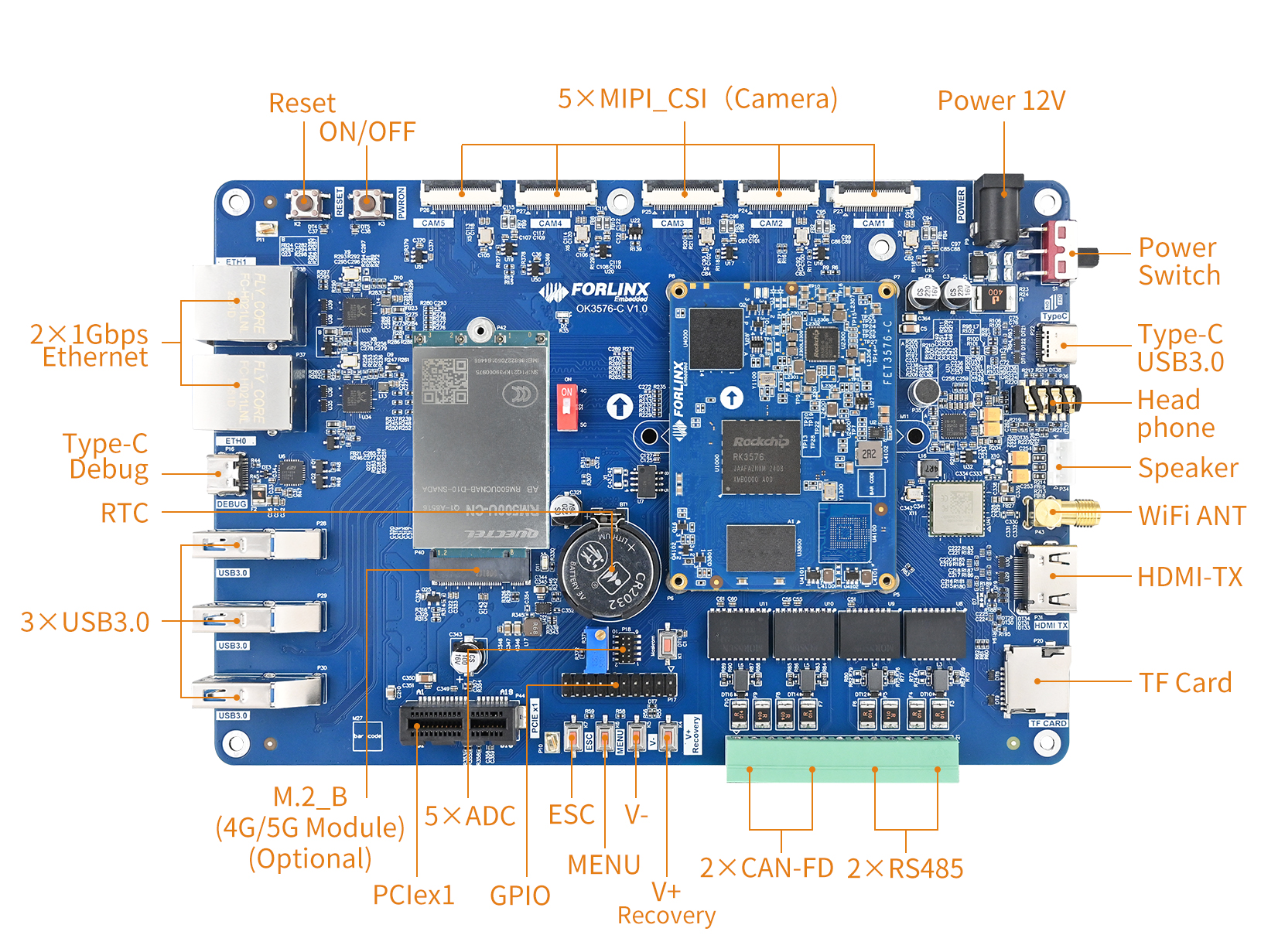
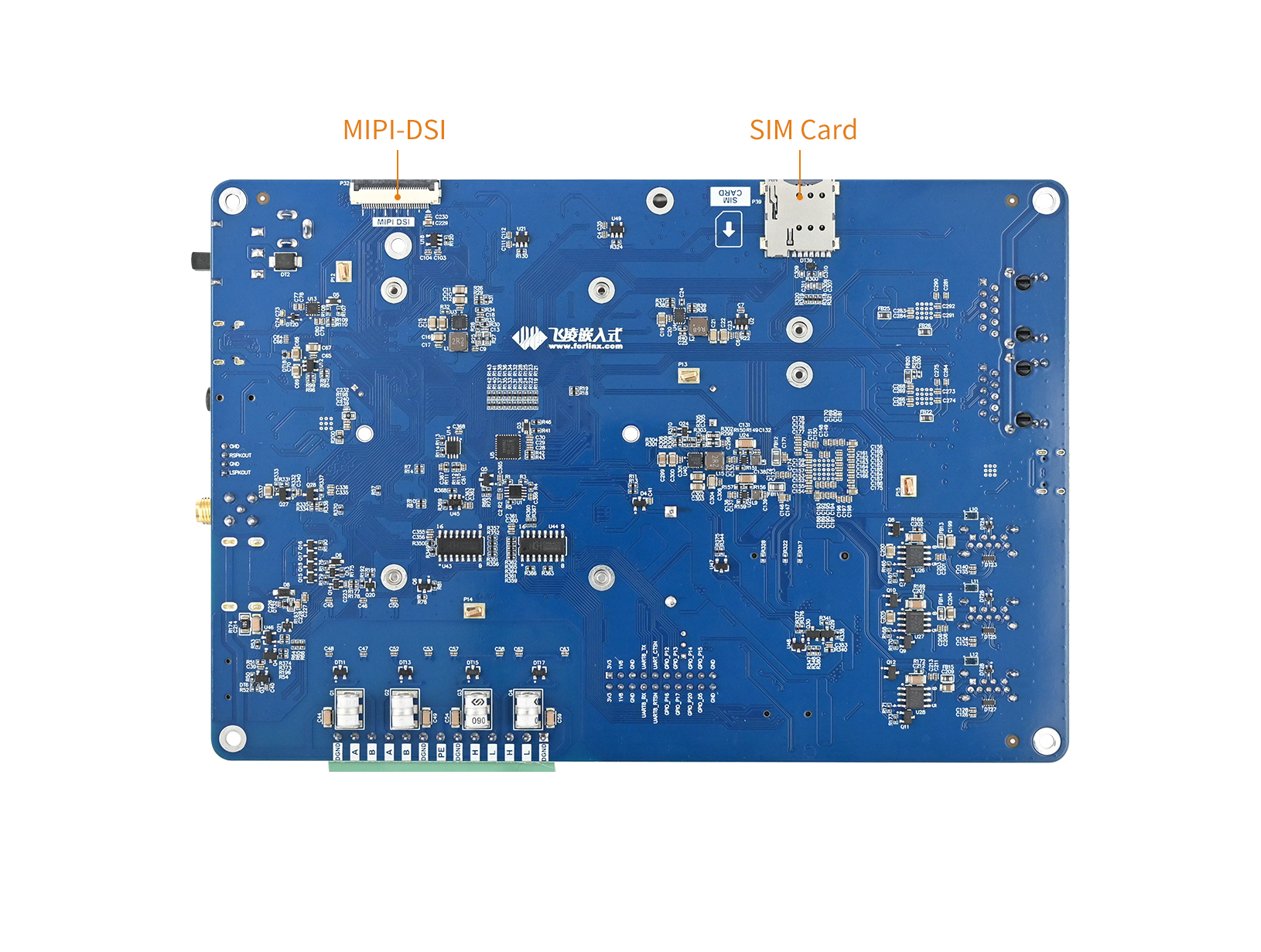
3.2 OK3576-C SoM Dimension Diagram
OK3576-C development board and antenna board is as follows:
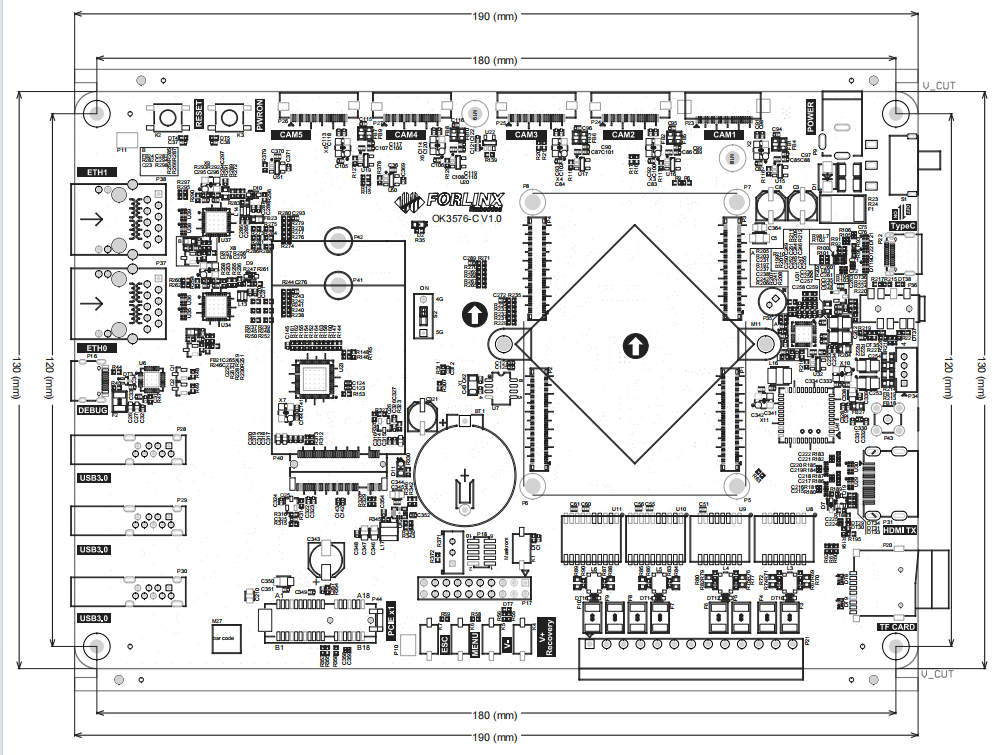
Carrier board PCB size: 130mm × 190mm. For more detailed dimensions, please refer to the user information DXF file;
Fixed hole size: spacing: 120mm × 180mm, hole diameter: 3.2mm.
Plate making process: thickness 1.6mm, 4-layer PCB.
Power supply voltage: DC 12V.
The antenna board is used for the installation and fixation of 4G and 5G antennas. Its external dimensions are 20mm×140mm. For more detailed dimensions, please refer to the figure below:
Two mounting holes with a diameter of 3.2mm are reserved on the carrier board. You can select and install the heat sink according to the site environment. Please add a layer of insulated heat-conducting silicone pad on the contact surface between the heat sink and the core board. 38Mm×38mm×23mm. For more detailed dimensions, please refer to the following figure.
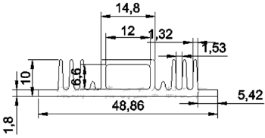
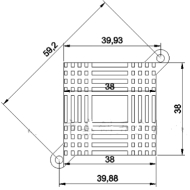
3.3 Carrier Board Naming Rules
ABC-D+IK:M
Field |
Field Description |
Value |
Description |
|---|---|---|---|
A |
Qualification level |
PC |
Prototype Sample |
Blank |
Mass Production |
||
B |
Product line identification |
OK |
Forlinx Embedded development board |
C |
CPU Type |
RK3576 |
RK3576 |
- |
Segment Identification |
- |
|
D |
Connection |
Cx |
Board-to-board Connector |
+ |
Segment Identification |
+ |
The configuration parameter section follows this identifier. |
I |
Operating Temperature |
I |
-40 to 85℃ |
K |
PCB Version |
10 |
V1.0 |
xx |
Vx.x |
||
:M |
Internal Identification of the Manufacturer |
:X |
This is the internal identification of the manufacturer and has no impact on the use. |
3.4 Carrier Board Resources
Function |
Quantity |
Parameter |
|---|---|---|
MIPI CSI |
5 |
1 x MIPI DPHY V2.0 4lanes interfaces, up to 4.5Gbps per lane; led out |
through 1 x 26pins FPC, with OV13855 camera mounted by default; |
||
4 x MIPI DPHY V1.2 2lanes interfaces, up to 2.4Gbps per lane. These interfaces are led out through four 26 - pin FPC sockets, with OV5645 camera mounted by default; |
||
MIPI DSI |
1 |
The MIPI interface supports 4 lanes output, with a maximum resolution of 2560 x 1600@60Hz. |
·Applicable for Forlinx 7” MIPI screen with resolution 1024x 600@30fps; |
||
HDMI TX |
1 |
·Led out through a standard HDMI socket; |
·HDMI v2.1 supports up to 4K @ 120Hz; |
||
DP TX |
1 |
·1 x DP in combination with USB 3.1 Gen1, led out through Type-C connector; |
DisplayPort v1.4 supports up to 4K@120Hz; |
||
USB3.1 Gen1 |
1 |
Led out via Type-C Interface; |
combined with DP TX; |
||
USB3.0 HOST |
3 |
Led out via 3 x Type- A USB Interface; |
PCIe2.0 |
1 |
· Led out through PCIe x 1 slot |
·Support rate 5Gbps; |
||
Ethernet |
2 |
Led out through 2 x RJ45 ports; |
Supports 10/100/1000 Mbps data transmission rate; |
||
TF card |
1 |
TF card is available, rate up to 150MHz,supports SDR104 mode; |
Audio |
1 |
·Codec chip on board, support headphone output, MIC input level Speaker |
output and other functions; |
||
CAN |
2 |
Two CAN buses led out through a CAN transceiver; |
Comply with CAN and CAN FD specifications; |
||
RS485 |
2 |
2 x RS485 CAN bus led out through RS485 transceiver; |
UART |
1 |
Led out via a 2.44mm pitch pin; |
Baud rate up to 4Mbps; |
||
4G/5G |
1 |
Supports 4G/5G modules packaged in M.2 format; |
WIFI&BT |
1 |
On-board AW-CM358SM-WIFI&BT module; |
Supports WIFI 2.4G/5G; bluetooth5.0; |
||
ADC |
5 |
Led out via a 2.44mm pitch pin; |
12-bit single-ended input SAR-ADC with sampling rate up to 1MS/s; |
||
RTC |
1 |
·On-board RTC chip and battery socket; |
GPIO |
8 |
8 x GPIO and 3.3 V and 1.8 V power supplies are led out through the 2.44 mm pitch pin header; |
Note:
The parameters in the table are the theoretical values of hardware design or CPU;
“TBD” means the function has not been developed in this phase.
3.5 OK3576-C Carrier Board Description
Note: The component UID with “_DNP” mark in the diagram below represents it is not soldered by default.
The schematic diagram in this chapter is only for the easy reading and may be subject to changes. Please make sure to follow the source file schematic diagram when designing.
3.5.1 Carrier Board Power
The development board uses a 12V adapter with a DC005 socket. DIP switch S1 is the power switch of the development board. Switch it as silkscreen indicates. A TVS tube is connected in parallel at the subsequent stage of S1 for electrostatic protection, and a fuse F1 is used for over - current protection. D1 cooperates with F1 for reverse - connection protection. VCC12V_DCIN supplies power to both the SoM and other peripherals on the carrier board.
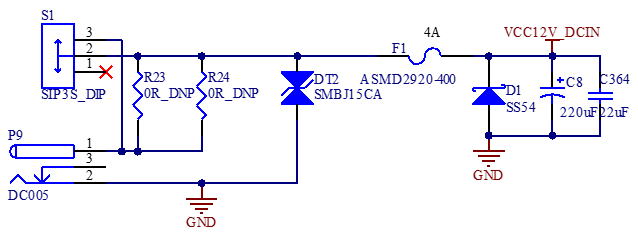
VCC12V_DCIN is stepped down to VCC_5V through U3 (DC - DC). VCC_5V supplies power to other peripherals on the carrier board. (It should be noted that when selecting a 12V - to - 5V DC - DC chip, the output power of the chip should be large enough. It is recommended that the output current be over 6A to ensure sufficient current supply for the subsequent stage.)
After the SoM is normally started with 12V power supply, it outputs a high - level signal through the CARRIER_BOARD_EN pin to control U3 to enable the output of VCC_5V power to supply power to some peripherals on the development board. (The signal level is 3.3V, and the driving capability is a 10K pull - up. If the driving capability required by the enable pin of the enabled device exceeds this range, a buffer or a gate circuit needs to be added to increase the driving capability, ensuring normal power - on of the SoM and the carrier board.)
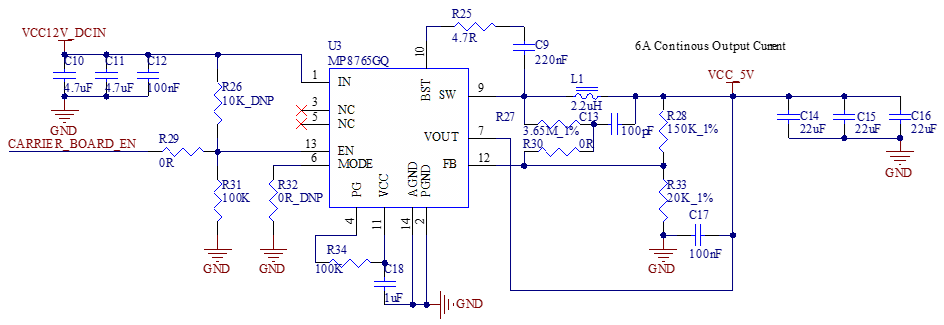
VCC_5V is stepped down to VCC_3V3 through U4 (DC - DC). VCC_3V3 supplies power to some devices on the development board.

VCC_3V3 is stepped down to VCC_1V8 through U2 (LDO). VCC_1V8 supplies power to some devices on the development board.
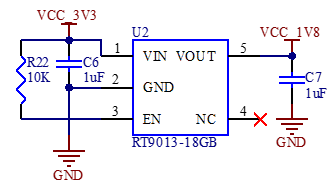
Note:
When designing by yourself, please ensure the power-on sequence of the power supply;
Refer to the corresponding chip manual for the component selection and external layout of the step-up and step-down chip to ensure a good power circuit.
3.5.2 Reset and Startup/Shutdown Signal
RESET_L is SoM resetting signal input connected to the key for convenient debugging
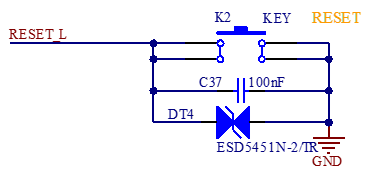
PWRON_L is an On/Off signal input connected to the key for convenient debugging
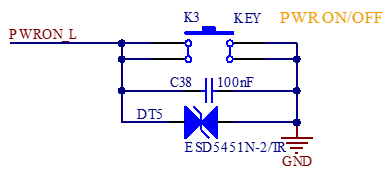
3.5.3 Boot Configuration
RK3576 supports multiple boot modes. After resetting the chip reset, the boot code integrated inside the chip can be booted on the following interface devices, and the specific boot sequence can be selected according to actual application requirements:
·Serial Flash (FSPI0, FSPI1_M0, FSPI1_M1)
·eMMC
·UFS
·SDMMC0 Card
If there is no boot code in the above devices, the system code can be downloaded to these devices through the USB 2.0 OTG0 interface USB2 _ OTG0 _ DP/DM signal. Firmware burning from the USB3 _ OTG0 _ SSRX1P/N and USB3 _ OTG0 _ SSTX1P/N signals of the USB 3.2 Gen1x1 OTG0 interface is also supported. Please note that if you need to support USB3.0 upgrade firmware and need to support 2Lane DP, you must use USB3.2 Gen1x1 OTG0 + DP 2Lane (Swap ON).
Boot Sequence Selection:
The Boot startup sequence of RK3576 can be set via the SARADC_VIN0_BOOT Pin (PIN: P1_28) to start from peripherals corresponding to different interfaces. As shown in the following table, the hardware can design a total of 11 modes of peripheral boot sequences (Config1 - Config11) by configuring different pull - up and pull - down resistance values, which can be configured correspondingly according to actual application requirements.
Table 3.5.3.1 Boot Sequence Configuration Table
Item |
Rup |
Rdown |
ADC |
BOOT MODE |
|---|---|---|---|---|
Config1 |
DNP |
10K |
0 |
USB (Maskrom mode) |
Config2 |
10K |
1.13K |
416 |
FSPI0→USB |
Confi 3 |
10K |
2.49K |
816 |
FSPI1_M0→EMMC→USB |
Config4 |
10K |
4.3K |
1231 |
FSPI1_M1→EMMC→USB |
Config5 |
10K |
6.8K |
1658 |
FSPI0→UFS→USB |
Config6 |
10K |
10K |
2048 |
FSPI1_M0→UFS→USB |
Config7 |
10K |
14.7K |
2437 |
UFS→USB |
Config8 |
10K |
23.2K |
2862 |
UFS→SDMMC0→USB |
Config9 |
10K |
40.2K |
3279 |
RFU |
Config10 |
10K |
88.7K |
3680 |
EMMC→SDMMC0→USB |
Config11 |
10K |
DNP |
4095 |
EMMC→USB |
SARADC_VIN0_BOOT on SoM is 10K pull-up, so the SoM defaults to start from eMMC The pull-down resistor can be added to the carrier board to achieve other boot sequences. According to the above Config1
settings, the SARADC_VIN0_BOOT is connected to GND via the touch key to achieve Maskrom mode.
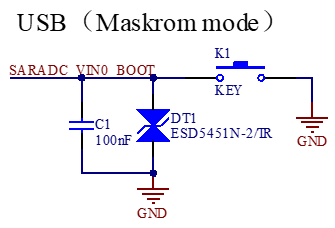
SARADC_ VIN1 is used to enter the recovery state due to a short circuit to the ground, and the SoM pulls it up to a 1.8V power supply using a 10K resistor. On OK3576-C, the key array adopts a parallel type, which can adjust the input key value by increasing or decreasing the keys and adjusting the proportion of the voltage divider resistor to achieve multi-key input to meet customer product requirements; It is recommended in the design that any two key values must be greater than ± 35, i.e. the center voltage difference must be greater than 123mV. The principle is as follows:
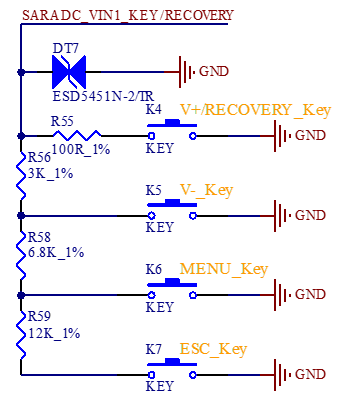
Note:
When doing key acquisition, ESD protection is required near the keys. And 0 key value must be connected in series with a 100ohm resistor to strengthen the anti-static surge capacity (If there is only one button, ESD must be close to the button, ESD → 100ohm resistor → 1nF → chip pin).
3.5.4 System Initialization Configuration Signal
There is one important signal in the FET3576 that affects the system boot configuration and needs to be configured and kept in a stable state before power-up:
SDMMC 0 _ DET _ L (PIN: P3 _ 90) (default function is SDMMC _ DET): Determines whether the VCCIO1 power domain IO is an SDMMC0 or JTAG function.
The JTAG function and the SDMMC function of the FET3576 are multiplexed , and the function of the IOMUX is switched through the SDMMC0 _ DET _ L pin, so the pin also needs to be configured before power-on, otherwise, no output of the JTAG function will affect the debugging in the boot phase. No output from SDMMC0 will affect the SDMMC0 boot function.

If the pin is detected to be high level, the corresponding IO is switched to JTAG function;
When this pin detects low level (Most SD cards inserted will pull down this pin, if not need special treatment), the corresponding IO switches to SDMMC0 function;
After the system is up, it can be switched to have registers to control IOMUX, then the pin can be released;
For easy reference, the configuration status of this pin corresponds to its function shown as follows:
Table 3.5.4.1 FET3576 System Initialization Configuration Signal Description
Signal |
Internal Pull-up&down |
Description |
|---|---|---|
SDMMC0_DET_L |
Pull-up |
SDMMC/ARM JTAG pin multiplexing selection control signal: 0: Identified as SD card insertion, SDMMC/JTAG pin multiplexing as SDMMC0 function; 1: Not identified as SD card insertion, SDMMC/JTAG pin multiplexing as JTAG function (Default). |
3.5.5 JTAG & UART Debug Circuit
The JTAG interface of the RK3576 chip complies with the IEEE1149.1 standard, and the PC can be connected to the DSTREAM through the SWD mode (two-wire mode).
Emulator to debug the ARM Core inside the chip.
The JTAG interface description is shown in the following table:
Table 3.5.5.1 FET3576 JTAG Debug
Signal |
Description |
|---|---|
JTAG_TCK_M0/M1 |
SWD mode clock input |
JTAG_TMS_M0/M1 |
SWD mode data input and output |
The JTAG of RK3576 has two multiplexing modes. Among them, JTAG_TCK_M0/JTAG_TMS_M0 is located in the VCCIO1 domain and shares the IOMUX with SDMMC0; JTAG_TCK_M1/JTAG_TMS_M1 is located in the PMUIO1 domain and is multiplexed with UART_Debug - UART0_M0. The IOMUX multiplexing situation is shown in the figure below:
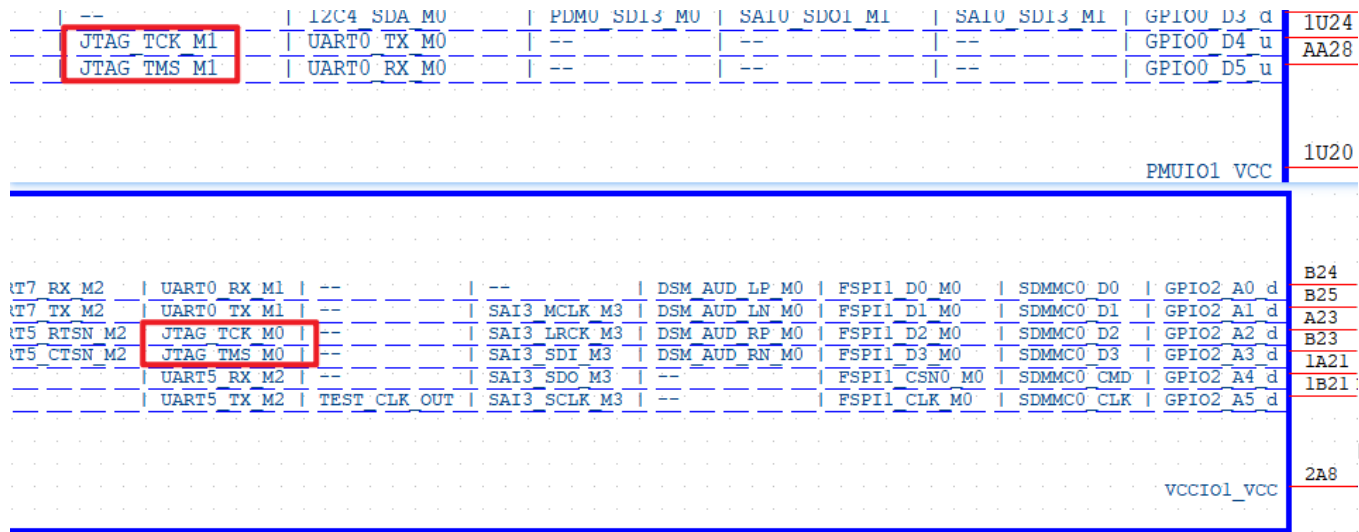
The UART Debug of FET3576 uses UART0_TX_M0_DEBUG (P2_7)/UART0_RX_M0_DEBUG (P2_9) by default. UART Debug signal needs to be connected with 100ohm resistor in series, if plug-in is used, and TVS tube needs to be added near the plug-in position.
To facilitate user debugging, OK3576-C uses a USB to UART chip to convert the UART signal into a USB signal and leads it out through a Type-C socket. Users can connect OK3576-C P16 to PC with USB Type-A to UAB Type-C cable and install a CP2102 driver. The schematic is as follows:
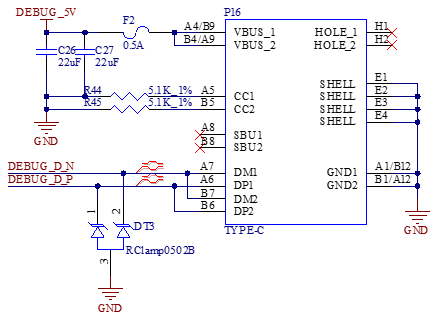
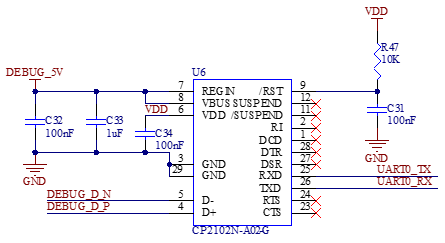

Note:
For the convenience of later debugging, please lead out the debugging serial port when designing the carrier board;
It is recommended to keep Q1 and Q2, which can effectively prevent the U6 current from flowing back to the CPU through UART0_TX/RX when the SoM is not powered up, affecting the startup and even causing damage.
3.5.6 IIC Extending IO
To introduce more diverse interfaces, the enable and reset signals of the carrier board are completed by the IIC to IO chip U5. At the same time, the U5 spare part of IO is led by P17 to facilitate user expansion. The principle is as follows:
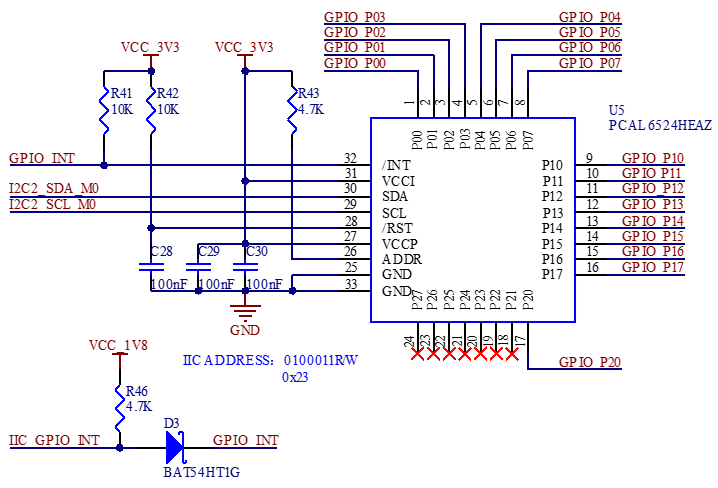
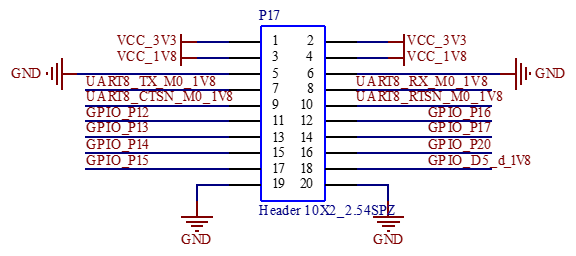
3.5.7 SARADC
SARADC _ VIN2/VIN4/VIN5/VIN6/VIN7 are led out through P18; R371 is a variable resistor, and SARADC _ VIN2/VIN4/VIN5/VIN6/VIN7 is short-circuited with pins 4, 6, 8 and 10 of P18. When the resistance of the R371 variable resistor is adjusted, the voltage change can be read by the ADC. As shown in the figure below:
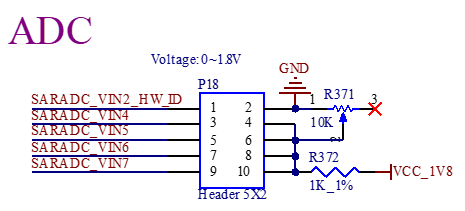
Note: When using the SARADC_VINx, 1nF capacitor must be added near the pin to eliminate jitter.
3.5.8 TF Card
The carrier board P20 is a TF Card interface, which can support system boot and burn.
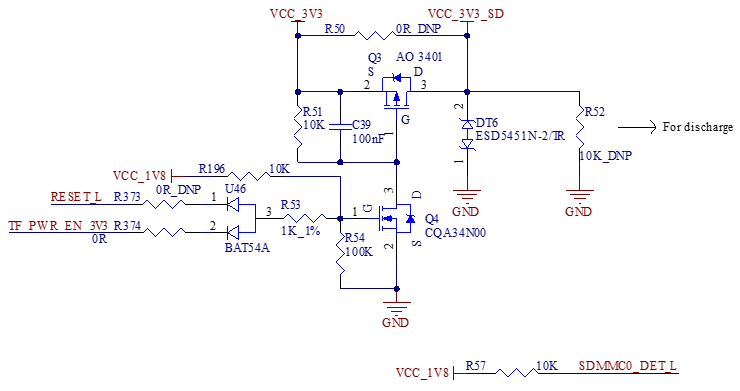
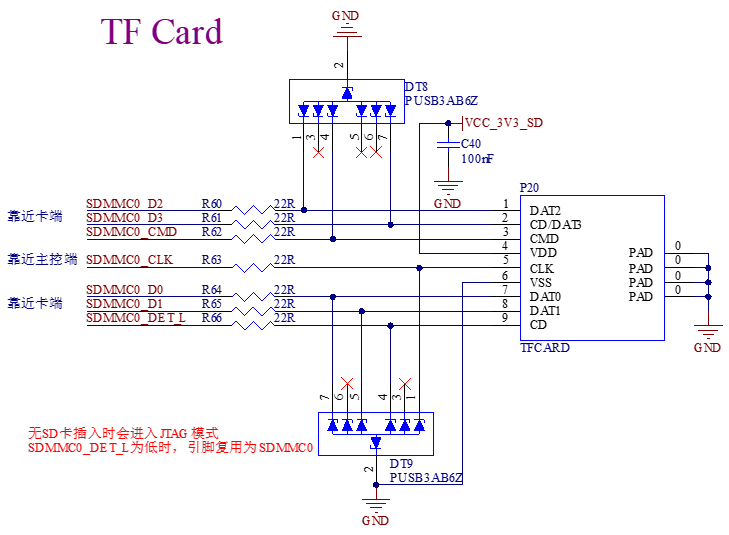
Note:
The power supply for the TF card must be controlled; please refer to the carrier board circuit;
SDIO impedance requirements: Single-ended 50ohm, signal equal length control 50 mil.
3.5.9 RTC Circuit
The OK3576-C provides an on-board external RTC function for more accurate timing and lower power consumption. As shown in the figure below:
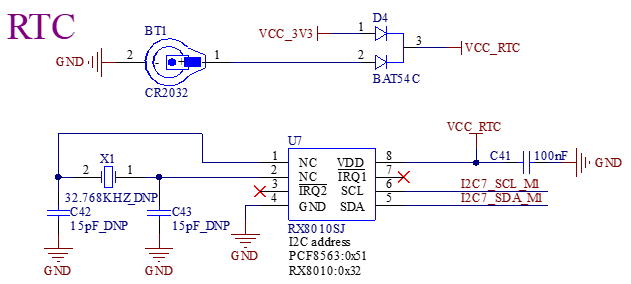
3.5.10 Ethernet Circuit
The carrier board supports dual 1000/100/10M Ethernet interfaces, which are led out via RJ45.
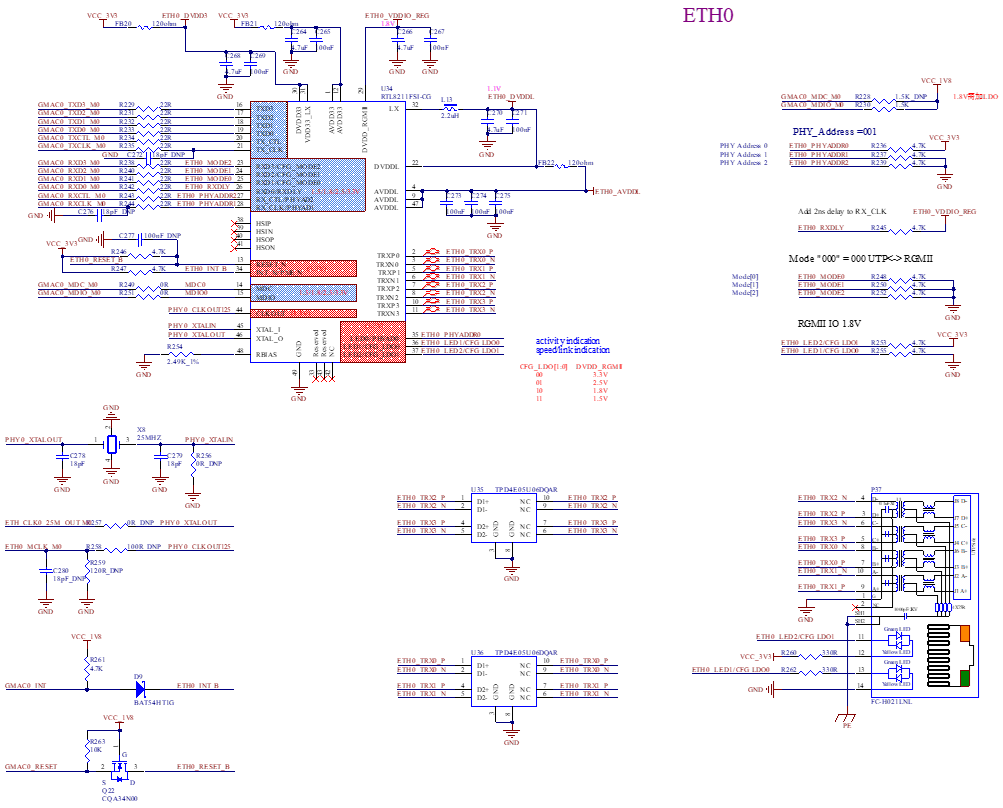
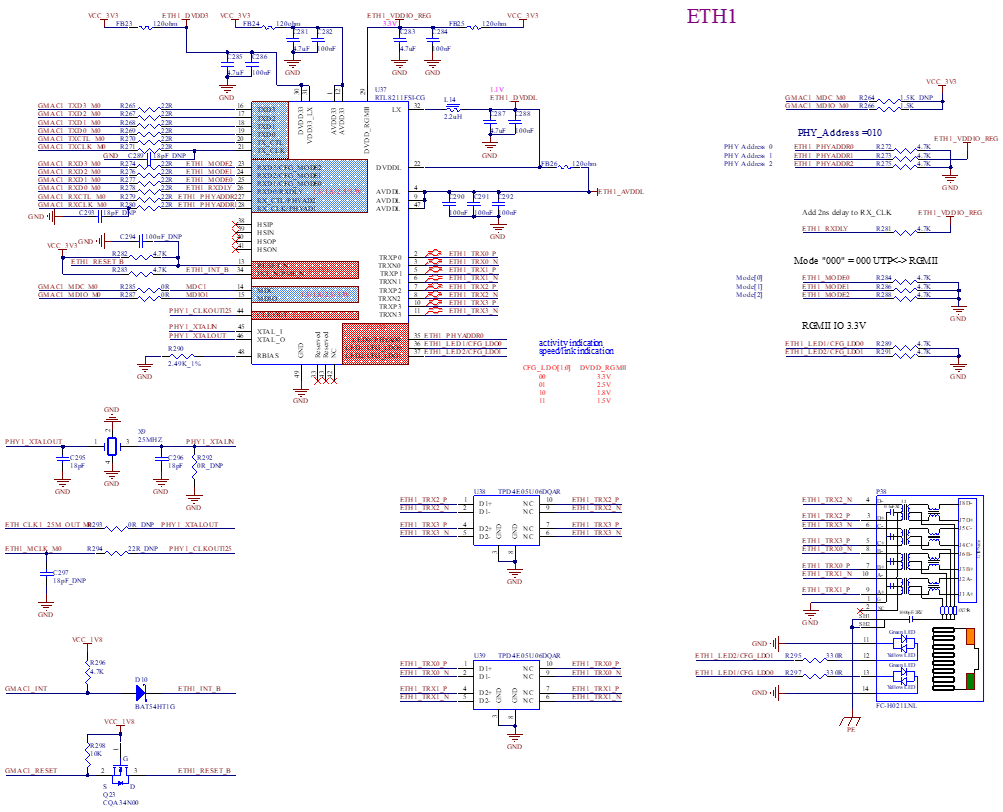
Note: The following table shows the RK3576 RGMII/RMII interface design.
Table 3.5.10.1 RK3576 RGMII/RMII Interface
Signal |
IO Type**(Chip-side)** |
RGMII Interface |
Signal Description |
RMII Interface |
Signal Description |
|---|---|---|---|---|---|
GMACx_TXD[3:0] |
Output |
RGMIIxTXD[3:0] |
Data sending |
RMIIx_TXD[1:0] |
Data sending |
GMACx_TXCLK |
Output |
RGMIIx_TXCLK |
Reference clock for data sending |
– |
– |
GMACx_TXCTL |
Output |
RGMIIx_TXCTL |
Data sending enable (rising edge) and data transmission error (falling edge) |
RMIIx_TXEN |
Data sending enable ( |
GMACx_RXD[3:0] |
Input |
RGMIIx_RXD[3:0] |
Data receiving |
RMIIx_RXD[1:0] |
Data receiving |
GMACx_RXCLK |
Input |
RGMIIx_RXCLK |
Data receiving reference clock |
– |
– |
GMACx_RXCTL |
Input |
RGMIIx_RXCTL |
Effective data receiving (rising edge) and receiving error (falling edge) |
RMIIx_RXCTL |
Data receiving validity and carrier sense |
GMACx_MCLKINOUT |
Input/Output |
RGMIIx_MCLKI_ 125M |
PHY sends 125MHz to MAC, optional |
RMII_MCLKIN_50M or RMII_MCLKOUT_50M |
RMII data sending and data receiving reference clock |
ETHx_REFCLKO_ 25M |
Output |
ETHx_REFCLK_ 25M |
RK3576 provides 25MHz clock to replace PHY crystal |
ETHx_REFCLKO_ 25M |
RK3576 provides 25MHz clock to replace PHY crystal |
GMACx_MDC |
Output |
RGMIIx_MDC |
Manage the data clock |
RMIIx_MDC |
Manage the data clock |
GMACx_MDIO |
Input/Output |
RGMIIx_MDIO |
Manage data output/input |
RMIIx_MDIO |
Manage data output/input |
In RGMII mode, the TX/RX clock paths inside the RK3576 chip are integrated with a delay line, which supports adjustment. The default configuration in the reference diagram is as follows: The timing between TXCLK and data is controlled by the MAC, and the timing between RXCLK and data is controlled by the PHY. (For example, when using RTL8211F/FI, a 2ns delay for RXCLK is enabled by default. Please pay attention to other PHY configurations;
The GMAC0 interface level only supports 1.8V. The GMAC1 interface level is 3.3V by default (if it must be changed to 1.8V, please contact Forlinx). It should be noted whether the power - supply voltage of the RGMII signal power domain of the PHY chip matches the level of the GMACx interface;
The Reset signal of the Ethernet PHY needs to be controlled by GPIO. The level of the GPIO must match the PHY IO level. A 100nF capacitor must be added close to the PHY pins to enhance the anti - static ability. Note: The reset pin of RTL8211F/FI only supports a 3.3V level;
For TXD0 - TXD3, TXCLK, and TXEN, a 0ohm series resistor should be reserved at the FET3576 end to improve the signal quality conditionally according to the actual situation;
For RXD0 - RXD3, RXCLK, and RXDV, a 22ohm series resistor should be connected at the PHY end to improve the signal quality;
When the PHY uses an external crystal, the crystal capacitor should be selected according to the load capacitance value of the actually used crystal, and the frequency deviation should be controlled within ±20ppm;
The external resistor connected to the RSET pin of RTL8211F/FI is 2.49K ohms with an accuracy of 1%. Do not modify it casually;
An external pull - up resistor must be added to MDIO, with a recommended value of 1.5 - 1.8K ohm. The pull - up power supply must be consistent with the IO power supply;
The PCB layout needs to ensure the integrity of the RGMII signal reference plane and the integrity of the power supply reference plane around the PHY chip;
Equal - length requirement: The receiving and sending signals of RGMII can be grouped for equal - length processing, and the equal - length requirement is ≤12.4mil;
Impedance requirement: 50 ohm for single - ended signals.
3.5.11 RS485 Interface
OK3576-C supports 2 x RS485 interfaces.
RS485 transceiver chip U8/U9; transceiver chip signal is TDH341S485S, quarantine withstand voltage up to 5000VDC, bus electrostatic protection capability up to 15 kV (HBM), > 25Kv/us transient immunity. Meanwhile, the OK3576-C carrier board is compatible with a higher level of surge pulse group multi-level protection circuit, as shown in the following figure:
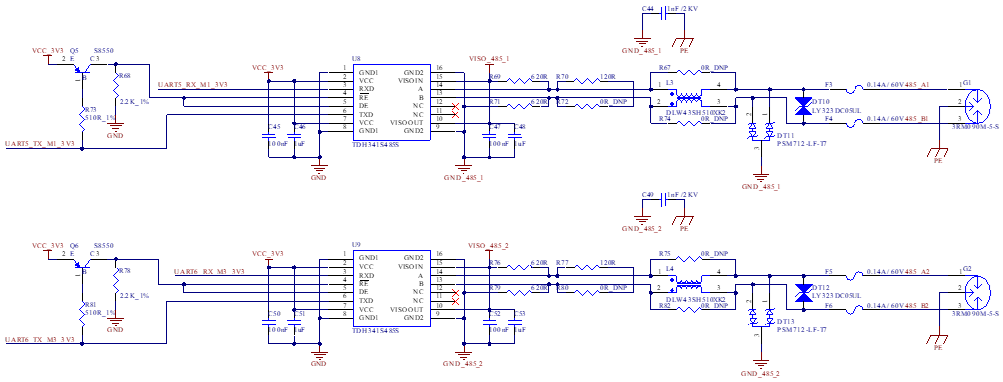
3.5.12 CAN Interface
The OK3576-C has two CAN transceiver chips U10 and U11 on board, and the transceiver chip signal is TDH541SCANFD, with isolation withstand voltage up to 5000VDC, bus static protection up to 15kV (HBM), and transient immunity >25Kv/us. Meanwhile, the OK357-C carrier board is compatible with a higher level of surge pulse group multi-level protection circuit, as shown in the following figure:
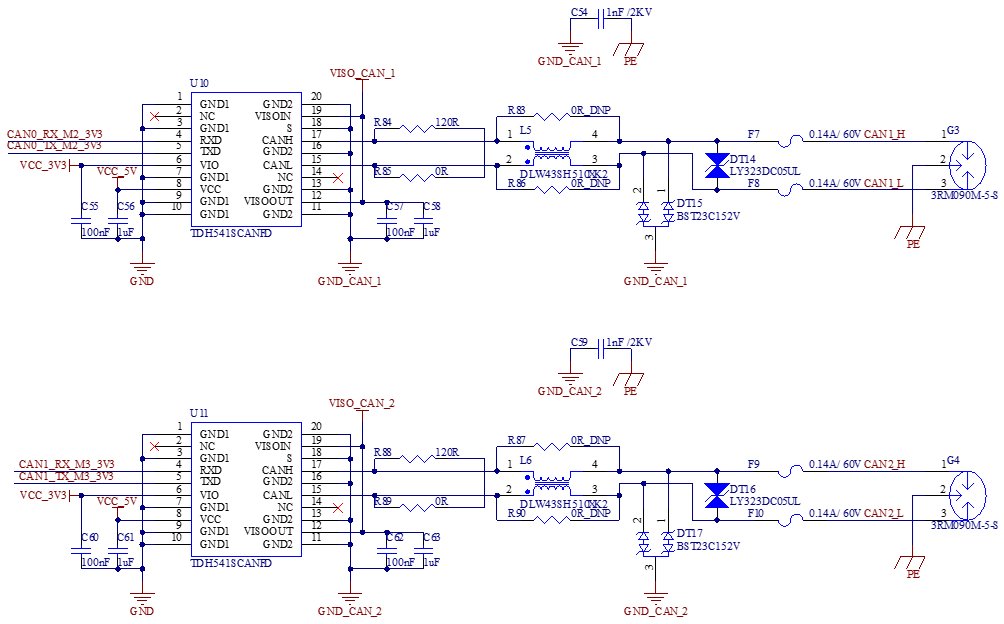
3.5.13 Audio
The OK3576-C has an I2S interface Codec chip U31 on board, which supports MIC input, headphone output, and 1W 8Ω speaker output. The principle shown as follows:
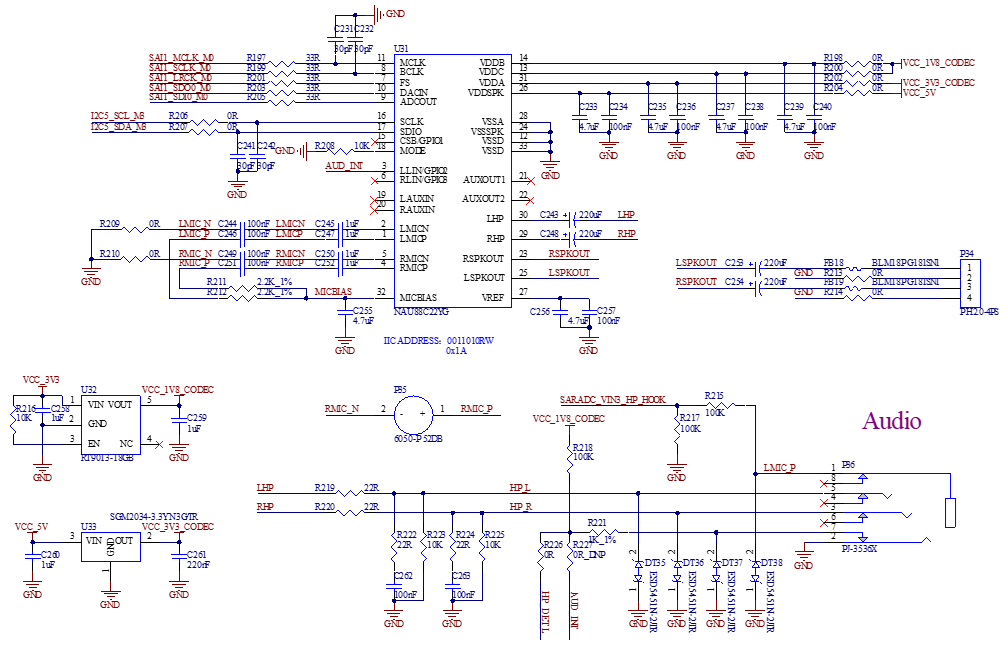
3.5.14 4G&5G Interface
The OK3576-C integrates an M.2 Key-B interface that is compatible with 4G and 5G modules. Since 4G and 5G modules have different power supply voltages, we need to dip S2 to select the corresponding power supply voltage.
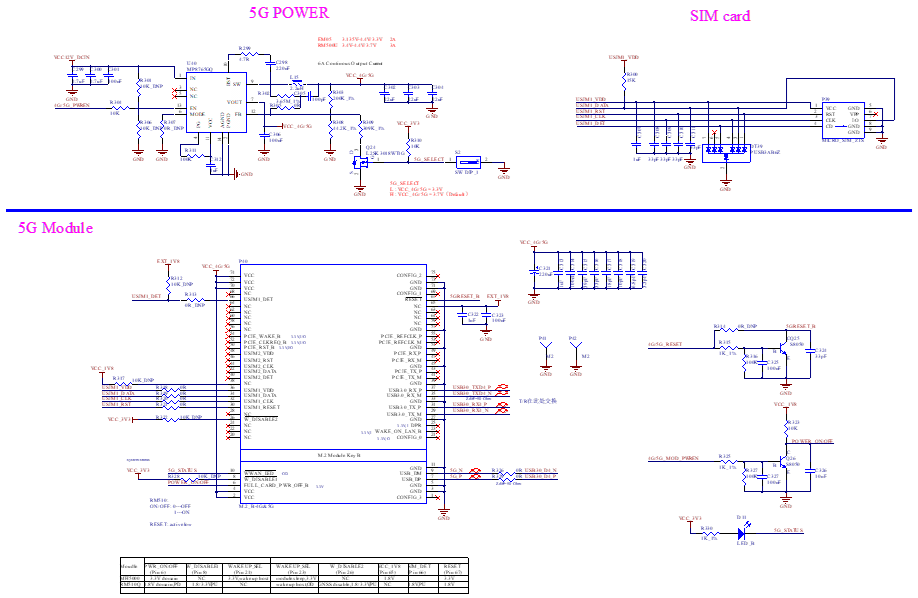
3.5.15 USB2.0/USB3.0_A/Type - C USB3.0 Circuit
The RK3576 chip has two built-in USB3 OTG controllers, both of which are embedded with USB2.0 OTG.
The application of the USB3 OTG0/DP1.4 interface is as follows:
USB3.2 Gen1x1 OTG0/DP1.4 forms a Combo PHY. The internal multiplexing diagram of the USB3 OTG0 controller and the PHY is as follows:

The USB3 OTG0 controller supports SS/HS/FS/LS, and the embedded USB2.0 (HS/FS/LS) signal uses USB2.0 OTG PHY. The signal name is shown in the red box in the figure below; RK3576 uses this interface for Fireware Download by default. Please reserve this interface in the application.

Note: USB2_OTG0_DP/USB2_OTG0_DM support Firmware Download. If this interface is not used in the product, it must be reserved during the debugging and production process. Note: USB2_OTG0_VBUSDET must also be connected!
The SS signal (5Gbps) of USB 3.2 is multiplexed with DP1.4, and the Combo PHY of USB/DP is used; the signal is shown in the red box in the figure below.
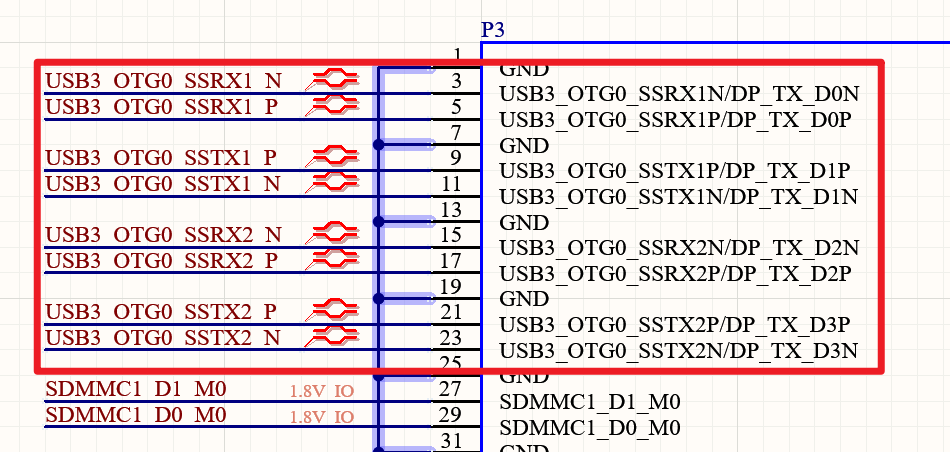
Since the USB3 OTG and USB2.0 OTG are the same USB3 controller, the USB3 and USB2.0 OTG can only do Device or HOST at the same time, not USB3 OTG for HOST, USB2.0 OTG for Device or USB3 OTG for Device and USB2.0 OTG to do HOST.
USB3 OTG0 Controller and DP1.4 Controller are combined into a complete TYPEC port through USB3/DP1.4 Combo PHY, and this Combo PHY supports Display Alter mode. Lane0 and Lane2 do TX in DP mode and RX in USB mode; TX and RX share Lane0 and Lane2.
This USB3/DP1.4 Combo PHY supports inter-Lane switching (SWAP), so a TYPEC standard port can have the following five configurations:
Configuration I: Type-C 4Lane (with DP function)
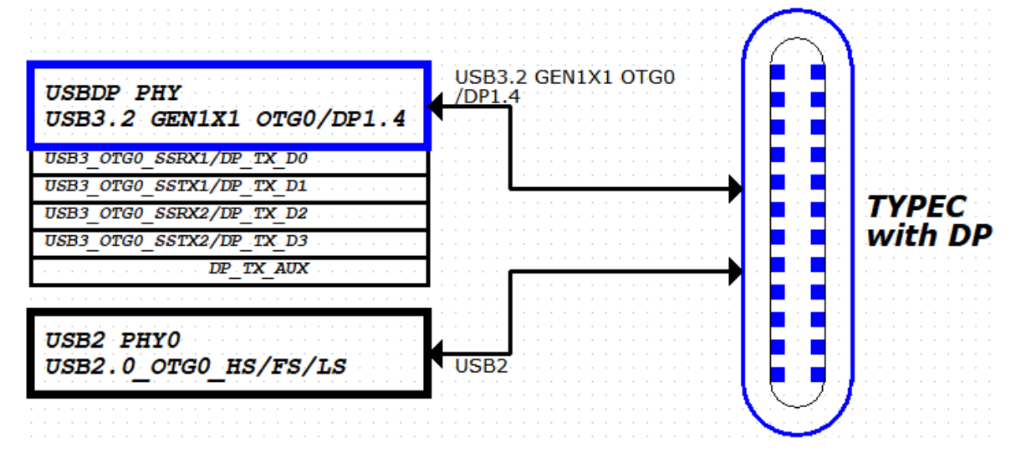
Configuration II: USB2.0 OTG+DP1.4 4Lane(Swap OFF)
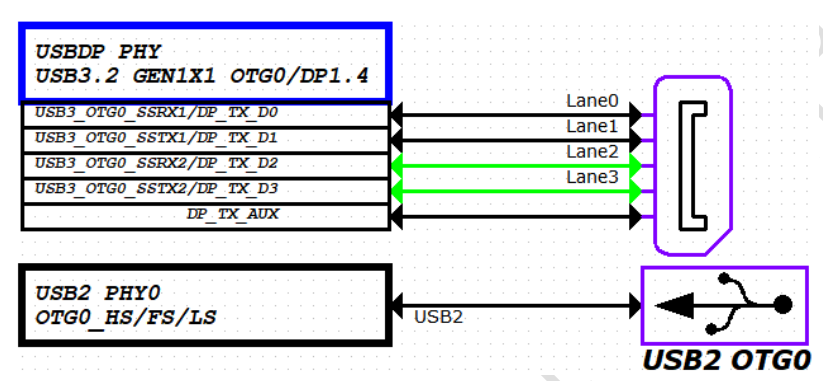
Configuration III: USB2.0 OTG+DP1.4 4Lane(Swap ON)
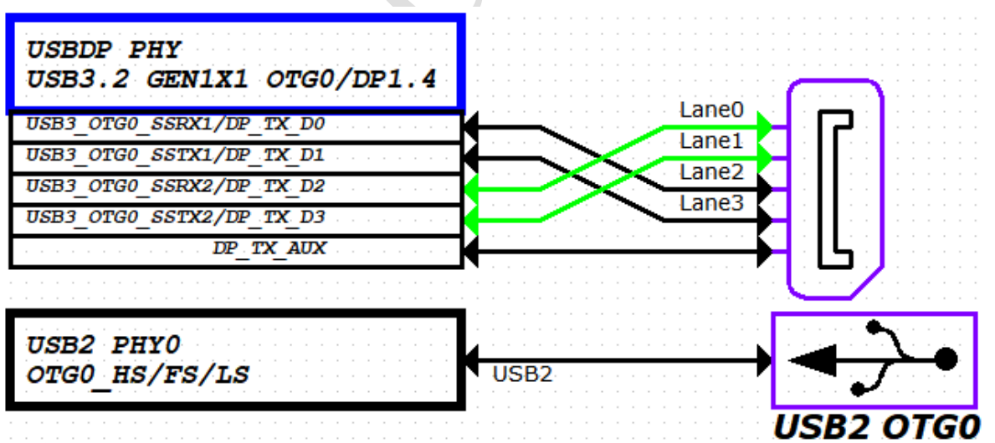
Configuration IV: USB3.2 Gen1x1 OTG0+DP1.4 2Lane(Swap OFF)
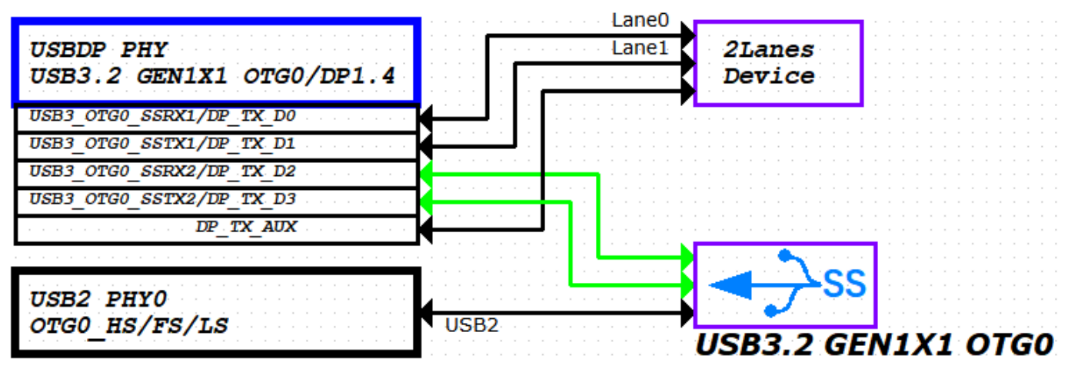
Configuration V: USB3.2 Gen1x1 OTG0+DP1.4 2Lane(Swap ON)
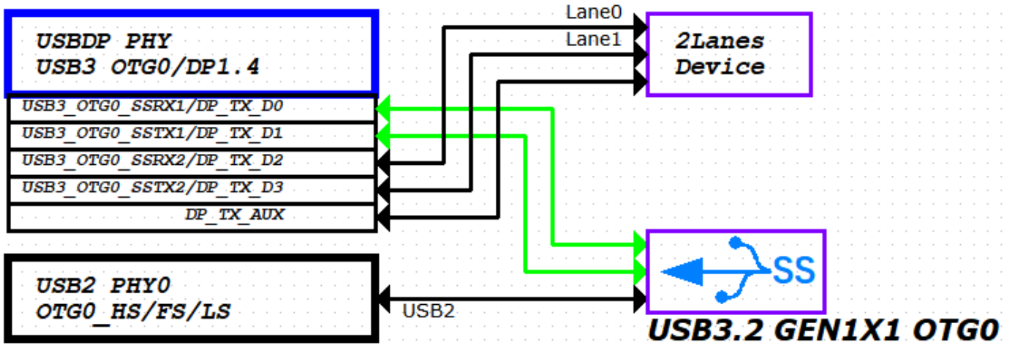
Note: The RK3576 supports firmware download from the USB3 _ OTG0 _ SSRX1P/N and USB3 _ OTG0 _ SSTX1P/N signals of the USB 3.2 Gen1x1 OTG0 interface. When it is necessary to support USB3.0 firmware upgrade and 2Lane DP, the solution of USB3.2 Gen1x1 OTG0 + DP 2Lane (Swap ON) must be used.
The USB3 OTG1 interface is applied as follows:
Comb PHY1 is composed of PCIE1/SATA1/USB3 OTG1. The internal multiplexing diagram of USB3 OTG1 controller and PHY is as follows:
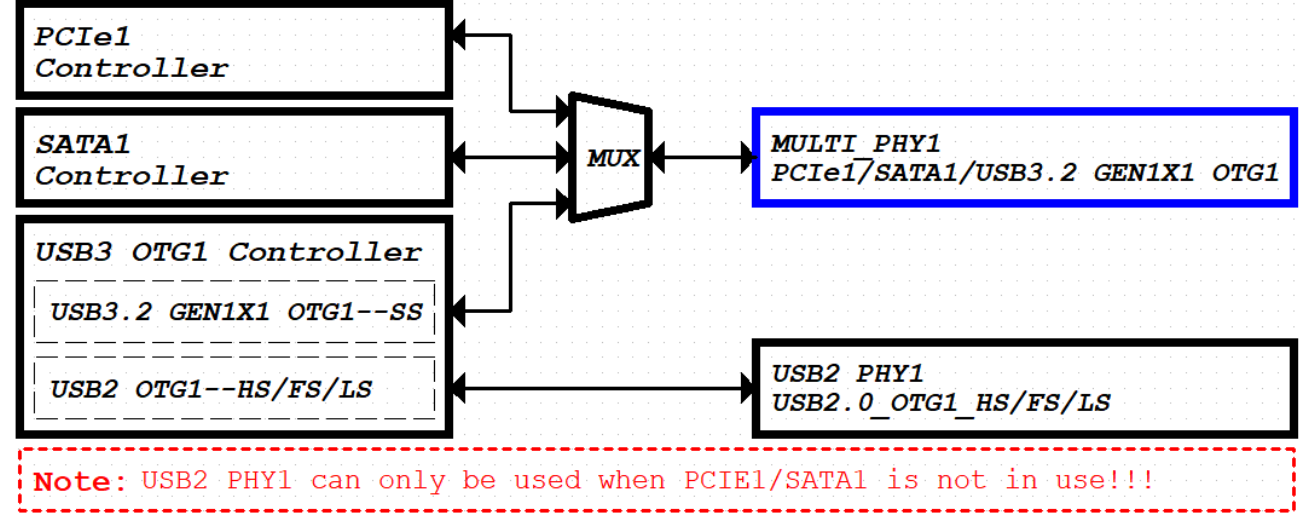
The USB3 OTG1 controller supports SS/HS/FS/LS and is embedded with USB2.0 (HS/FS/LS) signals to form PCIE1/SATA1/USB3 OTG1 COMBO PHY1; the pin lay out is as follows:

The pin assignment of USB20 OTG1 is shown in the following figure:

Since the OTG1 of USB3 and the OTG1 of USB2.0 are the same controller of USB3, they can only be used as Device or HOST at the same time, and the OTG of USB3 cannot be used as HOST, USB2.0 OTG as Device or USB3 OTG as Device and USB2.0 OTG as HOST.
Note: When the COMBO PHY1 of PCIE1/SATA1/USB3 OTG1 is set to PCIe or SATA function, the USB3 OTG1 function and USB2.0 PHY1 cannot be used. Therefore, when using USB2.0 OTG1, the COMBO PHY1 of PCIE1/SATA1/USB3 OTG1 must be set to USB3 function!!!
There are several application modes for USB3 OTG1 in the COMBO PHY1 of PCIE1/SATA1/USB3 OTG1:
Configuration I: USB3.2 Gen1x1 OTG1

Configuration II: USB2 OTG1

Configuration III: USB2/USB3 is not used. See the PCIE and SATA chapter for the specific application of PCIE and SATA.

A USB HUB chip is used on the OK3576-C development board to convert a single channel USB2.0/USB3.0 _ HOST into four channels, wherein 3 x USB3.0 are respectively connected to 3 x Type-A interfaces for using, and each channel can provide the maximum current output of 1A and has the current limiting switch protection function. The remaining 1 x USB3.0 is provided to the 4G & 5G module
On the OK3576 - C carrier board, a standard Type - C USB 3.0 full - function interface is designed. This interface is implemented by a USB/DP combo interface supported by the FET3576. This combo interface supports USB 3.2 Gen1x1 and DisplayPort v1.4, and enables data transmission and DP display output.
The following figure shows the circuit of the USB3.0 HUB:
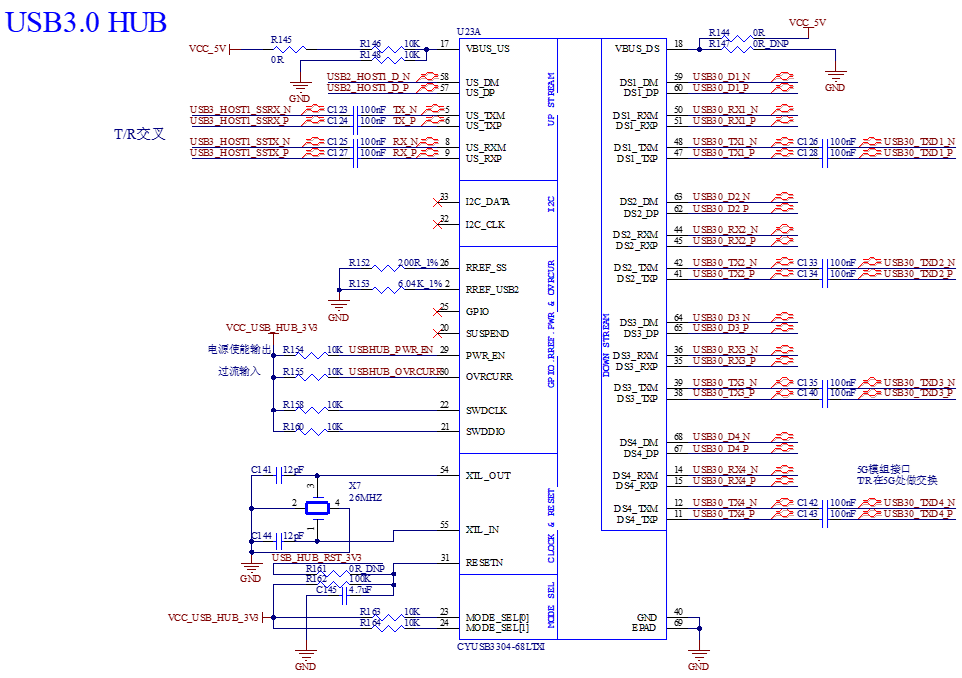
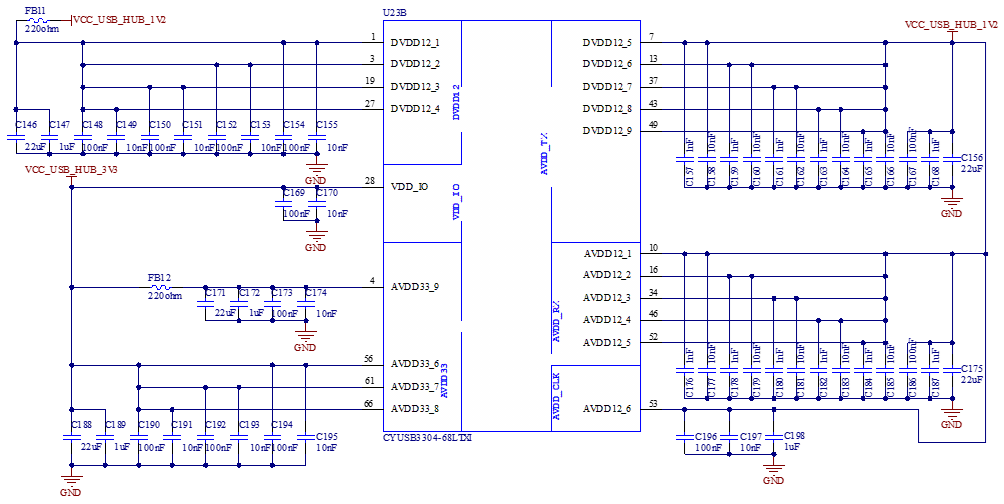
Use two additional switching power supplies to provide 3.3 V and 1.2 V power for the USB HUB chip:
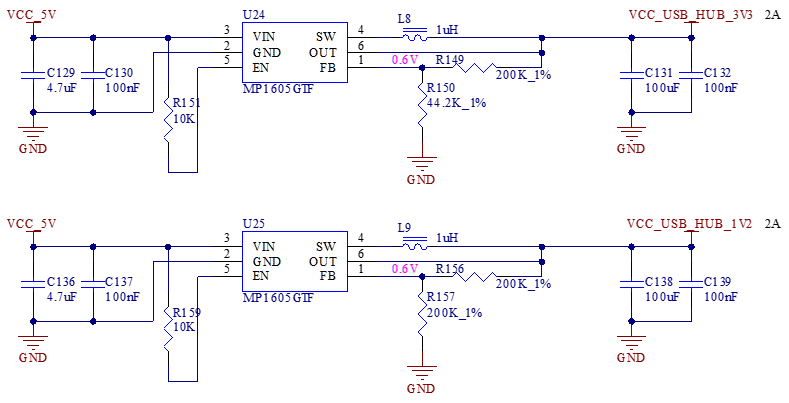
The three USB 3.0 interfaces transferred from the USB HUB chip are all matched with the USB power supply current-limiting switch chip to provide stable power supply and current-limiting protection functions for the Type-A interface:



Note:
All USB data cables need to have a 90Ω differential impedance;
Please select appropriate ESD devices.
The following figure shows the circuit of the Type - C USB 3.0 interface:
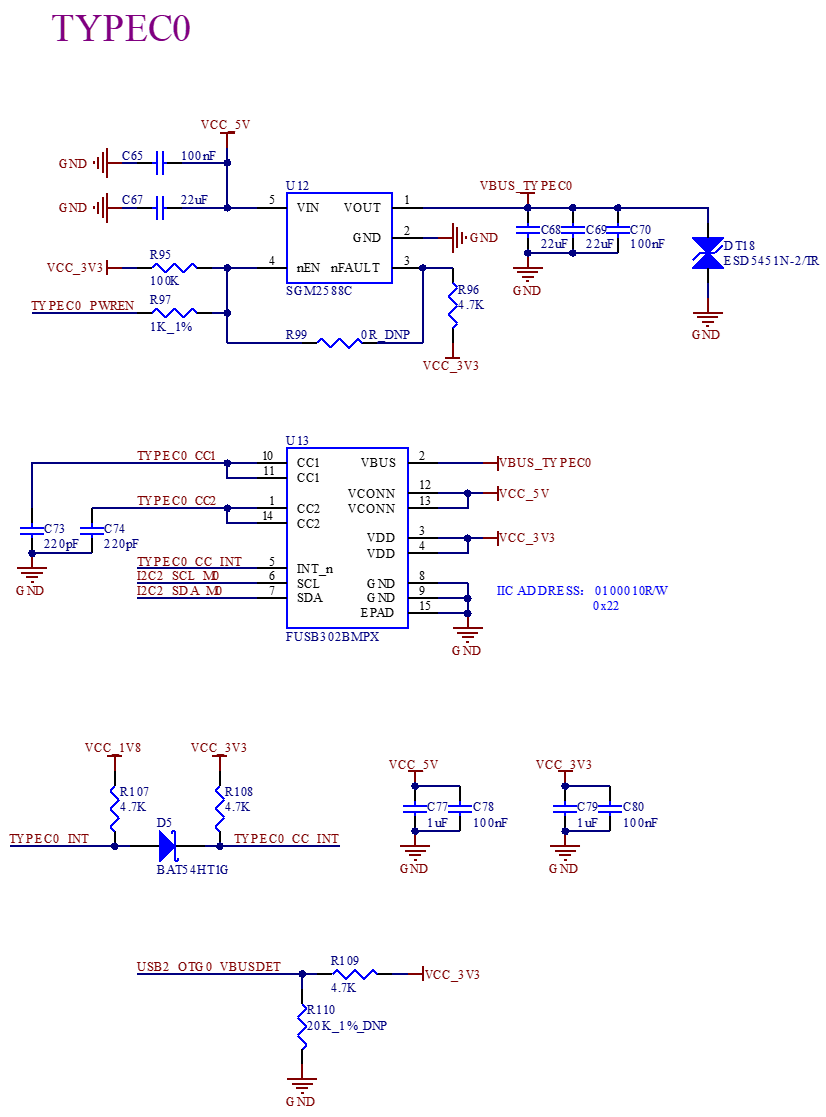
The above figure shows the circuit of the CC protocol chip for the Type - C interface, which is used to support functions such as Type - C reversible plug recognition:
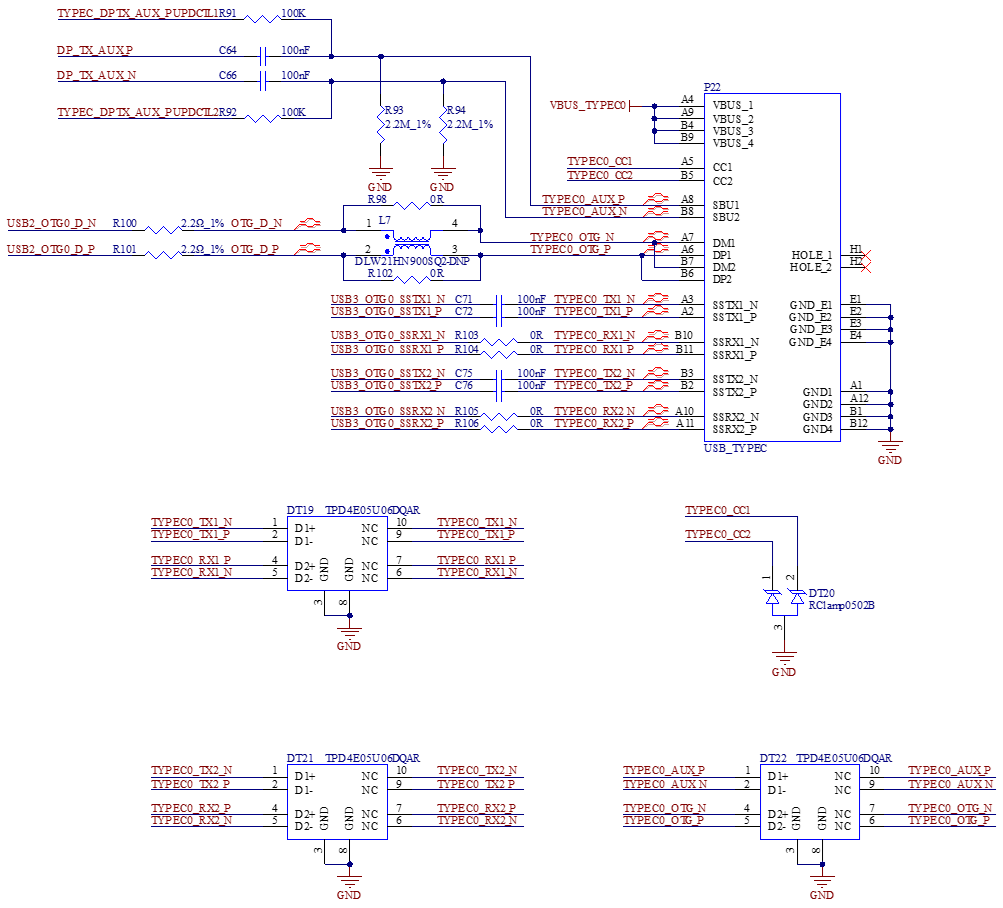
The above figure shows the differential signal circuit and ESD protection devices of the Type - C USB3.0 interface:
Note:
USB2_OTG0_DN/USB2_OTG0_DP is the system firmware programming port. If this interface is not used in the product, it must be reserved during the debugging and production processes. Otherwise, debugging and firmware programming during production will not be possible;
There is approximately a 12Kohm ohm pull - up resistor to 1.8V inside the USB2_OTG0_ID;
USB2 _ OTG0 _ VBUSDET is the OTG and Device mode detection pin. There is a pull-down resistor of 40 Kohm inside the chip. The high is DEVICE device, 2.7-3.3 V, TYP: 3.0 V. It is recommended to place a 100nF capacitor on the pin;
The OTG mode can be set to the following three modes:
OTG mode: Automatically switch between the device mode and the HOST mode according to the state of the ID pin. When the ID is high, it is in the device mode; when the ID is pulled low, it is in the HOST mode. In the device mode, it will also check whether the VBUSDET pin is high (greater than 2.3V). Only when it is high will the DP be pulled high to start the enumeration process;
Device mode: When set to this mode, there is no need to use the ID pin. It only needs to check whether the VBUSDET pin is high (greater than 2.3V). Only when it is high will the DP be pulled high to start the enumeration process;
HOST mode: When set to this mode, there is no need to care about the states of the ID and VBUSDET pins. ( In the case that the product only needs HOST mode, the system firmware burning port is only USB2_OTG0_DN/USB2_OTG0_DP, which is also used in the production and debugging, so when burning and abd debugging, you need to set it to device mode and connect USB2_OTG0_VBUSDET signal.
If a TYPEC interface is used, the USB2_OTG0_VBUSDET signals can be pulled high through a 4.7K resistor;
To enhance the anti - static and anti - surge capabilities, ESD devices must be reserved on the signals. The parasitic capacitance of the ESD for USB 2.0 signals shall not exceed 3pF. Additionally, a 2.2 - ohm resistor should be connected in series with the DP/DM of the USB 2.0 signals to enhance the anti - static and anti - surge capabilities;
To suppress electromagnetic radiation, a common - mode choke can be reserved on the signal lines. During the debugging process, a resistor or a common - mode choke can be selected according to the actual situation;
If the USB2_OTG0_ID signal is used, to enhance the anti - static and anti - surge capabilities, ESD devices must be reserved on the signal, and a 100ohm resistor should be connected in series and shall not be removed;
When using the HOST function, it is recommended to add a current - limiting switch to the 5V power supply. The current - limiting value can be adjusted according to the application requirements. The current - limiting switch is controlled by a 3.3V GPIO. It is recommended to add capacitors of 22μF and over 100nF for filtering to the 5V power supply. If the USB port may be connected to a mobile hard disk, it is recommended to increase the filtering capacitor to over 100μF;
According to the TYPEC protocol, a 100nF AC - coupling capacitor should be added to the SSTXP/N lines. It is recommended to use a 0201 package for the AC - coupling capacitor, which has lower ESR and ESL and can also reduce the impedance change on the line;
ESD devices must be added to all signals of the TYPEC socket and should be placed close to the USB connector during layout. For the SSTXP/N and SSRXP/N signals, the parasitic capacitance of the ESD shall not exceed 0.3pF;
The differential impedance of USB 2.0 control signals should be 90 ohm ± 10%, and the maximum time delay within the differential pair should be <10mil;
The differential impedance of USB 3.0 control signals should be 90 ohm ± 10%, and the maximum time delay within the differential pair should be<3mil.
3.5.16 SATA3.1 Interface
The RK3576 chip has two SATA3.1 controllers and multiplexes Comb PHY0/1 with PCIe and USB3 _ OTG1 controllers. The specific path is shown in the figure below:
Support SATA PM function, and each port can support up to 5 devices;
Support SATA 1.5Gb/s, SATA 3.0Gb/s, SATA 6.0Gb/s speeds;
Support eSATA.
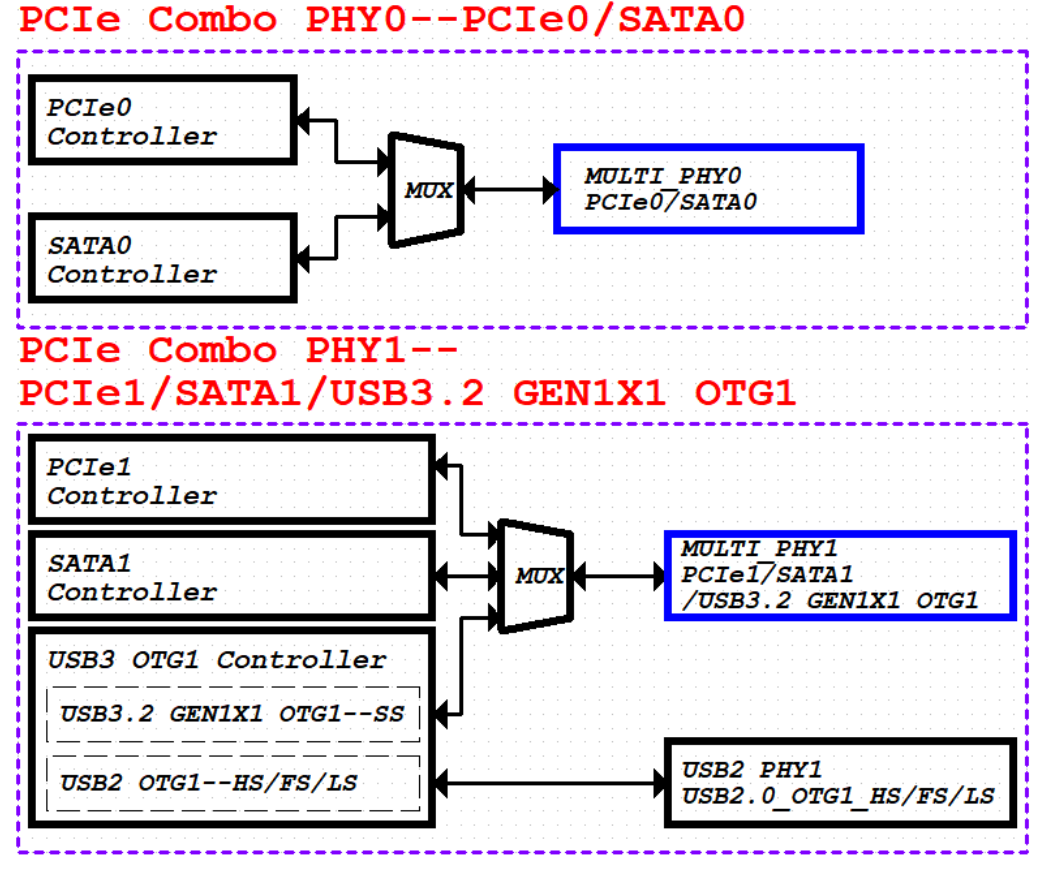
SATA0 controller uses Comb PHY0 (which is multiplexed with the PCIe0 Controller controller).

SATA1 controller uses Comb PHY1 (which is multiplexed with the PCIe1 Controller and the USB3 _ OTG1 controller).

SATA0/1 controller-related control IO are:
-SATA0_ACTLED: SATA0 interface with LED flicker control output during data transfer;
-SATA1_ACTLED: SATA1 interface with LED flicker control output during data transfer; -
-SATA_CPDET: Plug detection input for SATA hot-plug devices;
-SATA_MPSWIT: Switch detection input for SATA hot-plug devices;
-SATA_CPPOD: SATA control the power output switch of the hot plug device;
-Among them, SATA_CPDET, SATA_MPSWIT, and SATA_CPPOD are shared interfaces for SATA0/1, and either SATA0 or SATA1 can be configured via registers;
-Among them, SATA0_ACTLED and SATA1_ACTLED are multiplexed to two locations, one in the VCCIO6 power domain and the other in the VCCIO4 power domain.
Note:
When designing Slot, peripheral circuits and power supplies need to meet Spec requirements;
When a SATA interface is connected to an external SATA PM, it can only support a maximum of 5 ports and does not support multiple SATA PM with more than 6 ports;
A 10nF AC coupling capacitor is connected in series to the TXP/N,RXP/N differential signals of the SATA interface. It is recommended to use the 0201 package for the AC coupling capacitor, which has lower ESR and ESL and can also reduce impedance changes on the line;
For the eSATA interface connector, ESD devices must be added to all signals. During layout, the ESD devices should be placed close to the connector, and the parasitic capacitance shall not exceed 0.4pF.
3.5.17 PCIE2.1 Circuit
RK3576 has two PCIe 2.1 controllers, both of which only support RC mode (RC is the abbreviation of Root Complex) and do not support EP, as follows:
Controller 0(1Lane),PCIe0 Controller x1 Lane(Only RC)
Controller 1(1Lane),PCIe1 Controller x1 Lane(Only RC)
2 x PCIe2.1 controllers, together with SATA3.1/USB3.2_Gen1x1, form two Combo PHY, namely PCIe2.1/SATA3.1,
Combo PHY0, another is PCIe2.1/SATA3.1/USB3.2_Gen1x1 Combo PHY1.
The mapping diagram between Controller and PHY is as follows:
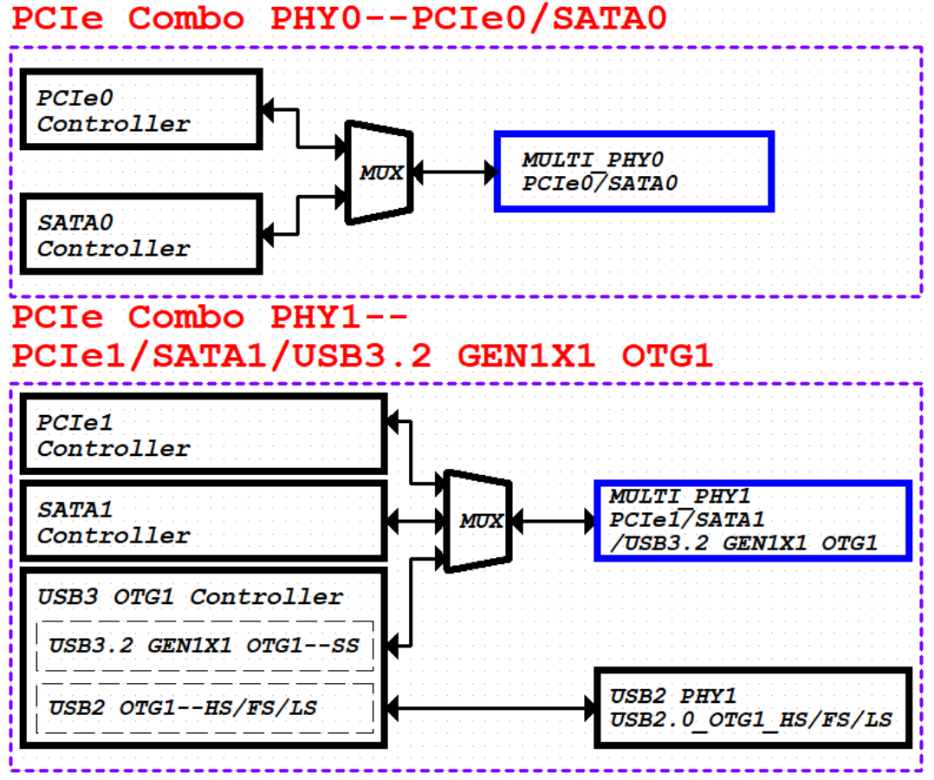
The PCIe0 controller (RC) and the SATA0 controller share the PCIe2.1/SATA3.1 Combo PHY0. The details of the package pins are shown as follows:
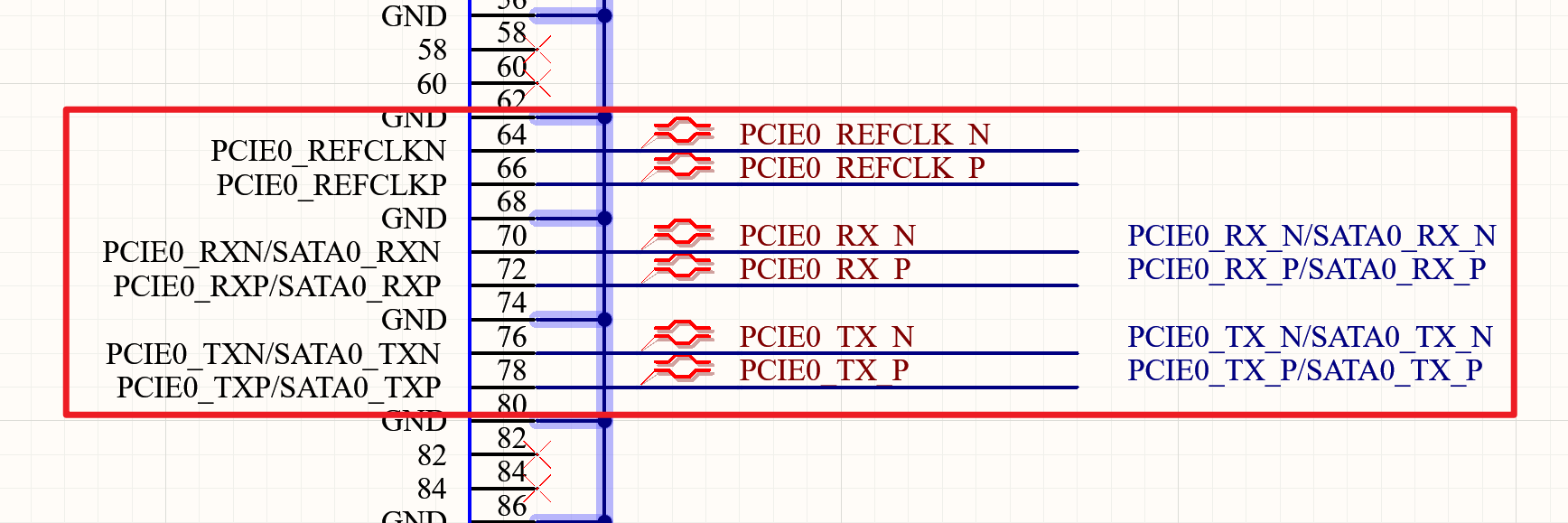
PCIe1 Controller (RC), SATA1 Controller, USB3 OTG1 Controller Multiplexing PCIe2.1/SATA 3.1/USB3.2 _ Gen1x1
Combo PHY1; The package pins are as shown in the following figure:

PCIE0/1_REFCLKP/N supports both output and input. By default, it provides output to EP devices, as shown in the following schematic diagram:

When PCIE0/1_REFCLKP/N is used as an input, the schematic diagram is as follows:
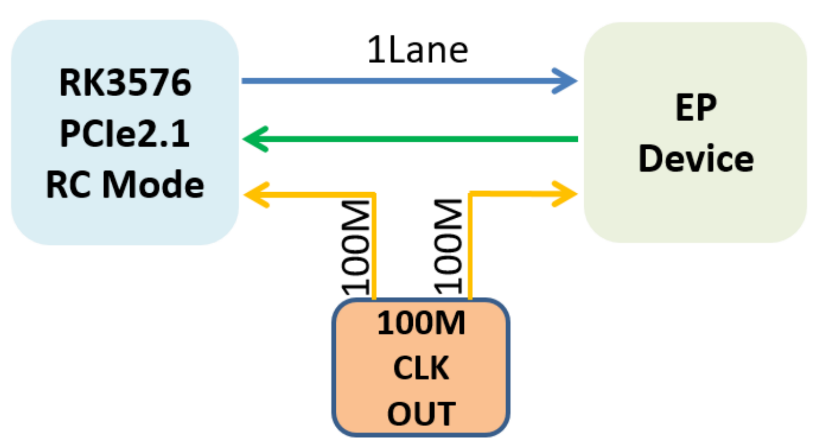
There is a PCIe0 channel on the OK3576 - C development board that is connected to a PCIe x1 slot, supporting the PCIe2.0×1Lane mode.
It supports the PCle Gen1 (2.4 GT/s) protocol, and another PCIe1 is multiplexed for the USB3.0 function.
The partial circuit of PCIe0 PCIe2.0×1Lane is as shown in the following figure:
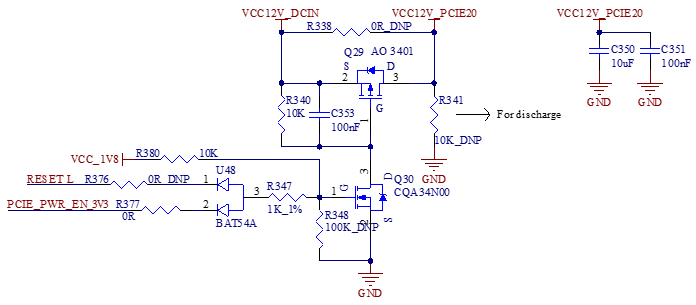
The above figure shows the 12V power supply control circuit for the PCIE interface.

The above figure shows the 3.3V power supply and enable control circuit for the PCIE interface. U42 is a step - down chip that converts 5V to 3.3V.
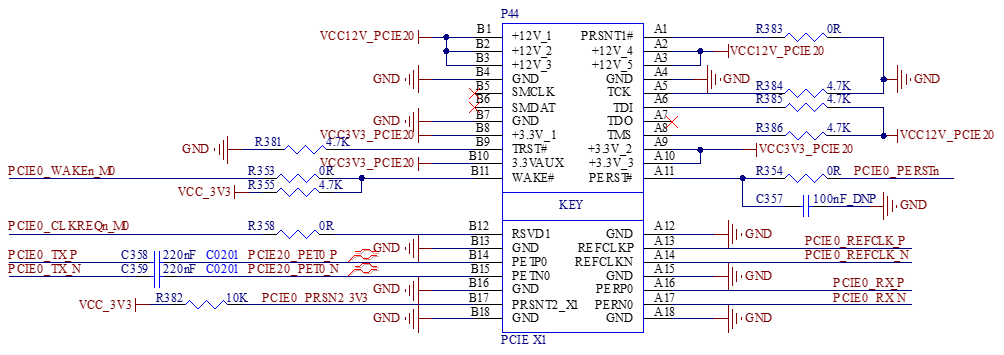
The figure above is the PCIEX1 slot circuit design.
Notes:
When designing Slot, peripheral circuits and power supplies need to meet Spec requirements;
A 100nF AC coupling capacitor is connected in series to the TXP/N differential signals of the PCIe2.1 interface. It is recommended to use the 0201 package for the AC coupling capacitor, which has lower ESR and ESL and can also reduce impedance changes on the line;
The function pins must be used for PCIE0/1_CLKREQN and cannot be replaced by GPIO;
For PCIE0/1_PERSTN/WAKEN/PRSNT on the RK3576, there is no need to specify a particular IO. You can directly use GPIO ports with matching levels as the control function pins;
For a standard PCIe Slot, the levels of PCIEx_CLKREQN, PCIEx_WAKEN, and PCIEx_PERSTN are 3.3V. Pay attention to the level matching of RK3576 terminal;
When using the PCIe function, the multiplexed SATA/USB functions cannot be used. For details of the corresponding functions of SATA/USB, please refer to the module description;
When the PCIe 2.1 functional module is not in use, the data lines PCIE0/1_TXP/TXN, PCIE0/1_RXP/RXN and the reference clock lines PCIE0/1_REFCLKP/REFCLKN can be left floating. The two power supplies, AVDD0V85 and AVDD1V8, should be grounded. Note that the corresponding dts configuration in the software needs to be disabled.
The recommended matching design for the PCIe 2.1 interface is shown in the following table:
Signal |
Connection |
Description |
|---|---|---|
PCIE0/1_TXP/TXN |
Series Connection with 100nF Capacitor (0201 Package Recommended): |
PCIe Data Output: |
PCIE0/1_RXP/RXN |
Direct Connection: |
PCIe Data Input |
PCIE0/1_REFCLKP/CLKN |
Direct Connection: |
PCIe Reference Clock: |
PCIE0/1_CLKREQN |
Serial Connection with 0ohm Resistor: |
PCIe Reference Clock Request Input (RC Mode): |
PCIE0/1_WAKEN(RK3576 does not have this signal, replaced with GPIO) |
Serial Connection with 0ohm Resistor: |
PCIe wake-up input (RC mode) |
PCIE0/1_PERSTN(RK3576 does not have this signal, replaced with GPIO) |
Serial Connection with 0ohm Resistor: |
PCIe global reset output (RC mode) |
PCIE0/1_PRSNT(RK3576 does not have this signal, replaced with GPIO) |
Serial Connection with 0ohm Resistor: |
Add In Card insertion detection input (RC Mode): |
PCIE_BUTTONRSTN(Not yet) |
No need to connect. |
External physical reset PCIe Controller. |
The impedance of the data traces should be controlled at a differential 85 ohm ±10%;
The impedance of the clock traces should be controlled at a differential 100 ohm ±10%;
The maximum time - delay difference within differential pair should be < 3mil;
The spacing between differential pairs should be ≥ 4 times the PCI-E trace width.
3.5.18 Video Input Interface
The FET3576 has two MIPI DPHY CSI RX interfaces, both of which support the MIPI V1.2 version. The maximum transmission rate of each channel is 2.5 Gbps.
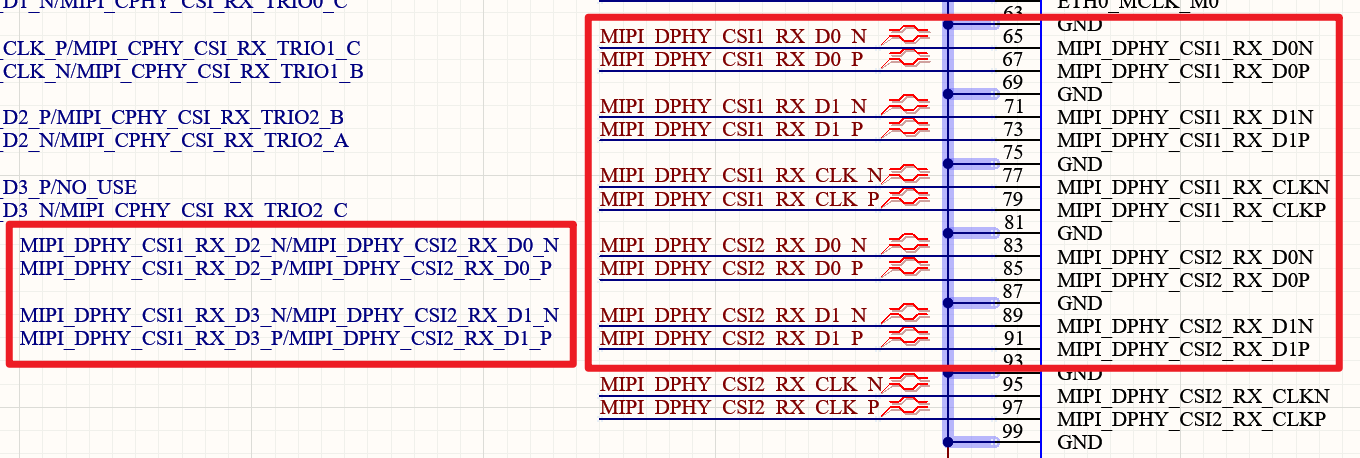

Supported modes of the MIPI DPHY CSI1/2 RX interfaces:
4Lane mode: The data of MIPI_DPHY_CSI1_RX_D[3:0] refers to MIPI_DPHY_CSI1_RX_CLK;
2Lane+2Lane mode:
·The data of MIPI DPHY CSI1_RX_D[1:0] refers to MIPI_DPHY_CSI1_RX_CLK.
·The data of MIPI DPHY CSI2_RX_D[1:0] refers to MIPI_DPHY_CSI2_RX_CLK.
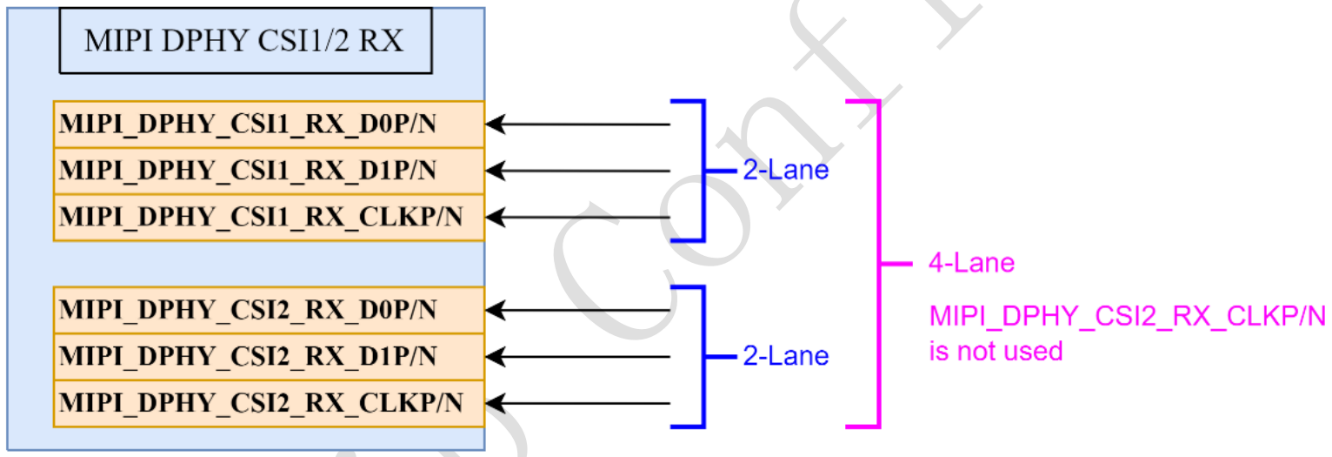
Supported modes of the MIPI DPHY CSI3/4 RX interfaces:
4Lane mode: The data of MIPI_DPHY_CSI3_RX_D[3:0] refers to MIPI_DPHY_CSI3_RX_CLK;
2Lane+2Lane mode:
·The data of MIPI DPHY CSI3_RX_D[1:0] refers to MIPI_DPHY_CSI3_RX_CLK.
·The data of MIPI DPHY CSI4_RX_D[1:0] refers to MIPI_DPHY_CSI4_RX_CLK.
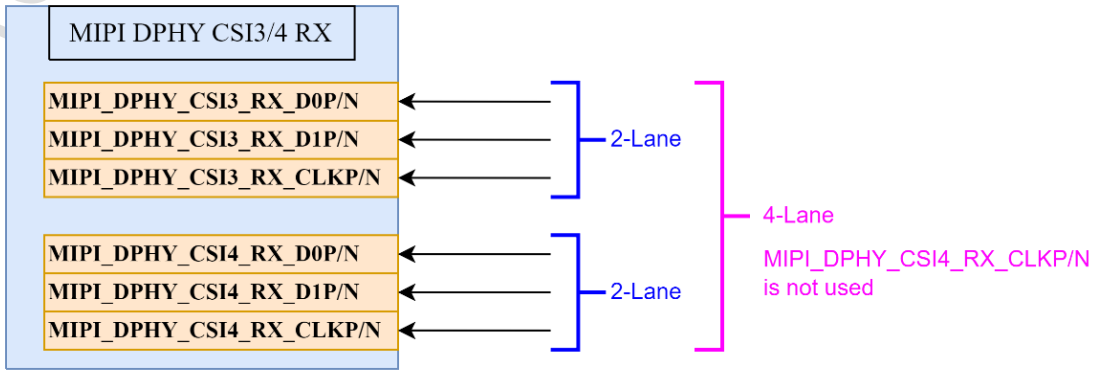
Supported modes of the MIPI_DCPHY_CSI_RX interface:
The FET3576 has 1 x MIPI DCPHY CSI RX Combo PHY. The DPHY supports version V2.0, and the CPHY supports version V1.1. In the DPHY mode, there are 4Lane with a maximum transmission rate of 4.5 Gbps per lane.
In the CPHY mode, there are 3Trios with a maximum transmission rate of 5.7 Gbps per trio.

DPHY and CPHY configuration support: **
The TX and RX of the MIPI DCPHY Combo PHY can only be configured as DPHY TX and DPHY RX modes simultaneously, or CPHY TX and CPHY RX modes simultaneously. It does not support configuring one as DPHY TX and the other as CPHY RX, or one as CPHY TX and the other as DPHY RX.
Supported modes when the MIPI DCPHY operates in the DPHY mode:
It supports 4Lane/2Lane/1Lane modes. The data of MIPI_DPHY_CSI0_RX[3:0] refers to MIPI_DPHY_CSI0_RX_CLK.
It does not support splitting into 2Lane + 2Lane.
Supported modes when the MIPI DCPHY operates in the CPHY mode:
It supports 0/1/2 Trio. Each Trio has 3 lines: Trio_A/Trio_B/Trio_C, namely MIPI_CPHY_CSI_RX_TRIO[2:0]_A, MIPI_CPHY_CSI_RX_TRIO[2:0]_B, and MIPI_CPHY_CSI_RX_TRIO[2:0]_C.
The default configuration of the OK3576 - C is 5 camera interfaces, which are: MIPI_DPHY_CSI0_RX 4Lane, MIPI_DPHY_CSI1_RX 2Lane, MIPI_DPHY_CSI2_RX 2Lane, MIPI_DPHY_CSI3_RX 2Lane, and MIPI_DPHY_CSI4_RX 2Lane. The principle is as follows:
Notes:
Differential trace impedance requirement: 100ohm±10%;
Single-ended trace impedance requirement: 50ohn±10%;
Maximum time - delay difference within differential pair: < 3mil;
Equal length between clock and data:<6mil;
Spacing between differential pairs should be > 4 x MIPI trace, and at a minimum, it should be 3 times the MIPI trace;
The space between MIPI and other signal is better > 4 times MIPI line width and at least 3 times MIPI line width;
When it is configured as CPHY, the maximum inter-group delay difference <3mil (TRIO_A\TRIO_B\TRIO_C);
Length matching requirement between groups (TRIO0\TRIO1\TRIO2) should be <50mil.
3.5.19 Video Output Interface
The VOP (Video Output Processor) of the RK3576 chip reads video data and UI data from the frame buffer in the system memory, performs corresponding processing such as cropping, color gamut space conversion, scaling, and overlay, and then outputs the processed data to each high - speed display interface.
There are three Port outputs, which can output video through DP, HDMI/eDP, MIPI DSI, and LCDC (Parallel Interface) video interfaces.
The maximum video output capabilities are as follows:
Three - screen different - display solution: For example, 4096x2160@60Hz, 2560x1600@60Hz, and 1920x1080@60Hz.
Two - screen different - display solution: For example, 4096x2160@120Hz and 2560x1600@60Hz.
VOP and video interface output path diagrams are as follows:
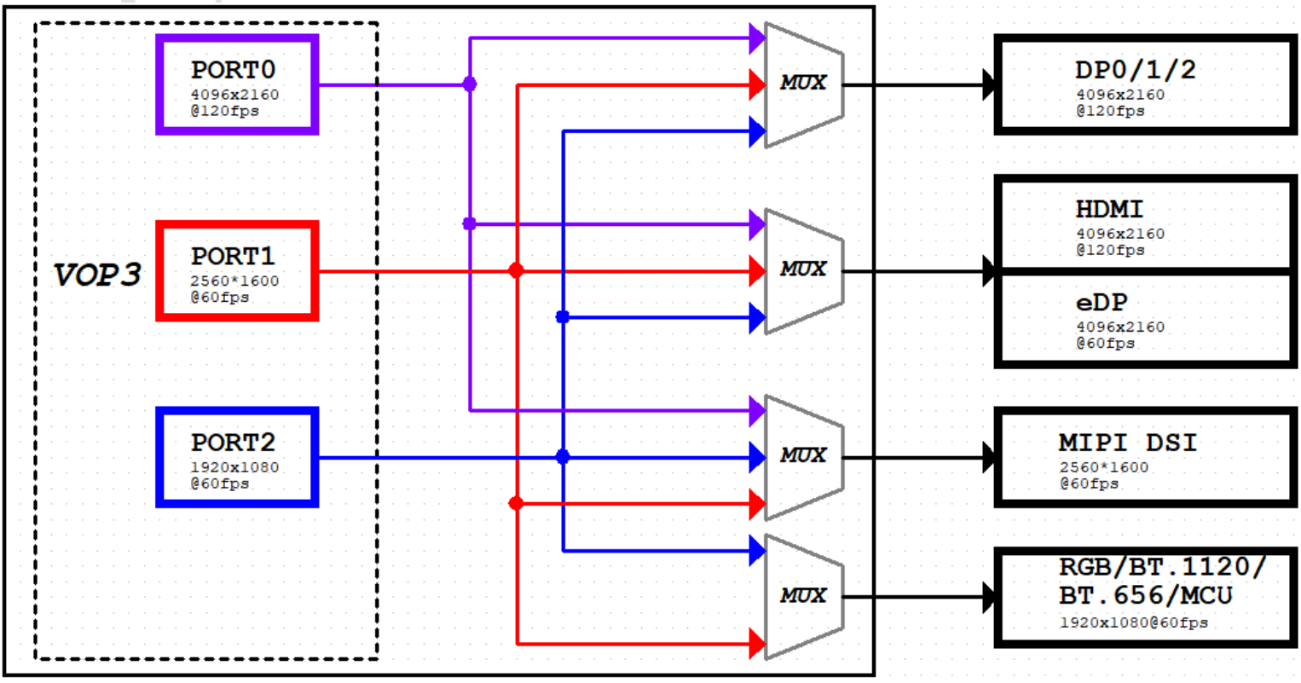
OK3576-C development board supports DP/MIPI _ DSI/HDMI three display output interface.
3.5.19.1 MIPI_DSI Interface
The FET3576 has one MIPI D - PHY/C - PHY Combo PHY TX:
D - PHY: It supports version V2.0. In the D - PHY mode, there are 0/1/2/3 lanes, and each lane has 2 lines. The maximum transmission rate is 2.5 Gbps per lane.
The MIPI_DPHY_TX supports a maximum resolution of 2560x1600@60Hz.
C - PHY: It supports version V1.1. In the C - PHY mode, there are 0/1/2 Trio, and each trio has 3 lines (Trio A/B/C). The maximum transmission rate is 1.7 Gsps per trio.
The MIPI_CPHY_TX supports a maximum resolution of 2560x1600@60Hz.
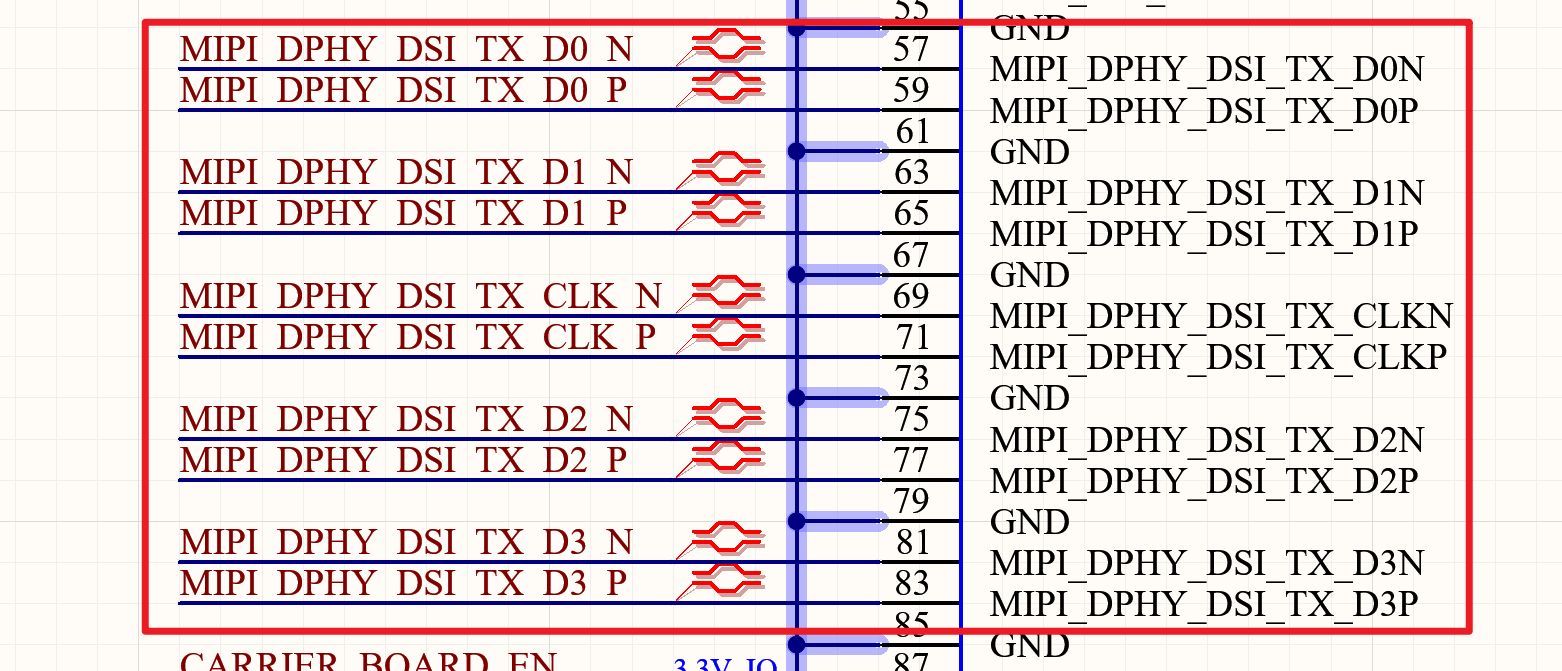
DPHY and CPHY configuration support:
The TX and RX of MIPI D-PHY/C – PHY Combo PHY can only be configured in DPHY TX and DPHY RX modes or CPHY TX and CPHY RX modes at the same time, and one is configured as DPHY TX and the other as CPHY RX is not supported;
Supported modes when the MIPI DCPHY operates in D-PHY mode
4Lane mode: The data of MIPI_DPHY_TX_D[3:0] refers to MIPI_DPHY_TX_CLK;
Supported modes when the MIPI DCPHY operates in C-PHY mode **
Supports 0/1/2 Trio. Each Trio has three lines, namely Trio A, Trio B, and Trio C, corresponding to MIPI_CPHY_TX_TRIO[2:0]_A,
MIPI_CPHY_TX_TRIO[2:0]_B, MIPI_CPHY_TX_TRIO[2:0]_C。
The MIPI_DSI interface of the OK3576-C development board uses a mode of 1 set of clock channels+4 sets of data channels. The schematic diagram is as follows:
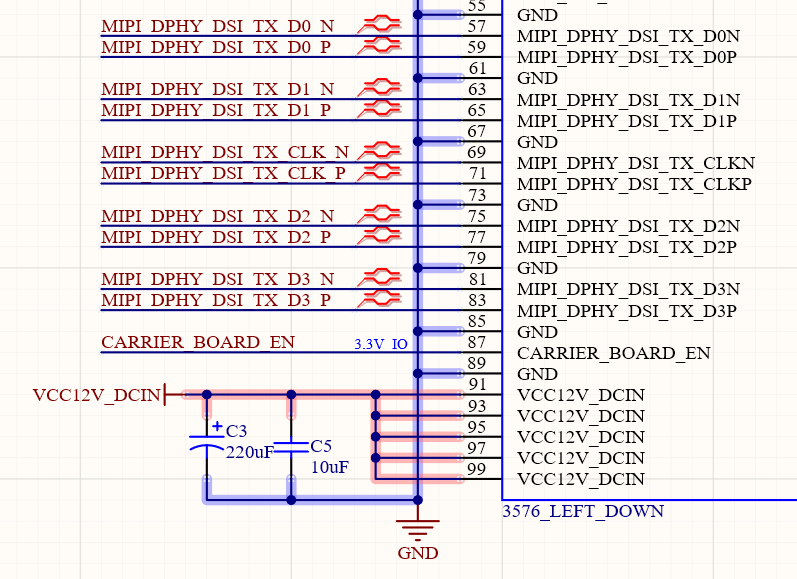
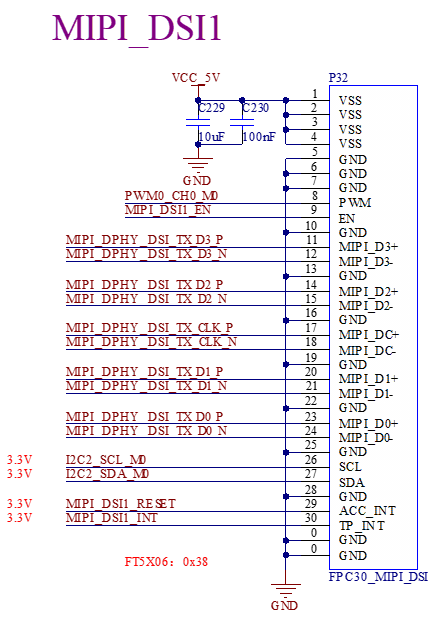
Notes:
The differential impedance of the traces should be controlled within 100 ohm ± 10%;
Maximum time - delay difference within differential pair: < 3mil;
Equal length between clock and data:<6mil;
Differential inter-pair space is recommended to be more than or equal to 4 times the MIPI line width, and at least 3 times MIPI line width;
MIPI and other signal space is recommended to be more than or equal to 4 times the MIPI line width, and at least 3 times MIPI line width;
For CPHY, the single-ended trace impedance should be controlled at 50ohm±10%;
Inter-group delay difference <3mil (TRIO_A\TRIO_B\TRIO_C);
The length matching requirement between groups (TRIO0\TRIO1\TRIO2) should be < 50 mil;
It is recommended that the number of vias allowed for each signal should ≤ 2;
It is recommended that the spacing between differential pairs should ≥ 4 × MIPI trace width;
It is recommended that the spacing between MIPI and other signals should ≥ 4 × MIPI trace width.
3.5.19.2 HDMI_TX Interface
RK3576 has 1 x built-in HDMI/eDP TX Combo PHY.
-HDMI/eDP TX Combo PHY supports the following two modes:
HDMI TX Mode:
Supports up to HDMI 2.1;
Supports the HDMI FRL mode and is backward - compatible with the HDMI TMDS mode;
Supports RGB/YUV444/YUV422/YUV420 (Up to 10bit) formats. 2. eDP TX Mode:
It supports up to eDP 1.3;
The maximum resolution it supports is 4K@60Hz;
It supports RGB/YUV444/YUV422 (Up to 10bit) formats.
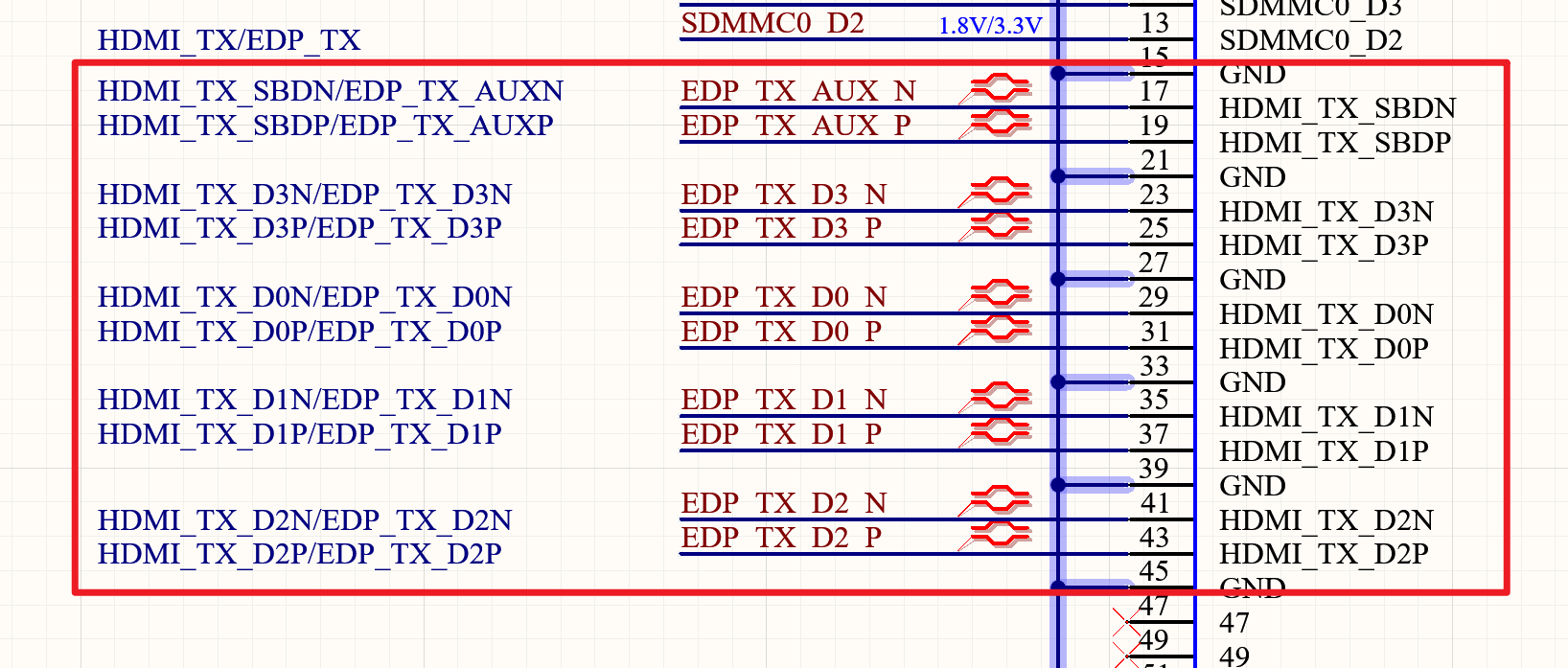
RK3576 supports HDMI 2.1 and downward for HDMI 2.0, compatible with HDMI 1.4. Because HDMI 2.1 works in FRL mode and works in TMDS mode, when switching to HDMI 2.0 and below, it will work in TMDS mode, so the AC coupled voltage mode driver is used.
As shown in the figure below, the AC coupling capacitor capacitance is 220nF, which cannot be changed at will; because the lower ESR and ESL can also reduce the impedance change on the line, it is recommended to use the 0201 packaging for the AC coupling capacitor.
When operating in the HDMI 2.1 mode, the HDMI_TX_ON_H is configured to a low level, and Q15, Q16, Q17, and Q18 are non - conducting.
When operating in HDMI 2.0 and below, HDMI _ TX _ ON _ H is configured high, Q15, Q16, Q17, and Q18 are turned on, and the 499ohm resistor to ground and the 50ohm pull-up resistor at the Sink terminal form a DC bias of approximately 3 V.
Notes:
When only HDMI 2.0 and lower modes need to be supported, components Q15, Q16, Q17, and Q18 must not be omitted. It is essential to ensure that the transistors remain non-conductive when the device is powered off, as the HDMI CTS Test ID 7-3 TMDS Voff test requires that the Voff voltage stays within ±10mV of AVcc when the Device Under Test (DUT) is unpowered; otherwise, this test item will fail.
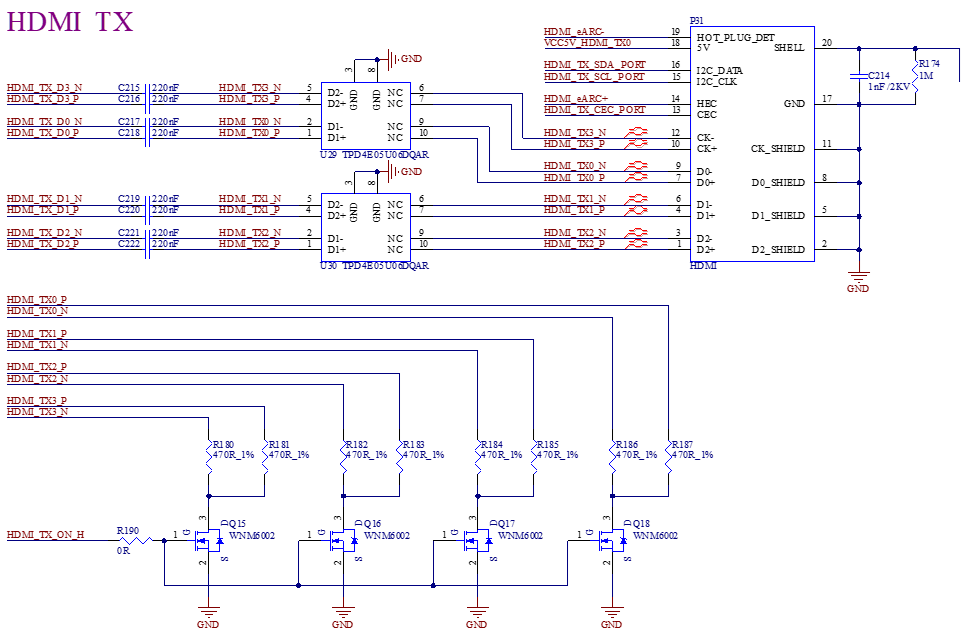
FRL mode: In the traditional TMDS architecture, a separate channel is used to transmit the Clock. But in the FRL architecture, the Clock is embedded in the Data channel, and the Clock is resolved at the Sink side through the Clock Recovery.
FRL rate vs. channel relationship:
Channel Rate |
Channel Quantity |
|---|---|
3Gbps |
3 |
6Gbps |
3 |
6Gbps |
4 |
8Gbps |
4 |
10Gbps |
4 |
12Gbps |
4 |
It supports ARC/eARC. The audio data can be parsed inside the RK3576 through the HDMI_TX_SBD_P/HDMI_TX_SBD_N signals.
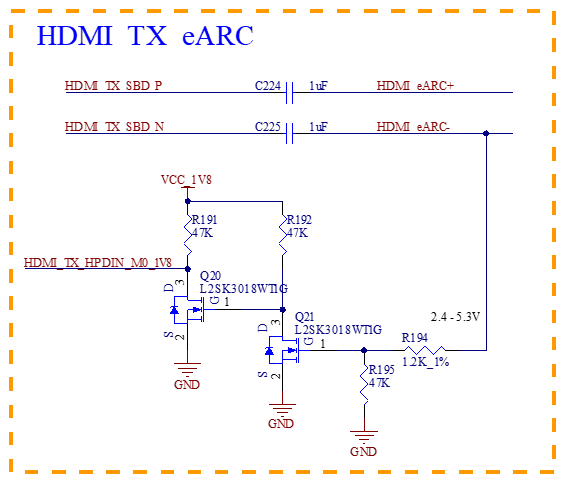
HDMI_TX_HPD is the HDMI TX controller multiplexed to a general - purpose GPIO. Its level follows the voltage of the power domain it belongs to. If the power supply voltage of the power domain changes, the power supply of the pull - up resistor in the peripheral circuit must also be adjusted synchronously.
HDMI_TX_CEC is the CEC function of the HDMI controller multiplexed to a general - purpose GPIO. Its level follows the voltage of the power domain it belongs to. If the power supply voltage of the power domain changes, the power supply of the pull - up resistor in the peripheral circuit must also be adjusted synchronously.
The CEC protocol specifies a 3.3V level. However, the protocol requires that the leakage should not exceed 1.8uA when adding 3.3V to the CEC pin through a 27K resistor.
RK3576 IO Domain Leakage will occur if there is a voltage at IO in the power-down state. For example, the RK3576 is a power failure, and its HDMI cable is in connection to the Sink side (TV or monitor); meanwhile, the CEC at the Sink side has power and leaks through the HDMI cable to the RK3576 IO, which will cause the CEC to leak more than 1.8uA, so an external isolation circuit is necessary. We can not modify the R189 resistance at will, and we need to use 27Kohm, Q19 default, and selection 2SK3018. If needing to change other models, the junction capacitor must be the equivalent, if not, it will not only affect the work but will also affect the certification through.
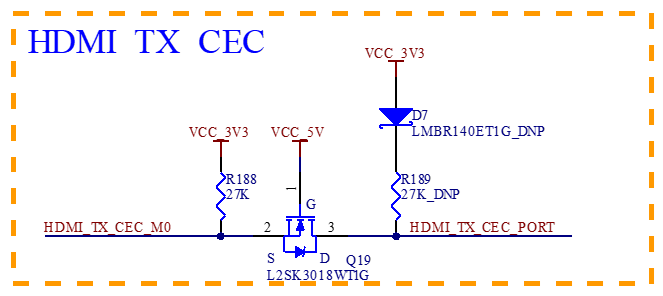
HDMI-TX-SCL/HDMI-TX-SDA is the I2C/DDC bus of the HDMI TX controller, which is functionally multiplexed onto a regular GPIO. The level varies with the voltage of the power domain, and the power supply voltage of the power domain changes. The pull-up resistor of the peripheral circuit must also be synchronously adjusted.
Although the DDC_SCL/DDC_SDA protocol specifies a 5V level, the RK3576 IO does not support a 5V level, so the level conversion circuit need to be added and can not be deleted. The default is to use MOS tube level conversion, and the MOS type is 2SK3018; If the model needs to be changed, the junction capacitance must be equivalent, because the junction capacitance is too large, not only affecting the work and also affect the certification leading to failing certification.
It is recommended to refer to the default value for the pull-up resistance and not to modify it arbitrarily.
The D6 diode cannot be removed and is used to prevent leakage from the Sink side to VCC_5V0.
1K in series between MOS gate for SDA signal level conversion and power supply; A 100pF is connected in parallel between the MOS gate and source to improve the timing and can not be removed.
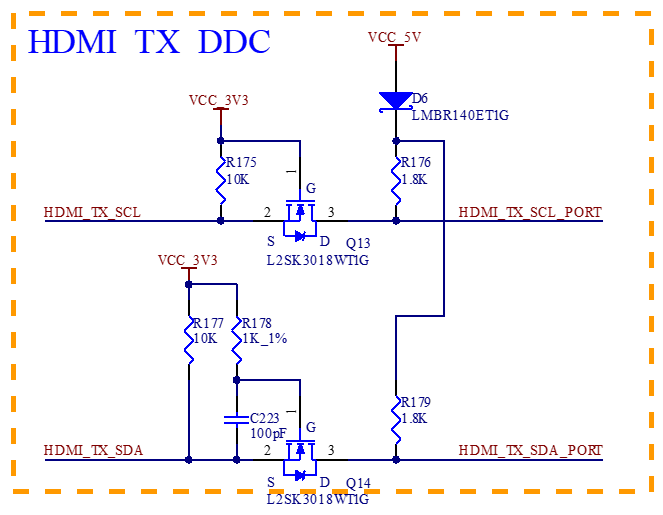
HDMI holder Pin18 voltage needs to be kept between 4.8-5.3V, 1uF decoupling capacitor needs to be placed on the pin, which must not be deleted, and the layout is placed close to the HDMI holder pin.
To strengthen the anti-static capability, ESD devices must be reserved on the signal. ESD parasitic capacitance of HDMI2.1 signal must not exceed 0.2pF.
ESD parasitic capacitance for other signals is recommended to use no more than 1pF.
Notes:
Control MOS tube Coss can not be too large, otherwise it will affect the signal quality, it is recommended to follow the reference chart model or the corresponding Coss value;
The differential impedance of the traces should be controlled within 100 ohm ± 10%;
Maximum time - delay difference within differential pair: < 3mil;
Equal Length Requirement Between Differential Pairs<200mil;
The spacing between differential pairs should be at least 7 times the HDMI trace width;
Spacing Between HDMI and other signals: ≥7 times the HDMI trace;
It is recommended to avoid vias;
I/O capacitance to ground does not exceed 0.2pF.
3.5.19.2 DP_TX Interface
The RK3576 supports a DP 1.4 TX PHY (combined with USB3 OTG0), with a maximum output resolution of up to 4K@YUV422 - 120Hz.
·Each Lane rate can support 1.62/2.7G/5.4/8.1Gbps;
·Supports 1Lane or 2Lane or 4Lane mode;
·Supports RGB/YUV444/YUV422/YUV420 (up to 10bit) format;
·Supports Multi Stream Transport(MST);

·Supports two modes: Swap on and Swap off;

·Supports 3 - channel MST (Multi - Stream Transport) display. The maximum capabilities of the MST for triple - screen different display are: 4096x2160@60Hz, 2560x1600@60Hz, and 1920x1080@60Hz.

Please refer to section 3.5.15 for the USB pin multiplexing.
Notes:
DP0_TX_D0P/D0N, DP0_TX_D1P/D1N, DP0_TX_D2P/D2N, DP0_TX_D3P/D3N, DP1_TX_D0P/D0N, DP1_TX_D1P/D1N, DP1_TX_D2P/D2N, DP1_TX_D3P/D3N require 100nF AC coupling capacitors to be connected in series. It is recommended to use the 0201 package for the AC coupling capacitors, which have lower ESR and ESL and can also reduce the impedance variation on the line. When laying out, place them close to the FET3576 - C pin;
Routing impedance control differential 100ohm ± 10% (as DP interface only, no multiplexing), differential 95ohm ±10% (USB3.0/DP1.4 multiplexing);
The delay difference within the differential pair should be <3mil;
Equal Length Requirement Between Differential Pairs<500mil;
The spacing between differential pairs should be at least 6 times the DP trace width;
It is recommended that the spacing between DP and other signals should ≥ 6 × DP trace width;
It is recommended that the number of vias allowed for each signal should ≤ 2;
I/O capacitance to ground does not exceed 0.2pF.
3.5.20 WIFI/BT Module Circuit
The OK3576 - C board is equipped with a Haihua AW - CM358SM WIFI & BT module, which supports WIFI 2.4G/5G and Bluetooth 5.0. The WIFI/BT antennas are led out through SMA interfaces, and the SDIO, PDM, and UART interfaces are connected to the main controller. The schematic is as follows:
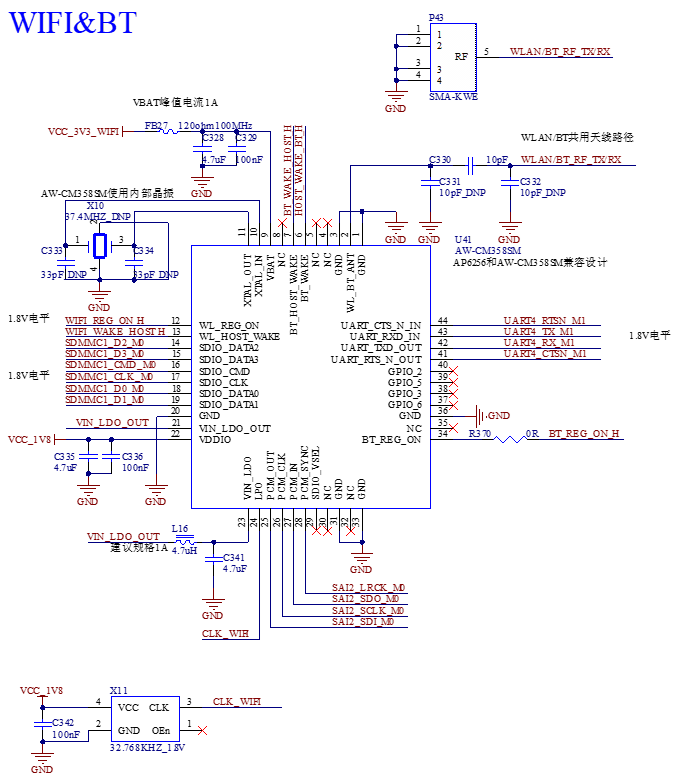
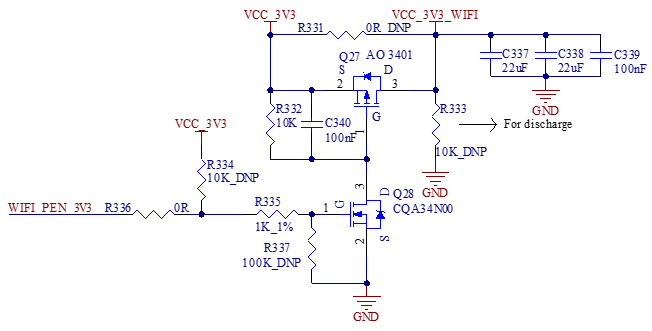
Note:
The power supply for the WIFI card must be controlled; please refer to the carrier board circuit;
SDIO impedance requirements: Single-ended 50ohm, signal equal length control 50 mil;
I2C Requirements:
Multiple slave devices can be connected on a single I2C bus, ensuring no address conflicts.
Pull - up resistors are required on the I2C bus, but multiple resistors should not be used for pull - up.
Please ensure level matching between the I2C on the SoM side and the I2C of the slave device.
USB Design:
To meet the requirements of the USB eye diagram, the PCB trace length of USB3.0 TX/RX should not exceed 6 inches.
The unused signal pins of the SoM can be left floating, but please make sure to connect all the GND pins.
Power - on Sequence:
It is strongly recommended to refer to the design of the development board when designing the carrier board. Use the CARRIER_BOARD_EN output by the SoM as the power-on enable for the carrier board, and strictly control the power-on sequence. Or it may have the following influences:
·Excessive current during the power - on phase.
·The device fails to start.
·In the worst - case scenario, irreversible damage to the processor.
For detailed hardware design information, please refer to the “FET3576-C _ Hardware Design Guide”.
SoM Connector Dimension:
A=21.52mm, B=19.6mm, C=3.2mm, Contacts=100
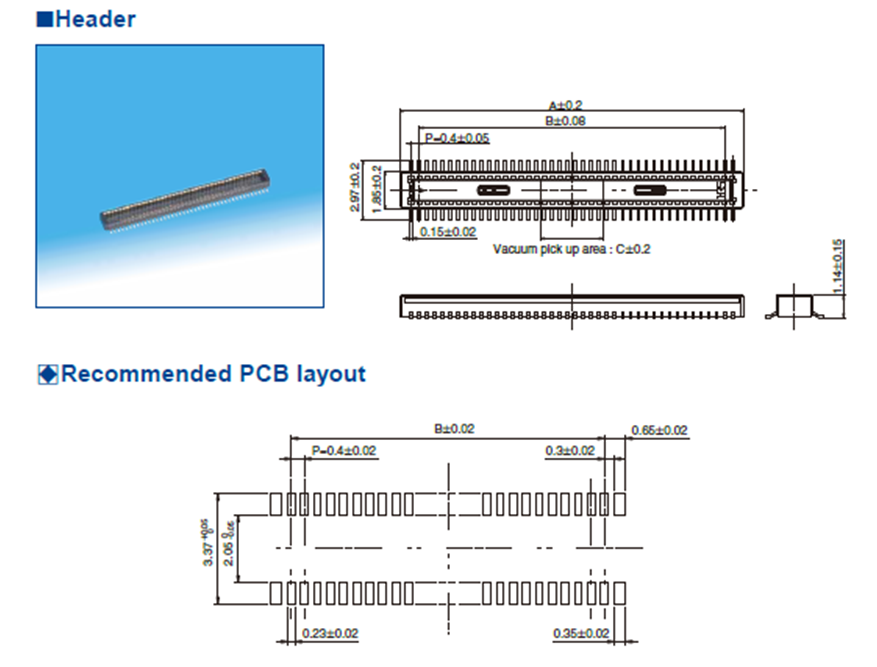
Carrier board Connector Dimension:
A=22.6mm, B=19.6mm, C=3.2mm, D=1.45mm, Contacts=100
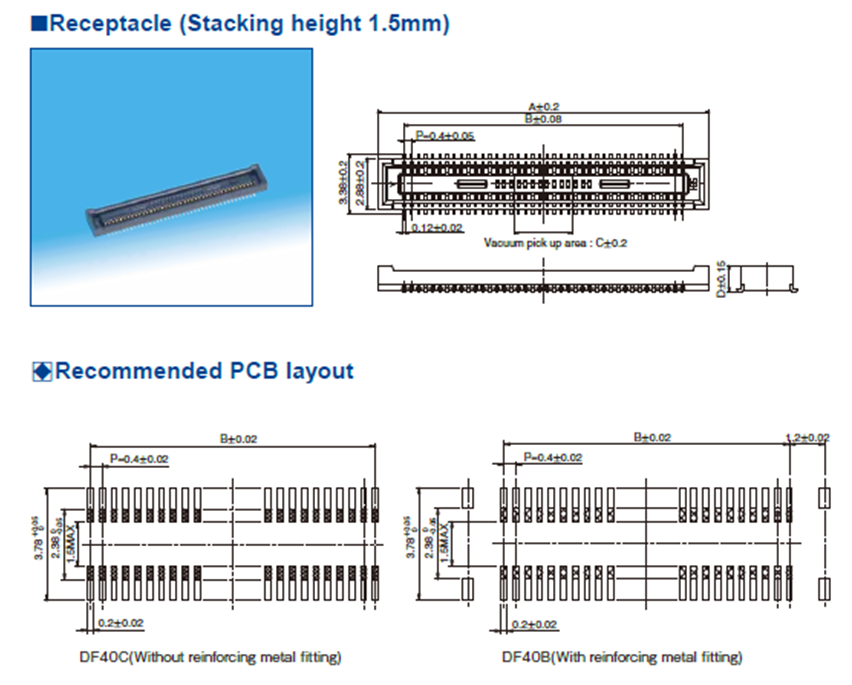
Table 1. Linux system power consumption
No. |
Test Item |
SoM Power (W) |
Development Board Power (including SoM) (W) |
|---|---|---|---|
1 |
No-load startup peak power |
3.66 |
5.88 |
2 |
No-load standby power |
0.82 |
2.33 |
3 |
CPU+GPU+memory+eMMC pressure test |
5.87 |
7.39 |
4 |
7-inch LCD screen + 4G + U disk + video decoding |
2.02 |
10.02 |
5 |
7-inch LCD screen + 4G + U disk + video encoding |
3.06 |
10.48 |
6 |
Pwron Key Press and hold to shut down |
0.28 |
0.32 |
7 |
Pwron Key Short press to sleep |
TBD |
TBD |
Note:
Test conditions: The SoM configuration is 4GB memory + 32GB eMMC, the 4G module is moved away from EM05-CE, and the screen is an optional product of Forlinx. SoM power supply is 12V and development board is 12V;
Peak power: The peak current during startup multiplied by the supply voltage;
Standby power: The current value in the power-on interface after startup multiplied by the power supply voltage;
Power consumption is for reference only.
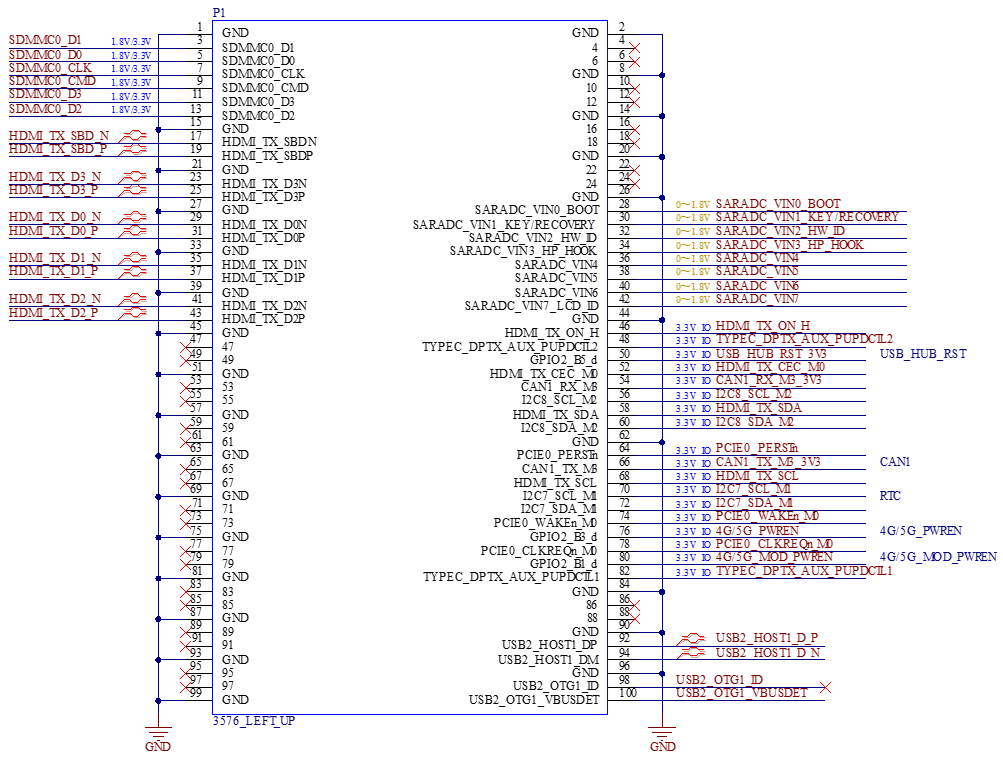
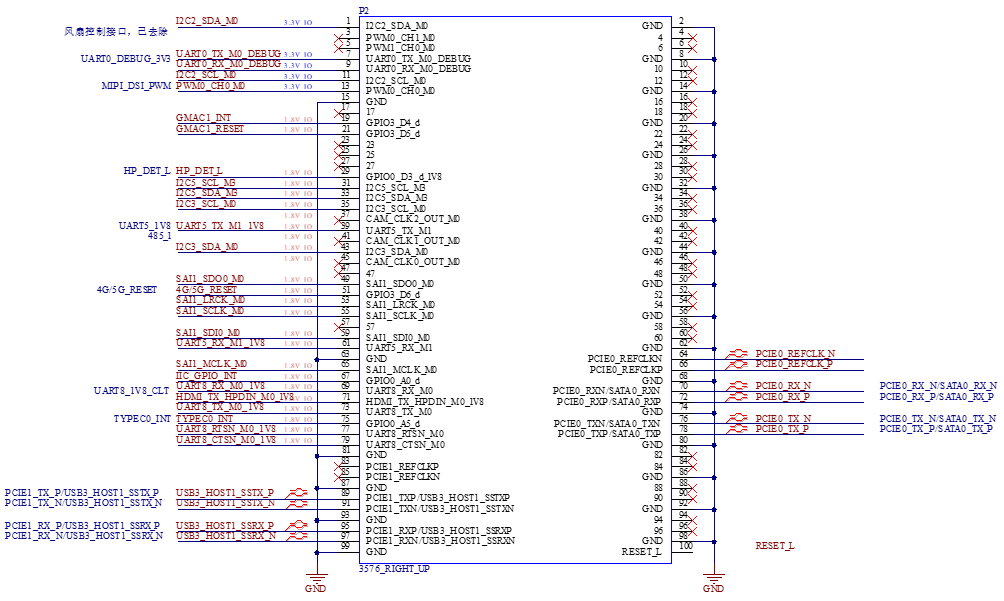
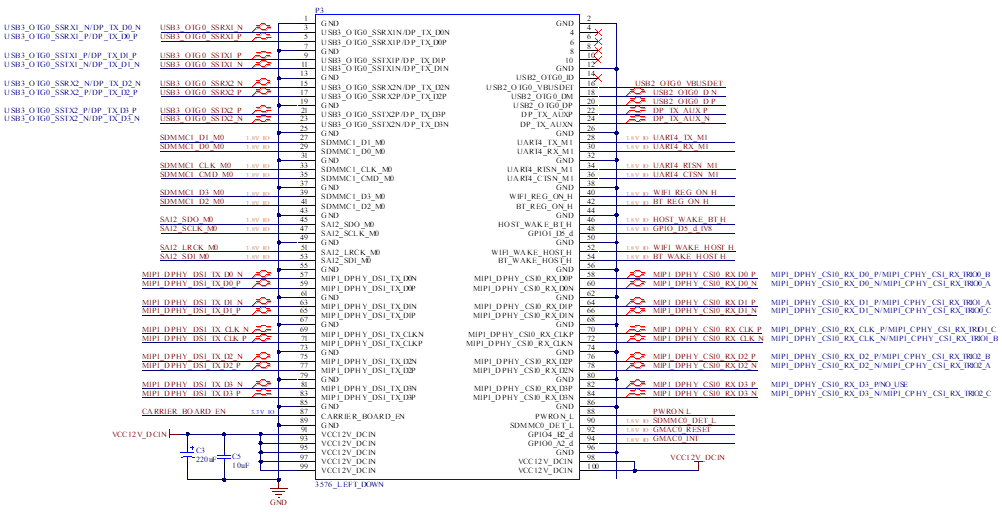
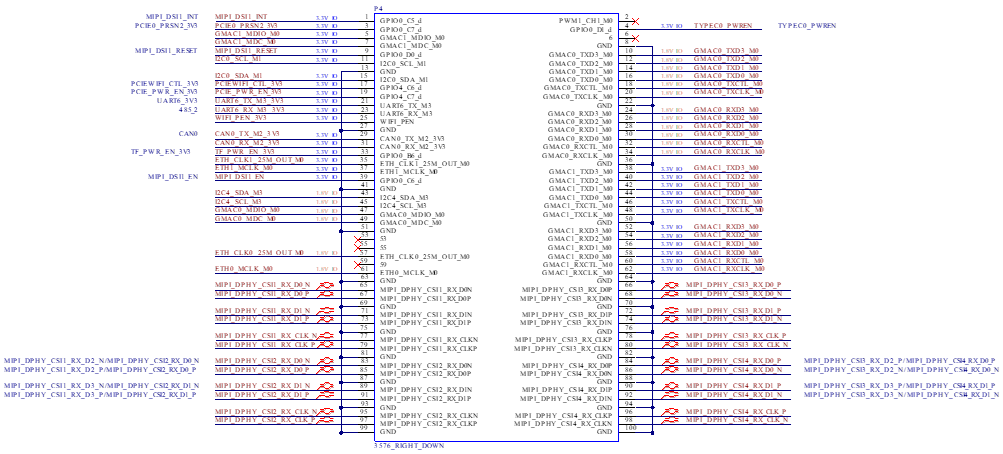

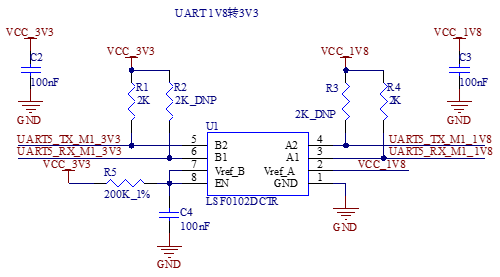
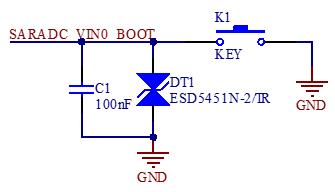
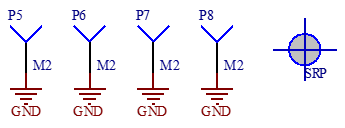
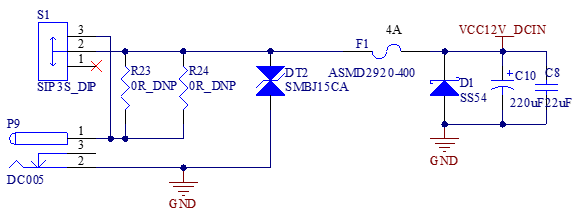
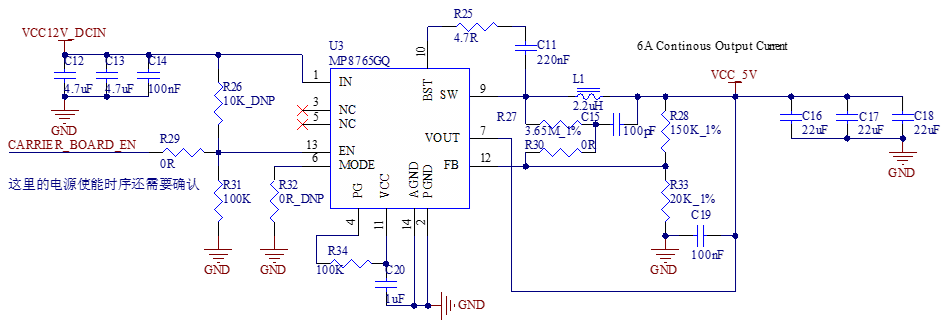

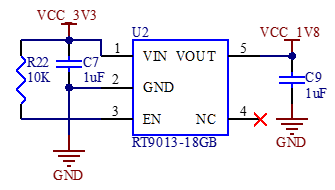
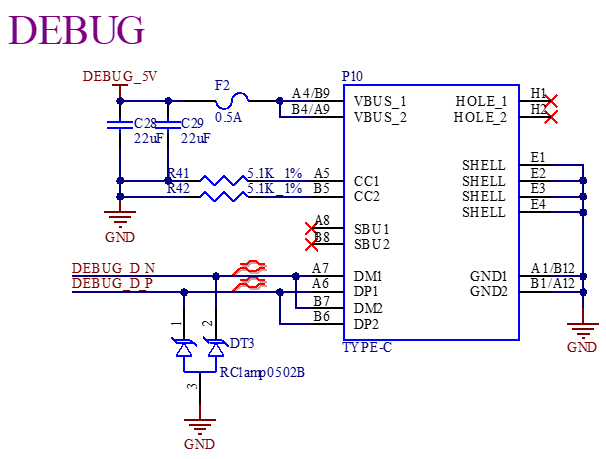
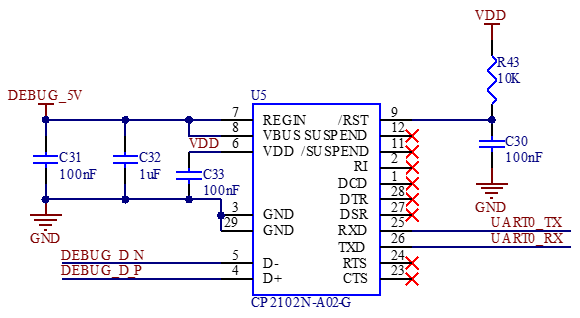

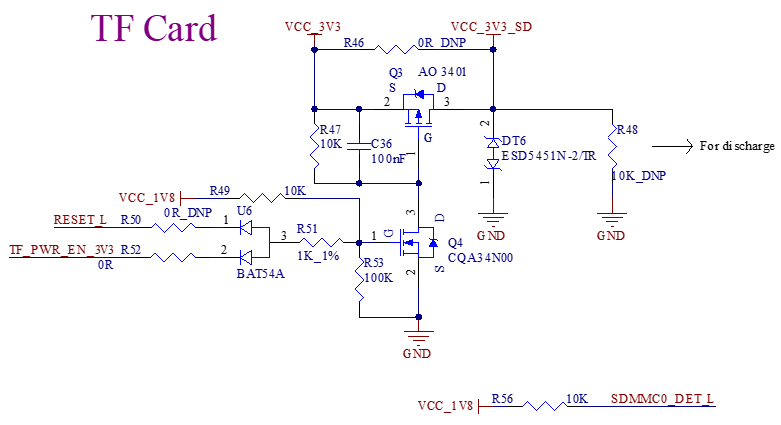
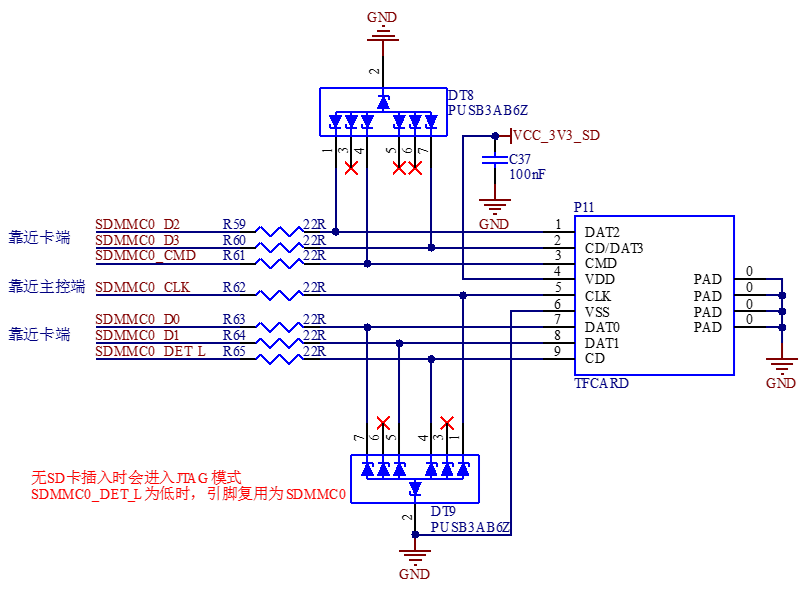

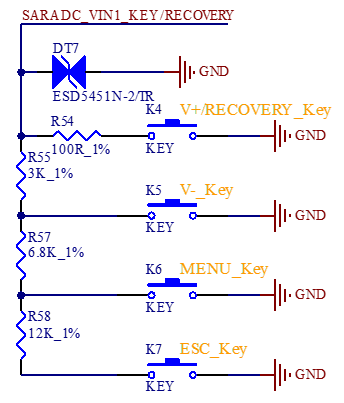
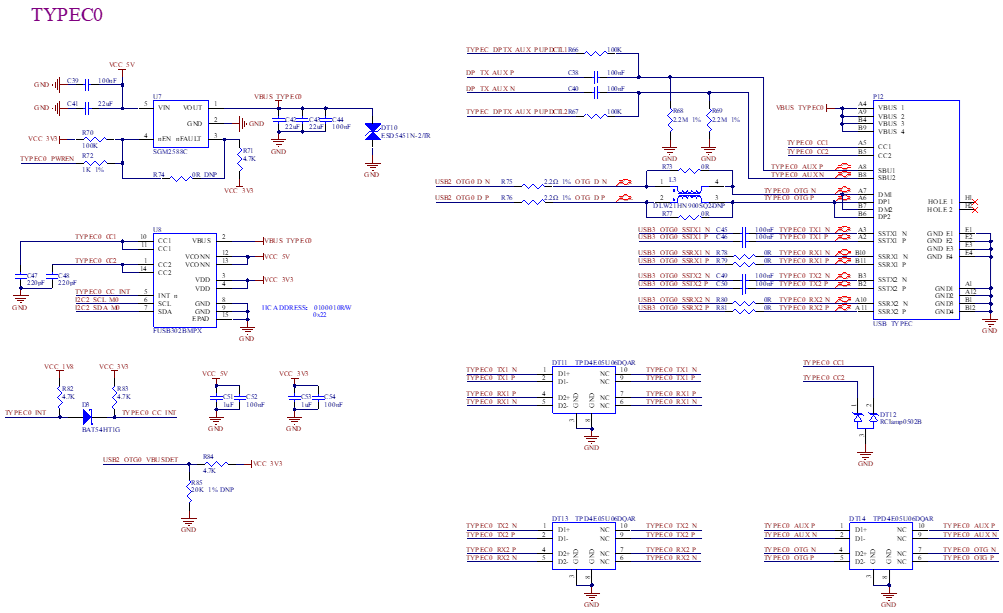
The above figure is only a schematic diagram. Please refer to the schematic diagram of the source file for the specific connection. In order to meet the normal work of the SoM, the minimum system includes the SoM power supply, the system programming circuit, and the debugging serial circuit.
4. Hardware Design Guide
I2C Requirements:
Multiple slave devices can be connected on a single I2C bus, ensuring no address conflicts.
Pull - up resistors are required on the I2C bus, but multiple resistors should not be used for pull - up.
Please ensure level matching between the I2C on the SoM side and the I2C of the slave device.
USB Design
To meet the requirements of the USB eye diagram, the PCB trace length of USB3.0 TX/RX should not exceed 6 inches.
The unused signal pins of the SoM can be left floating, but please make sure to connect all the GND pins.
Power - on Sequence
It is strongly recommended to refer to the design of the development board when designing the carrier board. Use the CARRIER_BOARD_EN output by the SoM as the power-on enable for the carrier board, and strictly control the power-on sequence.. Or it may have the following influences:
·Excessive current during the power - on phase.
·The device fails to start.
·In the worst - case scenario, irreversible damage to the processor.
Note: For detailed hardware design information, please refer to the “FET3576-C _ Hardware Design Guide”.
5. Connector Dimension Diagram
SoM Connector Dimension:
A=21.52mm, B=19.6mm, C=3.2mm, Contacts=100

Carrier board Connector Dimension:
A=22.6mm, B=19.6mm, C=3.2mm, D=1.45mm, Contacts=100

6. OK3576-C Development Board Power Consumption Table
Table 1. Linux system power consumption
No. |
Test Item |
SoM Power (W) |
Development Board Power (including SoM) (W) |
|---|---|---|---|
1 |
No-load start-up peak power |
3.66 |
5.88 |
2 |
No-load standby power |
0.82 |
2.33 |
3 |
CPU+GPU+memory+eMMC pressure test |
5.87 |
7.39 |
4 |
7-inch LCD screen + 4G + U disk + video decoding |
2.02 |
10.02 |
5 |
7-inch LCD screen + 4G + U disk + video encoding |
3.06 |
10.48 |
6 |
Pwron Key Press and hold to shut down |
0.28 |
0.32 |
7 |
Pwron Key Short press to sleep |
TBD |
TBD |
Table2. Android System Consumption
No. |
Test Item |
SoM Power (W) |
Development Board Power (including SoM) (W) |
|---|---|---|---|
1 |
No-load start-up peak power |
4.86 |
7.09 |
2 |
No-load standby power |
0.95 |
2.43 |
3 |
Antutu 3D Test Peak Power |
6.04 |
10.29 |
4 |
Pwron Key Press and hold to shut down |
0.28 |
0.32 |
5 |
Pwron Key Short press to sleep |
0.65 |
2.19 |
Note:
Test conditions: The SoM configuration is 4GB memory + +32GB eMMC; the 4G module is Quectel EM05-CE, and the screen is an optional product. SoM power supply is 12V and development board is 12V;
Peak power: The peak current during startup multiplied by the supply voltage;
Standby power: The current value in the power-on interface after startup multiplied by the power supply voltage;
Power consumption is for reference only.
7. Minimum System Schematic




















The above figure is only a schematic diagram. Please refer to the schematic diagram of the source file for the specific connection. In order to meet the normal work of the SoM, the minimum system includes the SoM power supply, the system programming circuit, and the debugging serial circuit.